Are you seeking one-on-one college counseling and/or essay support? Limited spots are now available. Click here to learn more.

49 Most Interesting Biology Research Topics
August 21, 2023
In need of the perfect biology research topics—ideas that can both showcase your intellect and fuel your academic success? Lost in the boundless landscape of possible biology topics to research? And afraid you’ll never get a chance to begin writing your paper, let alone finish writing? Whether you’re a budding biologist hoping for a challenge or a novice seeking easy biology research topics to wade into, this blog offers curated and comprehensible options.
And if you’re a high school or transfer student looking for opportunities to immerse yourself in biology, consider learning more about research opportunities for high school students , top summer programs for high school students , best colleges for studying biomedical engineering , and best colleges for studying biology .
What is biology?
Well, biology explores the web of life that envelops our planet, from the teeny-tiny microbes to the big complex ecosystems. Biology investigates the molecular processes that define existence, deciphers the interplay of genes, and examines all the dynamic ways organisms interact with their environments. And through biology, you can gain not only knowledge, but a deeper appreciation for the interconnectedness of all living things. Pretty cool!
There are lots and lots of sub-disciplines within biology, branching out in all directions. Throughout this list, we won’t follow all of those branches, but we will follow many. And while none of these branches are truly simple or easy, some might be easier than others. Now we’ll take a look at a few various biology research topics and example questions that could pique your curiosity.
Climate change and ecosystems
The first of our potentially easy biology research topics: climate change and ecosystems. Investigate how ecosystems respond and adapt to the changing climate. And learn about shifts in species distributions , phenology , and ecological interactions .
1) How are different ecosystems responding to temperature changes and altered precipitation patterns?2) What are the implications of shifts in species distributions for ecosystem stability and functioning?
2) Or how does phenology change in response to climate shifts? And how do those changes impact species interactions?
3) Which underlying genetic and physiological mechanisms enable certain species to adapt to changing climate conditions?
4) And how do changing climate conditions affect species’ abilities to interact and form mutualistic relationships within ecosystems?
Microbiome and human health
Intrigued by the relationship between the gut and the rest of the body? Study the complex microbiome . You could learn how gut microbes influence digestion, immunity, and even mental health.
5) How do specific gut microbial communities impact nutrient absorption?
6) What are the connections between the gut microbiome, immune system development, and susceptibility to autoimmune diseases?
7) What ethical considerations need to be addressed when developing personalized microbiome-based therapies? And how can these therapies be safely and equitably integrated into clinical practice?
8) Or how do variations in the gut microbiome contribute to mental health conditions such as anxiety and depression?
9) How do changes in diet and lifestyle affect the composition and function of the gut microbiome? And what are the subsequent health implications?
Urban biodiversity conservation
Next, here’s another one of the potentially easy biology research topics. Examine the challenges and strategies for conserving biodiversity in urban environments. Consider the impact of urbanization on native species and ecosystem services. Then investigate the decline of pollinators and its implications for food security or ecosystem health.
10) How does urbanization influence the abundance and diversity of native plant and animal species in cities?
11) Or what are effective strategies for creating and maintaining green spaces that support urban biodiversity and ecosystem services?
12) How do different urban design and planning approaches impact the distribution of wildlife species and their interactions?
13) What are the best practices for engaging urban communities in biodiversity conservation efforts?
14) And how can urban agriculture and rooftop gardens contribute to urban biodiversity conservation while also addressing food security challenges?
Bioengineering
Are you a problem solver at heart? Then try approaching the intersection of engineering, biology, and medicine. Delve into the field of synthetic biology , where researchers engineer biological systems to create novel organisms with useful applications.
15) How can synthetic biology be harnessed to develop new, sustainable sources of biofuels from engineered microorganisms?
16) And what ethical considerations arise when creating genetically modified organisms for bioremediation purposes?
17) Can synthetic biology techniques be used to design plants that are more efficient at withdrawing carbon dioxide from the atmosphere?
18) How can bioengineering create organisms capable of producing valuable pharmaceutical compounds in a controlled and sustainable manner?
19) But what are the potential risks and benefits of using engineered organisms for large-scale environmental cleanup projects?
Neurobiology
Interested in learning more about what makes creatures tick? Then this might be one of your favorite biology topics to research. Explore the neural mechanisms that underlie complex behaviors in animals and humans. Shed light on topics like decision-making, social interactions, and addiction. And investigate how brain plasticity and neurogenesis help the brain adapt to learning, injury, and aging.
20) How does the brain’s reward circuitry influence decision-making processes in situations involving risk and reward?
21) What neural mechanisms underlie empathy and social interactions in both humans and animals?
22) Or how do changes in neural plasticity contribute to age-related cognitive decline and neurodegenerative diseases?
23) Can insights from neurobiology inform the development of more effective treatments for addiction and substance abuse?
24) What are the neural correlates of learning and memory? And how can our understanding of these processes be applied to educational strategies?
Plant epigenomics
While this might not be one of the easy biology research topics, it will appeal to plant enthusiasts. Explore how epigenetic modifications in plants affect their ability to respond and adapt to changing environmental conditions.
25) How do epigenetic modifications influence the expression of stress-related genes in plants exposed to temperature fluctuations?
26) Or what role do epigenetic changes play in plants’ abilities to acclimate to changing levels of air pollution?
27) Can certain epigenetic modifications be used as indicators of a plant’s adaptability to new environments?
28) How do epigenetic modifications contribute to the transgenerational inheritance of traits related to stress resistance?
29) And can targeted manipulation of epigenetic marks enhance crop plants’ ability to withstand changing environmental conditions?
Conservation genomics
Motivated to save the planet? Conservation genomics stands at the forefront of modern biology, merging the power of genetics with the urgent need to protect Earth’s biodiversity. Study genetic diversity, population dynamics, and how endangered species adapt in response to environmental changes.
30) How does genetic diversity within endangered species influence their ability to adapt to changing environmental conditions?
31) What genetic factors contribute to the susceptibility of certain populations to diseases, and how can this knowledge inform conservation strategies?
32) How can genomic data be used to inform captive breeding and reintroduction programs for endangered species?
33) And what are the genomic signatures of adaptation in response to human-induced environmental changes, such as habitat fragmentation and pollution?
34) Or how can genomics help identify “hotspots” of biodiversity that are particularly important for conservation efforts?
Zoonotic disease transmission
And here’s one of the biology research topics that’s been on all our minds in recent years. Investigate the factors contributing to the transmission of zoonotic diseases , like COVID-19. Then posit strategies for prevention and early detection.
35) What are the ecological and genetic factors that facilitate the spillover of zoonotic pathogens from animals to humans?
36) Or how do changes in land use, deforestation, and urbanization impact the risk of zoonotic disease emergence?
37) Can early detection and surveillance systems be developed to predict and mitigate the spread of zoonotic diseases?
38) How do social and cultural factors influence human behaviors that contribute to zoonotic disease transmission?
39) And can strategies be implemented to improve global pandemic preparedness?
Bioinformatics
Are you a data fanatic? Bioinformatics involves developing computational tools and techniques to analyze and interpret large biological datasets. This enables advancements in genomics, proteomics, and systems biology. So delve into the world of bioinformatics to learn how large-scale genomic and molecular data are revolutionizing biological research.
40) How can machine learning algorithms predict the function of genes based on their DNA sequences?
41) And what computational methods can identify potential drug targets by analyzing protein-protein interactions in large biological datasets?
42) Can bioinformatics tools be used to identify potential disease-causing mutations in human genomes and guide personalized medicine approaches?
43) What are the challenges and opportunities in analyzing “omics” data (genomics, proteomics, transcriptomics) to uncover novel biological insights?
44) Or how can bioinformatics contribute to our understanding of microbial diversity, evolution, and interactions within ecosystems?
Regenerative medicine
While definitely not one of the easy biology research topics, regenerative medicine will appeal to those interested in healthcare. Research innovative approaches to stimulate tissue and organ regeneration, using stem cells, tissue engineering, and biotechnology. And while you’re at it, discover the next potential medical breakthrough.
45) How can stem cells be directed to differentiate into specific cell types for tissue regeneration, and what factors influence this process?
46) Or what are the potential applications of 3D bioprinting in creating functional tissues and organs for transplantation?
47) How can bioengineered scaffolds enhance tissue regeneration and integration with host tissues?
48) What are the ethical considerations surrounding the use of stem cells and regenerative therapies in medical treatments?
49) And can regenerative medicine approaches be used to treat neurodegenerative disorders and restore brain function?
Biology Research Topics – Final thoughts
So as you take your next steps, try not to feel overwhelmed. And instead, appreciate the vast realm of possibilities that biology research topics offer. Because the array of biology topics to research is as diverse as the ecosystems it seeks to understand. And no matter if you’re only looking for easy biology research topics, or you’re itching to unravel the mysteries of plant-microbe interactions, your exploration will continue to deepen what we know of the world around us.
- High School Success
Mariya holds a BFA in Creative Writing from the Pratt Institute and is currently pursuing an MFA in writing at the University of California Davis. Mariya serves as a teaching assistant in the English department at UC Davis. She previously served as an associate editor at Carve Magazine for two years, where she managed 60 fiction writers. She is the winner of the 2015 Stony Brook Fiction Prize, and her short stories have been published in Mid-American Review , Cutbank , Sonora Review , New Orleans Review , and The Collagist , among other magazines.
- 2-Year Colleges
- Application Strategies
- Best Colleges by Major
- Best Colleges by State
- Big Picture
- Career & Personality Assessment
- College Essay
- College Search/Knowledge
- College Success
- Costs & Financial Aid
- Data Visualizations
- Dental School Admissions
- Extracurricular Activities
- Graduate School Admissions
- High Schools
- Homeschool Resources
- Law School Admissions
- Medical School Admissions
- Navigating the Admissions Process
- Online Learning
- Private High School Spotlight
- Summer Program Spotlight
- Summer Programs
- Teacher Tools
- Test Prep Provider Spotlight
“Innovative and invaluable…use this book as your college lifeline.”
— Lynn O'Shaughnessy
Nationally Recognized College Expert
College Planning in Your Inbox
Join our information-packed monthly newsletter.
- How it works
Published by Robert Bruce at August 29th, 2023 , Revised On September 5, 2023
Biology Research Topics
Are you in need of captivating and achievable research topics within the field of biology? Your quest for the best biology topics ends right here as this article furnishes you with 100 distinctive and original concepts for biology research, laying the groundwork for your research endeavor.
Table of Contents
Our proficient researchers have thoughtfully curated these biology research themes, considering the substantial body of literature accessible and the prevailing gaps in research.
Should none of these topics elicit enthusiasm, our specialists are equally capable of proposing tailor-made research ideas in biology, finely tuned to cater to your requirements.
Thus, without further delay, we present our compilation of biology research topics crafted to accommodate students and researchers.
Research Topics in Marine Biology
- Impact of climate change on coral reef ecosystems.
- Biodiversity and adaptation of deep-sea organisms.
- Effects of pollution on marine life and ecosystems.
- Role of marine protected areas in conserving biodiversity.
- Microplastics in marine environments: sources, impacts, and mitigation.
Biological Anthropology Research Topics
- Evolutionary implications of early human migration patterns.
- Genetic and environmental factors influencing human height variation.
- Cultural evolution and its impact on human societies.
- Paleoanthropological insights into human dietary adaptations.
- Genetic diversity and population history of indigenous communities.
Biological Psychology Research Topics
- Neurobiological basis of addiction and its treatment.
- Impact of stress on brain structure and function.
- Genetic and environmental influences on mental health disorders.
- Neural mechanisms underlying emotions and emotional regulation.
- Role of the gut-brain axis in psychological well-being.
Cancer Biology Research Topics
- Targeted therapies in precision cancer medicine.
- Tumor microenvironment and its influence on cancer progression.
- Epigenetic modifications in cancer development and therapy.
- Immune checkpoint inhibitors and their role in cancer immunotherapy.
- Early detection and diagnosis strategies for various types of cancer.
Also read: Cancer research topics
Cell Biology Research Topics
- Mechanisms of autophagy and its implications in health and disease.
- Intracellular transport and organelle dynamics in cell function.
- Role of cell signaling pathways in cellular response to external stimuli.
- Cell cycle regulation and its relevance to cancer development.
- Cellular mechanisms of apoptosis and programmed cell death.
Developmental Biology Research Topics
- Genetic and molecular basis of limb development in vertebrates.
- Evolution of embryonic development and its impact on morphological diversity.
- Stem cell therapy and regenerative medicine approaches.
- Mechanisms of organogenesis and tissue regeneration in animals.
- Role of non-coding RNAs in developmental processes.
Also read: Education research topics
Human Biology Research Topics
- Genetic factors influencing susceptibility to infectious diseases.
- Human microbiome and its impact on health and disease.
- Genetic basis of rare and common human diseases.
- Genetic and environmental factors contributing to aging.
- Impact of lifestyle and diet on human health and longevity.
Molecular Biology Research Topics
- CRISPR-Cas gene editing technology and its applications.
- Non-coding RNAs as regulators of gene expression.
- Role of epigenetics in gene regulation and disease.
- Mechanisms of DNA repair and genome stability.
- Molecular basis of cellular metabolism and energy production.
Research Topics in Biology for Undergraduates
- 41. Investigating the effects of pollutants on local plant species.
- Microbial diversity and ecosystem functioning in a specific habitat.
- Understanding the genetics of antibiotic resistance in bacteria.
- Impact of urbanization on bird populations and biodiversity.
- Investigating the role of pheromones in insect communication.
Synthetic Biology Research Topics
- Design and construction of synthetic biological circuits.
- Synthetic biology applications in biofuel production.
- Ethical considerations in synthetic biology research and applications.
- Synthetic biology approaches to engineering novel enzymes.
- Creating synthetic organisms with modified functions and capabilities.
Animal Biology Research Topics
- Evolution of mating behaviors in animal species.
- Genetic basis of color variation in butterfly wings.
- Impact of habitat fragmentation on amphibian populations.
- Behavior and communication in social insect colonies.
- Adaptations of marine mammals to aquatic environments.
Also read: Nursing research topics
Best Biology Research Topics
- Unraveling the mysteries of circadian rhythms in organisms.
- Investigating the ecological significance of cryptic coloration.
- Evolution of venomous animals and their prey.
- The role of endosymbiosis in the evolution of eukaryotic cells.
- Exploring the potential of extremophiles in biotechnology.
Biological Psychology Research Paper Topics
- Neurobiological mechanisms underlying memory formation.
- Impact of sleep disorders on cognitive function and mental health.
- Biological basis of personality traits and behavior.
- Neural correlates of emotions and emotional disorders.
- Role of neuroplasticity in brain recovery after injury.
Biological Science Research Topics:
- Role of gut microbiota in immune system development.
- Molecular mechanisms of gene regulation during development.
- Impact of climate change on insect population dynamics.
- Genetic basis of neurodegenerative diseases like Alzheimer’s.
- Evolutionary relationships among vertebrate species based on DNA analysis.
Biology Education Research Topics
- Effectiveness of inquiry-based learning in biology classrooms.
- Assessing the impact of virtual labs on student understanding of biology concepts.
- Gender disparities in science education and strategies for closing the gap.
- Role of outdoor education in enhancing students’ ecological awareness.
- Integrating technology in biology education: challenges and opportunities.
Biology-Related Research Topics
- The intersection of ecology and economics in conservation planning.
- Molecular basis of antibiotic resistance in pathogenic bacteria.
- Implications of genetic modification of crops for food security.
- Evolutionary perspectives on cooperation and altruism in animal behavior.
- Environmental impacts of genetically modified organisms (GMOs).
Biology Research Proposal Topics
- Investigating the role of microRNAs in cancer progression.
- Exploring the effects of pollution on aquatic biodiversity.
- Developing a gene therapy approach for a genetic disorder.
- Assessing the potential of natural compounds as anti-inflammatory agents.
- Studying the molecular basis of cellular senescence and aging.
Biology Research Topic Ideas
- Role of pheromones in insect mate selection and behavior.
- Investigating the molecular basis of neurodevelopmental disorders.
- Impact of climate change on plant-pollinator interactions.
- Genetic diversity and conservation of endangered species.
- Evolutionary patterns in mimicry and camouflage in organisms.
Biology Research Topics for Undergraduates
- Effects of different fertilizers on plant growth and soil health.
- Investigating the biodiversity of a local freshwater ecosystem.
- Evolutionary origins of a specific animal adaptation.
- Genetic diversity and disease susceptibility in human populations.
- Role of specific genes in regulating the immune response.
Cell and Molecular Biology Research Topics
- Molecular mechanisms of DNA replication and repair.
- Role of microRNAs in post-transcriptional gene regulation.
- Investigating the cell cycle and its control mechanisms.
- Molecular basis of mitochondrial diseases and therapies.
- Cellular responses to oxidative stress and their implications in ageing.
These topics cover a broad range of subjects within biology, offering plenty of options for research projects. Remember that you can further refine these topics based on your specific interests and research goals.
Frequently Asked Questions
What are some good research topics in biology?
A good research topic in biology will address a specific problem in any of the several areas of biology, such as marine biology, molecular biology, cellular biology, animal biology, or cancer biology.
A topic that enables you to investigate a problem in any area of biology will help you make a meaningful contribution.
How to choose a research topic in biology?
Choosing a research topic in biology is simple.
Follow the steps:
- Generate potential topics.
- Consider your areas of knowledge and personal passions.
- Conduct a thorough review of existing literature.
- Evaluate the practicality and viability.
- Narrow down and refine your research query.
- Remain receptive to new ideas and suggestions.
Who Are We?
For several years, Research Prospect has been offering students around the globe complimentary research topic suggestions. We aim to assist students in choosing a research topic that is both suitable and feasible for their project, leading to the attainment of their desired grades. Explore how our services, including research proposal writing , dissertation outline creation, and comprehensive thesis writing , can contribute to your college’s success.
You May Also Like
Looking for interesting and manageable research topics in education? Your search ends right here because this blog post provides 50 […]
Find out if you need permission to publish your dissertation in canada. Understand copyright, university rules, and third-party content.
Academic integrity: a commitment to honesty and ethical conduct in learning. Upholding originality and proper citation are its cornerstones.
Ready to place an order?
USEFUL LINKS
Learning resources, company details.
- How It Works
Automated page speed optimizations for fast site performance
200+ Unique And Interesting Biology Research Topics For Students In 2023

Are you curious about the fascinating world of biology and its many research possibilities? Well, you are in the right place! In this blog, we will explore biology research topics, exploring what biology is, what constitutes a good research topic, and how to go about selecting the perfect one for your academic journey.
So, what exactly is biology? Biology is the study of living organisms and their interactions with the environment. It includes everything from the tiniest cells to the largest ecosystems, making it a diverse and exciting field of study.
Stay tuned to learn more about biology research topics as we present over 200 intriguing research ideas for students, emphasizing the importance of selecting the right one. In addition, we will also share resources to make your quest for the perfect topic a breeze. Let’s embark on this scientific journey together!
If you are having trouble with any kind of assignment or task, do not worry—we can give you the best microbiology assignment help at a value price. Additionally, you may look at nursing project ideas .
What Is Biology?
Table of Contents
Biology is the study of living things, like animals, plants, and even tiny organisms too small to see. It helps us understand how these living things work and how they interact with each other and their environment. Biologists, or scientists who study biology, explore topics like how animals breathe, how plants grow, and how our bodies function. By learning about biology, we can better care for the Earth and all its living creatures.
What Is A Good Biology Research Topic?
A good biology research topic is a question or problem in the field of biology that scientists want to investigate and learn more about. It should be interesting and important, like studying how a new medicine can treat a disease or how animals adapt to changing environments. The topic should also be specific and clear, so researchers can focus on finding answers. Additionally, it’s helpful if the topic hasn’t been studied extensively before, so the research can contribute new knowledge to the field of biology and help us better understand the natural world.
Tips For Choosing A Biology Research Topics
Here are some tips for choosing a biology research topics:
1. Choose What Interests You
When picking a biology research topic, go for something that you personally find fascinating and enjoyable. When you’re genuinely curious about it, you’ll be more motivated to study and learn.
2. Select a Significant Topic
Look for a subject in biology that has real-world importance. Think about whether your research can address practical issues, like finding cures for diseases or understanding environmental problems. Research that can make a positive impact is usually a good choice.
3. Check If It’s Doable
Consider if you have the necessary tools and time to carry out your research. It’s essential to pick a topic that you can actually study with the resources available to you.
4. Add Your Unique Perspective
Try to find a fresh or different angle for your research. While you can build upon existing knowledge, bringing something new or unique to the table can make your research more exciting and valuable.
5. Seek Guidance
Don’t hesitate to ask for advice from your teachers or experienced researchers. They can provide you with valuable insights and help you make a smart decision when choosing your research topic in biology.
Biology Research Topics For College Students
1. Investigating the role of genetic mutations in cancer development.
2. Analyzing the impact of climate changes on wildlife populations.
3. Studying the ecology of invasive species in urban environments.
4. Investigating the microbiome of the human gut and its relationship to health.
5. Analyzing the genetic diversity of endangered species for conservation.
6. Studying the evolution of antibiotic resistance in bacteria.
7. Investigating the ecological consequences of deforestation.
8. Analyzing the behavior and communication of social insects like ants and bees.
9. Studying the physiology of extreme environments, such as deep-sea hydrothermal vents.
10. Investigating the molecular mechanisms of cell division and mitosis.
Plant Biology Research Topics For College Students
11. Studying the impact of different fertilizers on crop yields and soil health.
12. Analyzing the genetics of plant resistance to pests and diseases.
13. Investigating the role of plant hormones in growth and development.
14. Studying the adaptation of plants to drought conditions.
15. Analyzing the ecological interactions between plants and pollinators.
16. Investigating the use of biotechnology to enhance crop traits.
17. Studying the genetics of plant breeding for improved varieties.
18. Analyzing the physiology of photosynthesis and carbon fixation in plants.
19. Investigating the effects of soil microbiota on plant health.
20. Studying the evolution of plant species in response to changing environments.
Biotechnology Research Topics For College Students
21. Investigating the use of CRISPR-Cas9 technology for genome editing.
22. Analyzing the production of biofuels from microorganisms.
23. Studying the application of biotechnology in medicine, such as gene therapy.
24. Investigating the use of bioplastics as a sustainable alternative to conventional plastics.
25. Analyzing the role of biotechnology in food production, including GMOs.
26. Studying the development of biopharmaceuticals and monoclonal antibodies.
27. Investigating the use of bioremediation to clean up polluted environments.
28. Studying the potential of synthetic biology for creating novel organisms.
29. Analyzing the ethical and social implications of biotechnological advancements.
30. Investigating the use of biotechnology in forensic science, such as DNA analysis.
Molecular Biology Research Topics For Undergraduates
31. Studying the structure and function of DNA and RNA molecules.
32. Analyzing the regulation of gene expression in eukaryotic cells.
33. Investigating the mechanisms of DNA replication and repair.
34. Studying the role of non-coding RNAs in gene regulation.
35. Analyzing the molecular basis of genetic diseases like cystic fibrosis.
36. Investigating the epigenetic modifications that control gene activity.
37. Studying the molecular mechanisms of protein folding and misfolding.
38. Analyzing the molecular pathways involved in cancer progression.
39. Investigating the molecular basis of neurodegenerative diseases.
40. Studying the use of molecular markers in genetic diversity analysis.
Life Science Research Topics For High School Students
41. Investigating the effects of different diets on human health.
42. Analyzing the impact of exercise on cardiovascular fitness.
43. Studying the genetics of inherited traits and diseases.
44. Investigating the ecological interactions in a local ecosystem.
45. Analyzing the diversity of microorganisms in soil or water samples.
46. Studying the anatomy and physiology of a specific organ or system.
47. Investigating the life cycle of a local plant or animal species.
48. Studying the effects of environmental pollutants on aquatic organisms.
49. Analyzing the behavior of a specific animal species in its habitat.
50. Investigating the process of photosynthesis in plants.
Biology Research Topics For Grade 12
51. Investigating the genetic basis of a specific inherited disorder.
52. Analyzing the impact of climate change on a local ecosystem.
53.Studying the biodiversity of a particular rainforest region.
54. Investigating the physiological adaptations of animals to extreme temperatures.
55. Analyzing the effects of pollution on aquatic ecosystems.
56. Studying the life history and conservation status of an endangered species.
57. Investigating the molecular mechanisms of a specific disease.
58. Studying the ecological interactions within a coral reef ecosystem.
59. Analyzing the genetics of plant hybridization and speciation.
60. Investigating the behavior and communication of a particular bird species.
Marine Biology Research Topics
61. Studying the impact of ocean acidification on coral reefs.
62. Analyzing the migration patterns of marine mammals.
63. Investigating the physiology of deep-sea creatures under high pressure.
64. Studying the ecology of phytoplankton and their role in the marine food web.
65. Analyzing the behavior of different species of sharks.
66. Investigating the conservation of sea turtle populations.
67. Studying the biodiversity of deep-sea hydrothermal vent communities.
68. Analyzing the effects of overfishing on marine ecosystems.
69. Investigating the adaptation of marine organisms to extreme cold in polar regions.
70. Studying the bioluminescence and communication in marine organisms.
AP Biology Research Topics
71. Investigating the role of specific enzymes in cellular metabolism.
72. Analyzing the genetic variation within a population.
73. Studying the mechanisms of hormonal regulation in animals.
74. Investigating the principles of Mendelian genetics through trait analysis.
75. Analyzing the ecological succession in a local ecosystem.
76. Studying the physiology of the human circulatory system.
77. Investigating the molecular biology of a specific virus.
78. Studying the principles of natural selection through evolutionary simulations.
79. Analyzing the genetic diversity of a plant species in different habitats.
80. Investigating the effects of different environmental factors on plant growth.
Cell Biology Research Topics
81. Investigating the role of mitochondria in cellular energy production.
82. Analyzing the mechanisms of cell division and mitosis.
83. Studying the function of cell membrane proteins in signal transduction.
84. Investigating the cellular processes involved in apoptosis (cell death).
85. Analyzing the role of endoplasmic reticulum in protein synthesis and folding.
86. Studying the dynamics of the cytoskeleton and cell motility.
87. Investigating the regulation of cell cycle checkpoints.
88. Analyzing the structure and function of cellular organelles.
89. Studying the molecular mechanisms of DNA replication and repair.
90. Investigating the impact of cellular stress on cell health and function.
Human Biology Research Topics
91. Analyzing the genetic basis of inherited diseases in humans.
92. Investigating the physiological responses to exercise and physical activity.
93. Studying the hormonal regulation of the human reproductive system.
94. Analyzing the impact of nutrition on human health and metabolism.
95. Investigating the role of the immune system in disease prevention.
96. Studying the genetics of human evolution and migration.
97. Analyzing the neural mechanisms underlying human cognition and behavior.
98. Investigating the molecular basis of aging and age-related diseases.
99. Studying the impact of environmental toxins on human health.
100. Analyzing the genetics of organ transplantation and tissue compatibility.
Molecular Biology Research Topics
101. Investigating the role of microRNAs in gene regulation.
102. Analyzing the molecular basis of genetic disorders like cystic fibrosis.
103. Studying the epigenetic modifications that control gene expression.
104. Investigating the molecular mechanisms of RNA splicing.
105. Analyzing the role of telomeres in cellular aging.
106. Studying the molecular pathways involved in cancer metastasis.
107. Investigating the molecular basis of neurodegenerative diseases.
108. Studying the molecular interactions in protein-protein networks.
109. Analyzing the molecular mechanisms of DNA damage and repair.
110. Investigating the use of CRISPR-Cas9 for genome editing.
Animal Biology Research Topics
111. Studying the behavior and communication of social insects like ants.
112. Analyzing the physiology of hibernation in mammals.
113. Investigating the ecological interactions in a predator-prey relationship.
114. Studying the adaptations of animals to extreme environments.
115. Analyzing the genetics of inherited traits in animal populations.
116. Investigating the impact of climate change on animal migration patterns.
117. Studying the diversity of marine life in coral reef ecosystems.
118. Analyzing the physiology of flight in birds and bats.
119. Investigating the molecular basis of animal coloration and camouflage.
120. Studying the behavior and conservation of endangered species.
- Neuroscience Research Topics
- Mental Health Research Topics
Plant Biology Research Topics
121. Investigating the role of plant hormones in growth and development.
122. Analyzing the genetics of plant resistance to pests and diseases.
123. Climate change and plant phenology are being examined.
124. Investigating the ecology of mycorrhizal fungi and their symbiosis with plants.
125. Investigating plant photosynthesis and carbon fixing.
126. Molecular analysis of plant stress responses.
127. Investigating the adaptation of plants to drought conditions.
128. Studying the role of plants in phytoremediation of polluted environments.
129. Analyzing the genetics of plant hybridization and speciation.
130. Investigating the molecular basis of plant-microbe interactions.
Environmental Biology Research Topics
131. Analyzing the effects of pollution on aquatic ecosystems.
132. Investigating the biodiversity of a particular ecosystem.
133. Studying the ecological consequences of deforestation.
134. Analyzing the impact of climate change on wildlife populations.
135. Investigating the use of bioremediation to clean up polluted sites.
136. Studying the environmental factors influencing species distribution.
137. Analyzing the effects of habitat fragmentation on wildlife.
138. Investigating the ecology of invasive species in new environments.
139. Studying the conservation of endangered species and habitats.
140. Analyzing the interactions between humans and urban ecosystems.
Chemical Biology Research Topics
141. Investigating the design and synthesis of new drug compounds.
142. Analyzing the molecular mechanisms of enzyme catalysis.
143.Studying the role of small molecules in cellular signaling pathways.
144. Investigating the development of chemical probes for biological research.
145. Studying the chemistry of protein-ligand interactions.
146. Analyzing the use of chemical biology in cancer therapy.
147. Investigating the synthesis of bioactive natural products.
148. Studying the role of chemical compounds in microbial interactions.
149. Analyzing the chemistry of DNA-protein interactions.
150. Investigating the chemical basis of drug resistance in pathogens.
Medical Biology Research Topics
151. Investigating the genetic basis of specific diseases like diabetes.
152. Analyzing the mechanisms of drug resistance in bacteria.
153. Studying the molecular mechanisms of autoimmune diseases.
154. Investigating the development of personalized medicine approaches.
155. Studying the role of inflammation in chronic diseases.
156. Analyzing the genetics of rare diseases and genetic syndromes.
157. Investigating the molecular basis of viral infections and vaccines.
158. Studying the mechanisms of organ transplantation and rejection.
159. Analyzing the molecular diagnostics of cancer.
160. Investigating the biology of stem cells and regenerative medicine.
Evolutionary Biology Research Topics
161. Studying the evolution of human ancestors and early hominids.
162. The genetic variety of species and between species is being looked at.
163. Investigating the role of sexual selection in animal evolution.
164. Studying the co-evolutionary relationships between parasites and hosts.
165. Analyzing the evolutionary adaptations of extremophiles.
166. Investigating the evolution of developmental processes (evo-devo).
167. Studying the biogeography and distribution of species.
168. Analyzing the evolution of mimicry in animals and plants.
169. Investigating the genetics of speciation and hybridization.
170. Studying the evolutionary history of domesticated plants and animals.
Cellular Biology Research Topics
171. Investigating the role of autophagy in cellular homeostasis.
172. Analyzing the mechanisms of cellular transport and trafficking.
173. Studying the regulation of cell adhesion & migration.
174. Investigating the cellular responses to DNA damage.
175. Analyzing the dynamics of cellular membrane structures.
176. Studying the role of cellular organelles in lipid metabolism.
177. Investigating the molecular mechanisms of cell-cell communication.
178. Studying the physiology of cellular respiration and energy production.
179. Analyzing the cellular mechanisms of viral entry and replication.
180. Investigating the role of cellular senescence in aging and disease.
Good Biology Research Topics Related To Brain Injuries
181. Analyzing the molecular mechanisms of traumatic brain injury.
182. Investigating the role of neuroinflammation in brain injury recovery.
183. Studying the impact of concussions on long-term brain health.
184. Analyzing the use of neuroimaging in diagnosing brain injuries.
185. Investigating the development of neuroprotective therapies.
186. Studying the genetics of susceptibility to brain injuries.
187. Analyzing the cognitive and behavioral effects of brain trauma.
188. Investigating the role of rehabilitation in brain injury recovery.
189. Studying the cellular and molecular changes in axonal injury.
190. Looking into how stem cell therapy might be used to help brain injuries.
Biology Quantitative Research Topics
191. Investigating the mathematical modeling of population dynamics.
192. Analyzing the statistical methods for biodiversity assessment.
193. Studying the use of bioinformatics in genomics research.
194. Investigating the quantitative analysis of gene expression data.
195. Studying the mathematical modeling of enzyme kinetics.
196. Analyzing the statistical approaches for epidemiological studies.
197. Investigating the use of computational tools in phylogenetics.
198. Studying the mathematical modeling of ecological systems.
199. Analyzing the quantitative analysis of protein-protein interactions.
200. Investigating the statistical methods for analyzing genetic variation.
Importance Of Choosing The Right Biology Research Topics
Here are some importance of choosing the right biology research topics:
1. Relevance to Your Interests and Goals
Choosing the right biology research topic is important because it should align with your interests and goals. Studying something you’re passionate about keeps you motivated and dedicated to your research.
2. Contribution to Scientific Knowledge
Your research should contribute something valuable to the world of science. Picking the right topic means you have the chance to discover something new or solve a problem, advancing our understanding of the natural world.
3. Availability of Resources
Consider the resources you have or can access. If you pick a topic that demands resources you don’t have, your research may hit a dead end. Choosing wisely means you can work efficiently.
4. Feasibility and Manageability
A good research topic should be manageable within your time frame and capabilities. If it’s too broad or complex, you might get overwhelmed. Picking the right topic ensures your research is doable.
5. Real-World Impact
Think about how your research might benefit the real world. Biology often has implications for health, the environment, or society. Choosing a topic with practical applications can make your work meaningful and potentially change lives.
Resources For Finding Biology Research Topics
There are numerous resources for finding biology research topics:
1. Online Databases
Look on websites like PubMed and Google Scholar. They have lots of biology articles. Type words about what you like to find topics.
2. Academic Journals
Check biology magazines. They talk about new research. You can find ideas and see what’s important.
3. University Websites
Colleges show what their teachers study. Find teachers who like what you like. Ask them about ideas for your own study.
4. Science News and Magazines
Read science news. They tell you about new things in biology. It helps you think of research ideas.
5. Join Biology Forums and Communities
Talk to other people who like biology online. You can ask for ideas and find friends to help you. Use websites like ResearchGate and Reddit for this.
Conclusion
Biology Research Topics offer exciting opportunities for exploration and learning. We’ve explained what biology is and stressed the importance of picking a good research topic. Our tips and extensive list of over 200 biology research topics provide valuable guidance for students.
Selecting the right topic is more than just getting good grades; it’s about making meaningful contributions to our understanding of life. We’ve also shared resources to help you discover even more topics. So, embrace the world of biology research, embark on a journey of discovery, and be part of the ongoing effort to unravel the mysteries of the natural world.
Related Posts

Step by Step Guide on The Best Way to Finance Car

The Best Way on How to Get Fund For Business to Grow it Efficiently
- How It Works
- PhD thesis writing
- Master thesis writing
- Bachelor thesis writing
- Dissertation writing service
- Dissertation abstract writing
- Thesis proposal writing
- Thesis editing service
- Thesis proofreading service
- Thesis formatting service
- Coursework writing service
- Research paper writing service
- Architecture thesis writing
- Computer science thesis writing
- Engineering thesis writing
- History thesis writing
- MBA thesis writing
- Nursing dissertation writing
- Psychology dissertation writing
- Sociology thesis writing
- Statistics dissertation writing
- Buy dissertation online
- Write my dissertation
- Cheap thesis
- Cheap dissertation
- Custom dissertation
- Dissertation help
- Pay for thesis
- Pay for dissertation
- Senior thesis
- Write my thesis
212 Unique Biology Research Topics For Students And Researchers
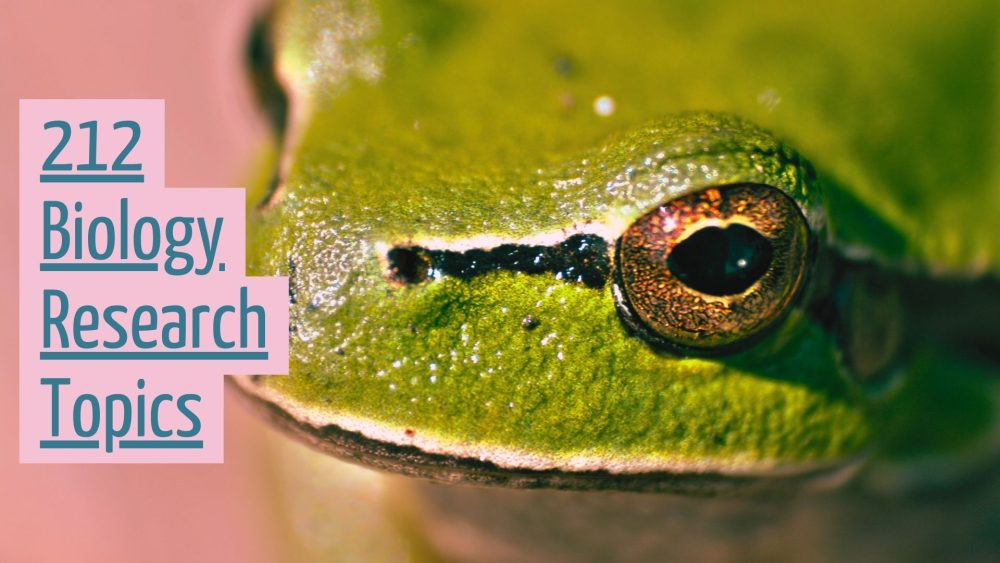
Every student studying something related to biology — botany, marine, animal, medicine, molecular or physical biology, is in an interesting field. It’s a subject that explores how animate and inanimate objects relate to themselves. The field unveils the past, the present, and what lies in the future of the relationship between the living and nonliving things.
This is precisely why you need custom and quality biology topics for your college and university essay or project. It’ll make it easy to brainstorm, research, and get to writing straight away. Before the deep dive, what is biology?
What Is Biology?
Everyone knows it’s the scientific study of life, but beyond that, biology facilitates the comprehension of living and nonliving things. It’s a branch that explores their anatomy, behavior, distribution, morphology, and physiology.
For example, it understands how genes are classified and constituted into generations. It encompasses various branches, including botany, medicine, genetics, ecology, marine biology, zoology, and molecular biology.
Here are what some of these mean:
Botany: This study of plants examines their structure, physiology, ecology, economic importance, and distribution, among others. It also deals with their biochemical processes, properties, and social interactions between plants. It extends to how plants are vital for human life, survival, and growth and how they play a significant role in stabilizing environmental health. Zoology: Zoology studies animal behavior, brain, structure, physiology, class, and distribution. It’s the general study of the lives of both living and extinct animals. It explains animal classification, the animal kingdom, evolution, habitat, embryology, and life span. Physiology: Physiology deals with the daily functions of the human body: How it works and the factors that make it work. It examines molecular behavior, the chemistry and physics behind locomotion, and how the cells in the living organisms’ body function. It helps understand how humans and animals get sick and what can be done to alleviate pain. Microbiology: Dealing with microorganisms, it examined how viruses, algae, fungi, bacteria, protozoa, and slime molds become parts of human life. They’re regarded as microbes, which play substantial roles in the human biochemical processes, including climate change, biodegradation, biodeterioration, food spoilage, biotech, and epidemiology. Marine Biology: This is the scientific study of organs in the sea. It understands their family classification, how they survive, and what makes wild marine animals different from domesticated and consumable ones. It also explores their interaction with the environment through several processes. The marine biologist studies marines in their natural environment, collects data on their characteristics, human impact on their living, and how they relate with themselves.
Now that you know all these, here are some custom biology topics to research for your university or college essay and paper.
Controversial Biology Topics
There are many controversial subjects in every field, and biology isn’t exempt from controversy. If you’d like to create an original essay through diverse opinions, here are biology topics for you:
- What are your thoughts on the post-Roe V Wade world?
- How can the post-Roe V Wade policy affect developing countries looking up to America for their laws?
- Abortion and feminism: discuss
- Does saving life justify cloning?
- Explain the principle of abortion in medical practice
- The effects of cloning in medicine
- How does genetics contribute to obesity?
- Explain why a parent could have Hepatitis B virus and only one of five offspring have the virus
- Is homosexuality really in the gene?
- How does depression correlate with genetics?
- Additives and how they affect the genes
- Examine how genetic mutations work
- Discuss the grounds that you could prove for legalizing human cloning
- Which is more immoral: Human or animal cloning?
- How is nanotechnology different from biotechnology?
- Discuss the manifestation of nanotechnology in science
- Explain three instances where public opinion has held back scientific inventions
- How does transgenic crop work?
- Would you say genetically modified food is safe for consumption?
- Explain why sexual abuse leads to trauma.
Biology Research Paper Topics
You’d need to write an extensive paper on biology one day. This could be when you’re in your final year in college or the university or submitting to a competition. You’d need Biology topics to research for brainstorming, and here are 30 of them:
- Stem cells and tissue formation processes
- Why are there different congenital disabilities?
- Mixtures in anticancer drugs?
- What are the complexities of existing HIV drugs?
- What is the contribution of chemotherapy to cancer?
- Examine the chemotherapy process and why it doesn’t work for some patients.
- Explain the origin of developmental diseases
- How do germs affect the cells?
- What are the consequences of the sun on the white person’s and black person’s skin?
- Why are some diseases treatable through drugs while some are not?
- Scientific lessons learned from COVID-19 and ideas to tackle the next virus
- If animals are carriers of the virus, what should be done to them?
- Examine five animals in extinction and what led to it
- Discuss the subject of endangered species and why people should care
- Is a plant-based diet sustainable for human health?
- Account for the consequence of living on Mars on human health
- Discuss the inconveniences involved in space travel
- How does space flight contribute to environmental disasters
- Discuss the emergence of leukemia
- Explain how the immune systems in humans work
- Evaluate the factors that weaken the immunological system
- What would you consider the deadliest virus?
- Autoimmune: what is it, origin and consequences
- Immune disorder: origin and how it affects the body
- Does stress affect the ability to have sex?
- Contribution of vaccine to eradicating disease: Discuss
- What are the complexities in taking the Hepatitis B vaccine while being positive?
- Allergies: why do humans have them?
- DNA modification: how does it work?
- Explain the misconceptions about the COVID-19 vaccines.
Interesting Biology Topics
Biology doesn’t have to be boring. Different aspects of biology could be fun to explore, especially if you’ve had a flair for the study since your elementary school classes.
You can either write an essay or paper with the following interesting biology research topics:
- Human emotions and conflicts with their intellectual intelligence
- Emotions: Its influence on art and music and how the perception of art influences the world
- The consequences of marijuana and alcohol on teenagers
- Compare and contrast how alcohol affects teenagers and adults
- Discuss the contributions of neuroscience to the subject of emotional pain
- Explain how the brain process speech
- Discuss the factors that cause autism
- Explain what is meant when people say humans are animals
- Why do scientists say humans are pessimists?
- Factors contributing to the dopamine levels human experience
- How does isolation affect the human brain?
- What factors contribute to instinctive responses?
- Noise pollution: how it affects living organisms
- Fire ecology: The contributions of plants to fire outbreak
- Explain the science behind how hot temperature, soil, and dry grass start a fire
- Microbes: what do you understand by bioremediation?
- Explain urban ecology and the challenges it pokes to solve
- Discuss how excessive internet usage affects the human memory
- Evaluate how conservation biology contributes to the extinction prevention efforts
- Discuss the role of satellites and drones in understanding the natural world
- Why do we need space travel and studies?
- Explain the limitations of limnology studies
- What are infectious-disease-causing agents all about?
- Discuss what epigenetics studies encompass
- Why is cancer research essential to the world?
- Discuss climate change: Governments are not interested, and there is no alternative
- How is behavioral science studies a core part of the understanding of the world?
- Discuss the issues with genetic engineering and why it’s a challenge
- Evaluate the strengths and weaknesses in the arguments for a plant-based diet
- Create a survey amongst students of biology asking why they chose to study the course.
Biology Research Topics For College Students
If you find any of the above beyond your intellectual and Research capacity, here are some topics you can handle. You can use these for your essays, projects, quizzes, or competitions.
These custom yet popular biology research topics will examine famous personalities and other discourse in biology:
- Effects of the human hormone on the mind
- Why do men get erect even when they’re absentminded?
- How does women’s arousal work?
- How can melatonin be valuable for therapy?
- Risky behavior: Hormones responsible for the risk
- Stem and cloning: what is the latest research on the subject?
- Hormones: changes in pregnancy
- Why do pregnant women have an appetite for random and remote things?
- The role of physical activities in hormone development
- Examine the benefits and threats of transgenic crops
- The fight against COVID-19: assess current successes
- The fight against smallpox: assess current successes
- The fight against HIV: history, trends, and present research
- Discuss the future of prosthetic appliances
- Examine the research and the future of mind-controlled limbs
- What does cosmetic surgery mean, and why is it needed?
- Analyze the meaning and process of vascular surgery
- Discuss the debate around changes in genital organs for males and females in transgender bodies
- How do donors and organ transplants work?
- Account for the work of Dr. Malcom E Miller
- Discuss the contribution of Charles Darwin to human evolution
- Explain the trends in biomedicine
- Discuss the functions of x-rays in botany
- Assess the most efficient systems for wildlife preservation
- Examine how poverty contributes to climate hazards
- Discuss the process involved in plant metabolism
- The transformation of energy into a living thing: discuss
- Prevention for sexually transmitted disease: What are the misconceptions?
- Analyze how the human body reacts to poison
- Russian Poisoning: What are the lessons scientists must learn?
- COVID-19: Discuss the efforts by two or three governments to prevent the spread
- Discuss the contributions of Pfizer during the pandemic.
Marine Biology Research Topics
This subject explains orgasms in the sea, how they survive, and their interaction with their environment. If you have a flair for this field, the following Biology research topics may interest you:
- Discuss what quantitative ecology through modeling means
- Smallest diatoms and marine logistics: discuss
- How is the shark studied?
- Acidification of seas: Causes and consequences
- Discuss the concept of the immortality of Jellyfishes
- Discuss the differences between seawater and freshwater in marine study
- Account for some of the oldest marine species
- Discuss the evolution of the deep sea
- Explain whales’ communication techniques
- What does plankton ecology encompass?
- The importance of coral reefs to seawater
- Challenges that encompass geological oceanography
- How tourism affects natural animal habitat
- Discuss some instances of the domestication of wild marine animals
- Coastal zone: pros and cons of living in such areas
- How do sharks perceive enemies?
- Analyze why some animals can live in water but can’t live on land
- Explain how plants survive in the sea
- Compare and contrast the different two species of animals in the water
- How can marine energy be generated, stored, and used?
Molecular Biology Research Topics
Focusing on the construct of cells and analysis of their composition, it understands the alteration and maintenance of cellular processes. If you’d like to focus on molecular biology, here are 15 good biology research topics for you:
- Ethical considerations in molecular genetics
- Discuss the structure and component of the gene
- Examine the restrictions in DNA
- What are the peculiarities in modern nucleic acid analysis
- What goes into the Pharmaceutical production of drugs
- Evaluate the building blocks of life
- Discuss the systems of RNA translation to protein
- PCR: How DNA is tested and analyzed
- Why is prion disease so dangerous?
- Compare and contrast recessive genes vs. dominant genes
- Can there be damage to the human DNA, and can it be repaired?
- Constraints in the research of microarray data analysis
- Protein purification: How it evolves
- Objectives of nucleic acid
- Explain the structure of a prion.
Biology Research Topics For High School
Your teachers and professors will be awed if you create impeccable essays for your next report. You need to secure the best grades as you move closer to graduation, and brainstorming any of these popular biology research topics will help:
- Identify the most endangered species
- The challenges to animal extinction
- What are the things everyone should know about sea life?
- Discuss the history of genetics
- Explain the biological theory of Charles Darwin
- How did the lockdown affect social interaction?
- Why do some people refuse the vaccine?
- Origin of genetics
- What is animal hunting, and why is it fashionable
- Explain the evolution of a virus
- Role of lockdown in preventing deaths and illnesses
- Invasive species: What does it mean?
- Endangered animals: How do they survive in the face of their hazards?
- Lockdown and their role in reducing coronavirus transmission
- Vaccine distribution: Ideas for global distribution
- Why can viruses become less virulent?
- Discuss the evolution of the world
- Explain the evolution of the planet
- Explain what Elon Musk means when he says life on Mars is possible
- What does herd immunity mean?
- Flu: why is there a low incidence in 2020?
- Relationship between archaeology and biology
- Antiviral drug: What it means
- Factors leading to the evolution of humans
- Give instances of what natural selection means
- What is considered the dead branches of evolution
- Whale hunting: What it means and the present trends
- Who is Stephen Jay, and what is his role in paleontology?
- Origin of diseases: why must humans fall sick?
- Why are humans called higher animals?
Human Biology Research Topics
Human biology understands humans and their relationship between themselves and their environment. It also studies how the body works and the impediments to health. Here are some easy biology research topics to explore on the subject:
- How do gut bacteria affect the brain?
- What are the ethical concerns around organ transplants?
- The consequence of alcohol on the liver
- The consequences of extreme salt on the human body
- Why do humans need to deworm regularly?
- The relationship between obesity and genetics
- Genetically modified foods: Why are they needed?
- How sun exposure affects human skin
- Latest trends: Depression is hereditary
- Influence of music on the human brain
- What are the stages of lung cancer
- Forensic DNA: latest trends
- How visual consumptions affect how humans think
- What is the process that leads to pregnancy?
- Explain the role of nanotechnology in HIV research
- Discuss any experiment with stem cells you know about
- Explain how humans consume food
- Discuss the process of metabolism as well as its criticality to human health
- Explore the consistent challenges technology poses to human health
- Explain the process of body decay to a skeleton.
Cell Biology Research Topics
There are many evolutionary biology research paper topics formed not by the nomenclature but for what they stand for. Cell biology is one of the most complex branches of the field.
It examines minor units and the living organisms that make them up. The focus is on the relationship between the cytoplasm, membrane, and parts of the cell. Here are some topics to explore for your scientific dissertation writing :
- How does chromatin engage in the alterations of gene expression?
- What are the usual cell infections, and why does the body have immunity defections?
- Identify and account for the heritage of Robert Brown in his core career focus
- Explain the structure of the animal cell and why It’s what it is
- Identify the cells in the human body as well as their functions
- Explain a scenario and justify the context of animals photosynthesizing like plants
- Why do bacteria invade the body, and how do they do it?
- Why are mitochondria considered the powerhouse of the cell
- Use the molecular analysis tool to explain multicellular organisms
- Examine how the White blood cells fight disease
- What do you understand about the role of cell biology in the treatment of Alzheimer’s Disease
- What are the latest research methods in cell biology?
- Identify the characteristics of viruses and why they threaten human existence.
- Discuss the differences between DNA and RNA
- What part of the body is responsible for human functionality for as long as the individual wants?
Get Biology Research Help As Soon As Possible
Creating the best essays or papers is easier now that you have custom biology research topics. However, you may still need support writing your paper beyond these topic ideas. After all, the first stage of writing like experts is brainstorming ideas and researching which is most feasible to write about.
If you truly want to wow your professor or teacher but can’t afford to dedicate all the required time, here’s an alternative. You can hire writing helpers online for quality papers at a cheap price, and we can help with that. We are a team of writers with many years of writing experience for students in Europe and North America. You can even buy thesis online with us, as well as editing services.
Each paper is assigned to writers with expertise in a specific field. This enables them to provide in-depth analysis as your assignment requires. We’re based online, which means you won’t have issues with accessibility and availability. Just tell us what you need, and we will get it done.

Leave a Reply Cancel reply
Your email address will not be published. Required fields are marked *
Comment * Error message
Name * Error message
Email * Error message
Save my name, email, and website in this browser for the next time I comment.
As Putin continues killing civilians, bombing kindergartens, and threatening WWIII, Ukraine fights for the world's peaceful future.
Ukraine Live Updates
150 Actual Biology Research Paper Topics
Table of contents
- 1 What Is Biology? What Topics Might Biologists Study?
- 2 How to Choose a Topic for Biology Research Paper?
- 3.1 15 Developmental Biology Topics For Research
- 3.2 15 Immune System Biology Research Topics
- 3.3 15 Cell Biology Research Topics
- 3.4 15 DNA Research Topics
- 3.5 15 Molecular Biology Research Topics
- 3.6 15 Neurobiology Research Topics
- 3.7 15 Abortion, Human cloning, and Genetic Researches Topics
- 3.8 15 Environmental and Ecology Topics for Your Research
- 3.9 15 Plant Pathology Biology Research Topics
- 3.10 15 Animals Biology Research Topics
- 3.11 15 Marine Biology Research Topics
- 3.12 15 Zoology Research Topics
- 3.13 15 Genetics Research Topics
- 3.14 15 Biotechnology Research Topics
- 3.15 15 Evolutionary Biology Research Topics
Biology is one of the most magnetic fields of study these days. If you want to be a biologist or scientist in the future, there is no better time to start than right now. Biology research topics covered in this article will keep you busy and interested. Writing a research paper is one of the best ways to dip your toes into the field. Before doing that, you need to know some good topics for the research paper . They should be suitable for biology students rather than cutting-edge researchers. On Papersowl.com , we provide as many biology research paper examples as possible so that you have a huge choice.
What Is Biology? What Topics Might Biologists Study?
Biology is simply the study of everything that has a form of life. It includes investigations on plants, animals, and everything found in the environment. It is about studying how life forms grow, develop, and interact with each other. Biology essay topics for research encompass all these and more.
This science uncovers many fields where various life forms are studied. It makes sense to look through these fields to help you decide which suits you the best.
Plant Biology research topics are about studying the plants around us. They disclose information about their existence as a part of the ecosystem, their life cycle, resources they can give us, their ability to preserve them from climate changes, and so on. There are many ideas to choose from, but you must focus on a specific one.
Human Biology research topics are all about us. These topics focus on different body parts, such as the human brain, the human immunological system, the nervous system, etc. In addition, you can discuss DNA modifications in humans and explain why genetic disorders occur in your research projects. Various cell research is also common today.
Biology research topics on the environment are in great demand too. For example, climate change is becoming a more significant threat every day. By studying environmental topics in biology for projects and research, we can come up with ways to combat them and preserve ecosystems.
Microbiology research topics delve into things we can’t see. There are trillions of microbes and bacteria all around us. Knowing about them is essential to understanding what makes us sick and how to fight against them. All microbiology research paper topics are pretty complicated yet very engaging to include in your paper research.
Molecular biology topics dive even deeper into the level of atoms and molecules. The various medicines and drugs we take were all created through molecular-biology research. It is one of the areas full of ideas, but there is yet to be much evidence. Science is advancing in this realm but still needs a lot of time. Topics of molecular biology will need days for research only.
Keep in mind that there are more ideas and variations of this science. We offer more examples in further sections of the article about developmental biology, marine biology, evolutionary biology, etc. Explore them and make your writing appealing and meaningful in the eyes of a professor.
How to Choose a Topic for Biology Research Paper?
When choosing a biology project topic, you must be aware of one or more fields of science. Biology research is critical to the present world. By doing research, we can learn more about genetic disorders, immune disorders, mental health, natural disease resistance, etc. Knowing about each of these could save lives in the future.
For those who may not have the time or resources to do their own research, there are research paper writing services that can provide assistance with the project. And we are always here to help you find your own topic among interesting biology research topics. Here we prepared some useful tips to follow.
- Tip 1: The level of interest matters Pay attention to one that interests you, and you might have ideas on how to develop the topic. Passion is fundamental in research, after all.
- Tip 2: Explore the topic Try to narrow things down a bit. If the topic is too broad, you may not be able to cover all aspects of it in one research paper. If it is too narrow, the paper could end up too short. Analyze the topic and the ways to approach it. By doing so, you can strike a balance between the two.
- Tip 3: Discover the recent developments To make your research paper touchable with the present day, you must explore the latest developments in the field. You can find out what kind of research has been done recently by looking at journals. Check out research papers, topics, research articles, and other sources.
- Tip 4: Ensure to get enough resources When choosing a topic, make sure it has plenty of resources available. For example, a research paper on xenobiology or cutting-edge nanobiology might sound attractive. Still, you might have difficulties getting data and resources for those unless you are a researcher at a government lab. Data, resources, complex numbers, and statistics are all invaluable to writing a paper about these topics.
That is why we have selected a range of biological topics. The topics on this list are all hopefully exciting topics for research you could write an excellent paper on. We should also add that easy biology topics to research are rare, and a writer usually needs days to prepare and start writing. Yes, biology research topics for high school students are a bit easier, but still, they need time to explore them.
On the other hand, biology research topics for college students are far more complex and detailed. Some people prefer evolutionary biology research paper topics, and we can agree with this claim. These research areas do have a lot of potential and a lot of data to support the claims. Others prefer cell biology research topics that are a bit specific and fun. Anyway, with this article’s list of easy biology research topics, you will surely find the one matching your interest.
For those who may not have the time or resources to do their own research, there are provide assistance with the project.

Top Research Biology Paper Topics
This section contains a large selection of research biology paper topics. You will be able to find one that will suit you the best. The only thing left is to decide what variation of science you prefer. Whether you’re interested in microbiology, genetics, or any other type of science, you’ll find a topic to get you started. If you’re ever stuck or need some extra help, you can always pay someone to write your paper for you. So, take a look, and choose the perfect topic for your project!
15 Developmental Biology Topics For Research
Exploring the processes of how cells grow and develop is exciting. The human body contains millions of cells, and it’s interesting to research their behavior under different conditions. If you feel like writing about it, you can find some interesting biology topics below.
- How do stem cells form different tissues?
- How are tumors formed?
- Duplication of genomes
- Plasticity of development
- Different birth defects
- Interactions between genes and the environment
- Anticancer drugs mixtures
- Developmental diseases: Origin
- Drosophila Oogenesis
- Most deadly viruses
- Most deadly bacteria in the world
- How do germs affect cells?
- How does leukemia start?
- Development of the cardiovascular system in children
- How do autoimmune diseases start and affect the human body?
15 Immune System Biology Research Topics
For decades, many scientists and immunologists have studied the human immune system and tried to explain its reaction to various pathogens. This area allows you to deepen into it and reveal how a body protects itself from harmful impact. Look over the biology research questions below and find your match-up.
- How does the human body’s immune system work?
- The human immune system: How to strengthen it?
- What makes the immunological system weaker?
- The notion of auto-immune diseases and their effect on the body’s immune system
- The global HIV/aids epidemic
- What methods are used to prevent the spread of hives?
- Living with auto-immune diseases
- Genetics and the immune system: effects and consequences
- How do immune disorders affect the body, and what causes them?
- Are allergies signs of worrying about an immune disorder?
- DNA modification in solving immune disorders
- Stress as the biggest ruiner of the immunological system
- Vaccines as strong supporters of the immunological system
- The perception of vaccines in society
- Why do some people refuse vaccines and put others around them in danger?
15 Cell Biology Research Topics
Cell study might seem challenging yet very engaging. It will be a good idea to compare various types of cells and compare them in animals and plants. Make your choice from the list of cell biology research topics below.
- The structure of an animal cell
- Mitochondria and its meaning in cell development
- Cells classification and their functions
- Red blood cells and their function in transporting oxygen
- White blood cells and their responsibility to fight diseases
- How are plant cells different from animal cells?
- What would it be if animals had a function to photosynthesize?
- Single-celled organisms: What is it, and how do they work?
- What processes do cells go through in division?
- Invasion of bacteria into the body
- Viruses – alive or not?
- Fungi: their reproduction and distribution
- Cancer cells: Why are they so dangerous?
- What methods are used to kill cancer cells?
- The role of stem cells and their potential in a body

15 DNA Research Topics
The variety of biology research topics for college students might impress you a lot. This is a science with a large field of investigation, disclosing much scientific information to use in your project. The notion of DNA and its gist are also excellent options to write about.
- The structure of the human DNA
- The main components of a DNA chain
- Why does DNA have a double-helix spiral structure?
- The purpose of chromosomes
- MRNA and its relation to DNA
- Do single-celled organisms have DNA?
- Do viruses have DNA?
- What happens if you have too many or too few chromosomes?
- Analyzing the structure of DNA using computers
- Uses for the DNA of extinct organisms like mammoths and dinosaurs
- Storing non-genetic information in DNA
- Can you write a computer program into human DNA?
- How does radiation affect DNA?
- Modifying DNA to treat aids
- Can we fight cancer through DNA modification?
15 Molecular Biology Research Topics
Do you prefer to research molecules’ chemical and physical composition? We gathered some molecular biology research topics to make your choice easier.
- The structure and components of a gene
- How do molecules move in and out of a cell?
- The basic building blocks of life
- How are drugs designed for humans?
- How is a vaccine designed to target a specific disease?
- Dominant genes vs. recessive genes
- Prion disease – why is it so dangerous?
- Hormones and their function in the body
- Developing artificial hormones from other animals
- How to carry out a western blot?
- Testing and analyzing DNA using PCR
- The three-dimensional structure of a molecule
- What is DNA transcription, and how is it used?
- The structure of a prion
- What is the central dogma of molecular biology?
15 Neurobiology Research Topics
The more you dive into science, the more exciting things you find. That’s about biology. Here, you can choose biology research topics for high school and try to reveal more simply.
- Nervous system: its structure and function
- Neurons as unique cells playing a central role in the nervous system
- What is the maximum reaction speed in a human?
- Reaction speed: how to improve it?
- Research on Organic Farming
- What are the symptoms of Alzheimer’s disease?
- Why do we feel happy or sad?
- Headaches in terms of Neurobiology
- What are the reasons for neurobiological degeneration?
- Myths and reality of Amnesia
- What causes Alzheimer’s Disease, and what are the consequences of the disease?
- What is the treatment for Spinal Cord Injury?
- Studies on Narcolepsy and Insomnia: What are the causes?
- Is there a connection between Mental Health and Neurobiology?
- Emotions in terms of their reflection in the brain
15 Abortion, Human cloning, and Genetic Researches Topics
There are so many scientific researches and theories that society accepts or neglects. You can operate different notions and try to explain them, reflecting their advantages and downsides for a human being. We gathered some enticing life science research topics for high school students that might interest you.
- The controversy around abortion: legal or not?
- Can abortion be safe?
- Human cloning – reality vs. science-fiction
- The goals of cloning humans
- Are human cloning and transplantation ethical?
- Having a “perfect child” through gene therapy: Is it a myth?
- How far has gene therapy gone in genetic research?
- Advantages and disadvantages of gene therapy
- How gene therapy can help beat cancer
- How gene therapy can eliminate diabetes
- The opportunity to edit genes by CRISPR
- DNA modifications in humans to enhance our abilities – an ethical dilemma
- Will expensive gene therapy widen the gap between the rich and the poor?
- Cloning: the good and the Bad for a Generation
- The disadvantages of cloning
- Free unlimited checks
- All common file formats
- Accurate results
- Intuitive interface
15 Environmental and Ecology Topics for Your Research
The nature around us is so enormous and includes many branches to investigate. If you are keen on the environment and how ecology affects it, the list of follow-up biology paper topics might be helpful to you.
- The theory of evolution
- How does natural selection work?
- How do living organisms adapt to their environment?
- The concept of divergent and convergent evolution
- Building a sustainable environment
- Development of environment-friendly cities
- How to control population growth?
- Why have recycling resources become so essential in the modern world?
- The effect of plastic on the environment
- What are the global consequences of deforestation?
- What can we expect when losing biodiversity?
- Ecological damage: How to prevent it?
- How can GMO products affect ecology?
- Cloning endangered or extinct species: Is it a good idea?
- Is climate change the main reason for disrupting ecology?
15 Plant Pathology Biology Research Topics
Many factors impact human health and the quality of food products matters. These easy biology research topics will be useful if you want to describe the connection between those two concepts.
- How do plants protect themselves from diseases?
- How to increase the plant’s resistance to diseases?
- Diseases distribution among plants
- The banana pandemic
- How do herbicides influence plants?
- Corn blight
- Can any plant diseases affect humans?
- The issue of stem rust and its impact on wheat
- What approaches are used to struggle against invasive plants and affected weeds?
- Fertilizers: their pros and cons on plants
- Plant disease genetics: its system and structure
- What is the connection between ecological changes and plant diseases?
- Modifications on food production because of plant diseases
- How do fungal and viral diseases appear in plants?
- The sweet potato virus
15 Animals Biology Research Topics
It’s hard to find someone who doesn’t like animals. If you are curious about animals scientifically, here you are with biology research paper topics in this field.
- Classification of animals
- Land-based life: its evolution history
- Controversies about keeping animals as pets
- Is it ethical to test drugs and products on animals?
- Why do nature reserves against zoos?
- Evidence on prehistoric aquatic animals growing giant
- What species of animals are vegan?
- Animals and their social behavior
- Primate behavior
- How intelligent can other primates be?
- Are wolves and dogs intelligent?
- Domesticating animals
- Hibernation in animals
- Why animals migrate
- Should we bring back extinct animals?

15 Marine Biology Research Topics
The marine theme is engaging as it reveals so many interesting facts about life forms dwelling under the water. You can make your paper look captivating using biology topics in marine below.
- How acidification affects aquatic environments
- Evolution in the deep sea
- What’s the meaning of camouflage mechanism in sea life?
- Consequences of oil spills on marine life
- Oldest marine species
- How do whales communicate with each other?
- How blind fish navigate
- Are marine shows and aquariums ethical?
- The biology and life cycle of seabirds
- How jellyfish are immortal
- Plankton ecology
- Difference between freshwater and seawater marine life
- Coral reefs: their importance and evolution
- Saving and restoring coral reefs
- Life in the deep-sea ocean trenches
15 Zoology Research Topics
Zoology can be an excellent choice to write about if you are close to animal studies. Look at biology topics to research and choose the one that fits your interest most.
- Asian elephants and human speech patterns
- Oyster genomes and adaptation
- Darwin’s work in the Galápagos Islands
- Asian carp: Invasive species analysis
- Giant squids: Fact vs. fiction
- Coyote and wolf hybrid species in the United States
- Parasites and disease
- Migration patterns of killer bees
- The treatment of species in Melville’s Moby Dick
- Biodiversity and plankton
- The role of camels and the development of Africa and the Middle East
- Muskellunge and adaptive creek mechanisms to small water
- Ants and cooperative behavior among species
- Animal communication and the origin of language
- Speech in African Gray Parrots
15 Genetics Research Topics
Writing about modifications caused on the gene level is pretty challenging but very fascinating. You can select one among the biological questions for research and bring up a meaningful paper.
- Genetics and its role in cancer studies
- Can genetic code be confidential?
- Is it possible to choose the sex of a person before birth?
- Genetics as a ray of hope for children with an intellectual disability
- What factors in human genetics affect behavior?
- Is it somehow possible to improve human personality through genetics?
- Are there any living cells in the gene?
- Fighting HIV with gene mutations
- Genetic mutations
- How addictive substances affect genes
- Genetic testing: is it necessary?
- Cloning: positive or negative outcome for future generations
- Pros and cons of genetic engineering
- Is the world ready for the bioethics revolution?
- The linkage between genetics and obesity
15 Biotechnology Research Topics
The way scientists conduct research today is magnificent. Implementing high-tech innovations in biology research brings new opportunities to study the world. What are these opportunities? Explore biotechnology research topics for college students and disclose the best options for you.
- Biotechnology used in plant research
- What is the contribution of biotechnology to food?
- Pharmacogenetics: What is it, and how it works?
- How are anti-cancer drugs produced to be effective?
- Nanotechnology in DNA: How to isolate it?
- Recent nanotechnology used in HIV treatment
- What biotech apps are used to detect foodborne pathogens in food systems?
- Genotypes research: Why are they tolerant and sensitive to heavy metal?
- High-tech solutions in diagnosing cancer
- Forensic DNA and its latest developments
- Metabolic changes at the level of cells
- Nanotechnology in improving treatments for respiratory viruses
- The latest biotech discoveries
- Digital evolution: bioresearch and its transformation
- The concept of vaccine development

15 Evolutionary Biology Research Topics
Knowing how life forms started their existence is fundamental. And more interesting is to look through the evolution of many processes. If you find this trend of research more engaging, we outlined evolutionary biology research paper topics to diversify your choice.
- Darwin’s concept’s impact on science
- The evolution concept by Lamarck
- Origins of the evolutionary theory
- Evolution acceptance: a belief vs. a theory?
- Evolutionary in microbiology
- Development of robotics
- Revealing differences: human brain & animal brain
- Preservation of biological resources
- Transformations in aging
- Adaptive genetic system
- Morphometrics’ history
- Developmental theory and population genomics
- Bacteria ecology’s evolution
- Biological changes: impact and evolution
- Infectious diseases and their profession
The world of science and biology is vast, making research tedious. Use our list of interesting biology research topics to choose the best issue to write your own paper.
However, it is still hard to prepare a high-quality biology research paper, even with a brilliant topic. Not all college students can do it. Do you feel like you need some help? Then buy biology paper from our professional writers! Our experts will choose the best biology experimental research topics for you and can bring up top-level papers within the shortest time. Additionally, if you need help with a statistics project related to biology, our team of experienced professionals is equipped to provide you with the utmost quality of research and analysis.
Readers also enjoyed

WHY WAIT? PLACE AN ORDER RIGHT NOW!
Just fill out the form, press the button, and have no worries!
We use cookies to give you the best experience possible. By continuing we’ll assume you board with our cookie policy.
BIOLOGICAL SCIENCES MAJOR
Senior thesis examples.
Graduating seniors in Biological Sciences have the option of submitting a senior thesis for consideration for Honors and Research Prizes . Below are some examples of particularly outstanding theses from recent years (pdf):
Sledd Thesis
Thank you for visiting nature.com. You are using a browser version with limited support for CSS. To obtain the best experience, we recommend you use a more up to date browser (or turn off compatibility mode in Internet Explorer). In the meantime, to ensure continued support, we are displaying the site without styles and JavaScript.
- View all journals
- Explore content
- About the journal
- Publish with us
- Sign up for alerts
Collection 12 March 2020
Top 50 Life and Biological Sciences Articles
We are pleased to share with you the 50 most read Nature Communications articles* in life and biological sciences published in 2019. Featuring authors from around the world, these papers highlight valuable research from an international community.
Browse all Top 50 subject area collections here .
*Based on data from Google Analytics, covering January-December 2019 (data has been normalised to account for articles published later in the year)

Genome-wide analysis identifies molecular systems and 149 genetic loci associated with income
Household income is used as a marker of socioeconomic position, a trait that is associated with better physical and mental health. Here, Hill et al. report a genome-wide association study for household income in the UK and explore its relationship with intelligence in post-GWAS analyses including Mendelian randomization.
- W. David Hill
- Neil M. Davies
- Ian J. Deary
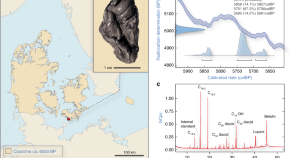
A 5700 year-old human genome and oral microbiome from chewed birch pitch
Birch pitch is thought to have been used in prehistoric times as hafting material or antiseptic and tooth imprints suggest that it was chewed. Here, the authors report a 5,700 year-old piece of chewed birch pitch from Denmark from which they successfully recovered a complete ancient human genome and oral microbiome DNA.
- Theis Z. T. Jensen
- Jonas Niemann
- Hannes Schroeder
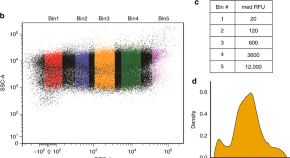
A short translational ramp determines the efficiency of protein synthesis
Several factors contribute to the efficiency of protein expression. Here the authors show that the identity of amino acids encoded by codons at position 3–5 significantly impact translation efficiency and protein expression levels.
- Manasvi Verma
- Junhong Choi
- Sergej Djuranovic
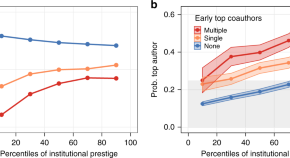
Early coauthorship with top scientists predicts success in academic careers
By examining publication records of scientists from four disciplines, the authors show that coauthoring a paper with a top-cited scientist early in one's career predicts lasting increases in career success, especially for researchers affiliated with less prestigious institutions.
- Tomaso Aste
- Giacomo Livan
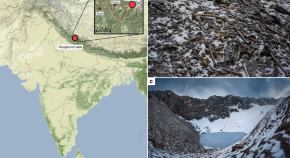
Ancient DNA from the skeletons of Roopkund Lake reveals Mediterranean migrants in India
Remains of several hundred humans are scattered around Roopkund Lake, situated over 5,000 meters above sea level in the Himalayan Mountains. Here the authors analyze genome-wide data from 38 skeletons and find 3 clusters with different ancestries and dates, showing the people were desposited in multiple catastrophic events.
- Éadaoin Harney
- Ayushi Nayak
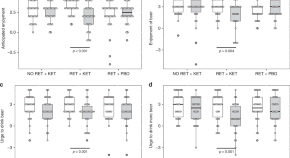
Ketamine can reduce harmful drinking by pharmacologically rewriting drinking memories
Memories linking environmental cues to alcohol reward are involved in the development and maintenance of heavy drinking. Here, the authors show that a single dose of ketamine, given after retrieval of alcohol-reward memories, disrupts the reconsolidation of these memories and reduces drinking in humans.
- Ravi K. Das
- Sunjeev K. Kamboj
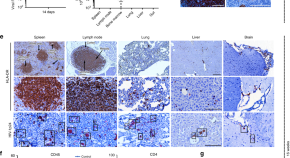
Sequential LASER ART and CRISPR Treatments Eliminate HIV-1 in a Subset of Infected Humanized Mice
Here, the authors show that sequential treatment with long-acting slow-effective release ART and AAV9- based delivery of CRISPR-Cas9 results in undetectable levels of virus and integrated DNA in a subset of humanized HIV-1 infected mice. This proof-of-concept study suggests that HIV-1 elimination is possible.
- Prasanta K. Dash
- Rafal Kaminski
- Howard E. Gendelman
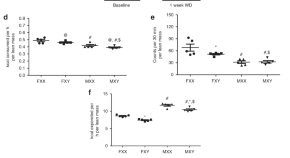
XX sex chromosome complement promotes atherosclerosis in mice
Men and women differ in their risk of developing coronary artery disease, in part due to differences in their levels of sex hormones. Here, AlSiraj et al. show that the XX sex genotype regulates lipid metabolism and promotes atherosclerosis independently of sex hormones in mice.
- Yasir AlSiraj
- Lisa A. Cassis
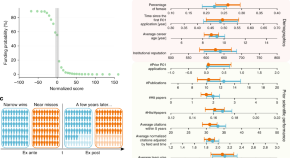
Early-career setback and future career impact
Little is known about the long-term effects of early-career setback. Here, the authors compare junior scientists who were awarded a NIH grant to those with similar track records, who were not, and find that individuals with the early setback systematically performed better in the longer term.
- Benjamin F. Jones
- Dashun Wang
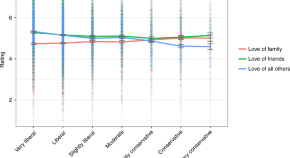
Ideological differences in the expanse of the moral circle
How do liberals and conservatives differ in their expression of compassion and moral concern? The authors show that conservatives tend to express concern toward smaller, more well-defined, and less permeable social circles, while liberals express concern toward larger, less well-defined, and more permeable social circles.
- Jesse Graham
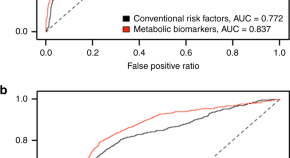
A metabolic profile of all-cause mortality risk identified in an observational study of 44,168 individuals
Biomarkers that predict mortality are of interest for clinical as well as research applications. Here, the authors analyze metabolomics data from 44,168 individuals and identify key metabolites independently associated with all-cause mortality risk.
- Joris Deelen
- Johannes Kettunen
- P. Eline Slagboom
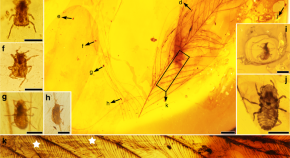
New insects feeding on dinosaur feathers in mid-Cretaceous amber
Numerous feathered dinosaurs and early birds have been discovered from the Jurassic and Cretaceous, but the early evolution of feather-feeding insects is not clear. Here, Gao et al. describe a new family of ectoparasitic insects from 10 specimens found associated with feathers in mid-Cretaceous amber.
- Taiping Gao
- Xiangchu Yin

Acoustic enrichment can enhance fish community development on degraded coral reef habitat
Healthy coral reefs have an acoustic signature known to be attractive to coral and fish larvae during settlement. Here the authors use playback experiments in the field to show that healthy reef sounds can increase recruitment of juvenile fishes to degraded coral reef habitat, suggesting that acoustic playback could be used as a reef management strategy.
- Timothy A. C. Gordon
- Andrew N. Radford
- Stephen D. Simpson
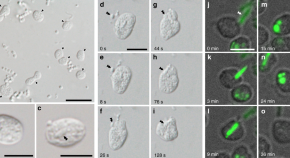
Phagocytosis-like cell engulfment by a planctomycete bacterium
Phagocytosis is a typically eukaryotic feature that could be behind the origin of eukaryotic cells. Here, the authors describe a bacterium that can engulf other bacteria and small eukaryotic cells through a phagocytosis-like mechanism.
- Takashi Shiratori
- Shigekatsu Suzuki
- Ken-ichiro Ishida
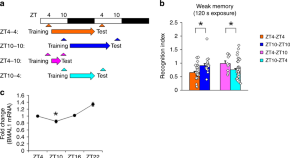
Hippocampal clock regulates memory retrieval via Dopamine and PKA-induced GluA1 phosphorylation
The neural mechanisms that lead to a relative deficit in memory retrieval in the afternoon are unclear. Here, the authors show that the circadian - dependent transcription factor BMAL1 regulates retrieval through dopamine and glutamate receptor phosphorylation.
- Shunsuke Hasegawa
- Hotaka Fukushima
- Satoshi Kida
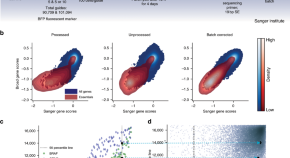
Agreement between two large pan-cancer CRISPR-Cas9 gene dependency data sets
Integrating independent large-scale pharmacogenomic screens can enable unprecedented characterization of genetic vulnerabilities in cancers. Here, the authors show that the two largest independent CRISPR-Cas9 gene-dependency screens are concordant, paving the way for joint analysis of the data sets.
- Joshua M. Dempster
- Clare Pacini
- Francesco Iorio
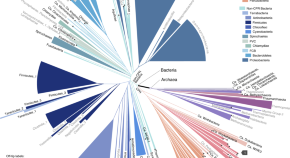
Phylogenomics of 10,575 genomes reveals evolutionary proximity between domains Bacteria and Archaea
The authors build a reference phylogeny of 10,575 evenly-sampled bacterial and archaeal genomes, based on 381 markers. The results indicate a remarkably closer evolutionary proximity between Archaea and Bacteria than previous estimates that used fewer “core” genes, such as the ribosomal proteins.
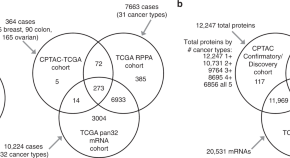
Pan-cancer molecular subtypes revealed by mass-spectrometry-based proteomic characterization of more than 500 human cancers
Mass-spectrometry-based profiling can be used to stratify tumours into molecular subtypes. Here, by classifying over 500 tumours, the authors show that this approach reveals proteomic subgroups which cut across tumour types.
- Fengju Chen
- Darshan S. Chandrashekar
- Chad J. Creighton
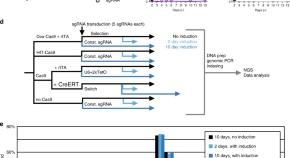
CRISPR-Switch regulates sgRNA activity by Cre recombination for sequential editing of two loci
Inducible genome editing systems often suffer from leakiness or reduced activity. Here the authors develop CRISPR-Switch, a Cre recombinase ON/OFF-controlled sgRNA cassette that allows consecutive editing of two loci.
- Krzysztof Chylinski
- Maria Hubmann
- Ulrich Elling
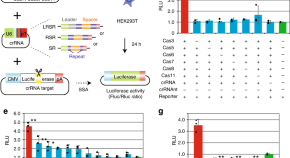
CRISPR-Cas3 induces broad and unidirectional genome editing in human cells
Class 1 CRISPR systems are not as developed for genome editing as Class 2 systems are. Here the authors show that Cas3 can be used to generate functional knockouts and knock-ins, as well as Cas3-mediated exon-skipping in DMD cells.
- Hiroyuki Morisaka
- Kazuto Yoshimi
- Tomoji Mashimo

Genetic evidence for assortative mating on alcohol consumption in the UK Biobank
From observational studies, alcohol consumption behaviours are known to be correlated in spouses. Here, Howe et al. use partners’ genotypic information in a Mendelian randomization framework and show that a SNP in the ADH1B gene associates with partner’s alcohol consumption, suggesting that alcohol consumption affects mate choice.
- Laurence J. Howe
- Daniel J. Lawson
- Gibran Hemani
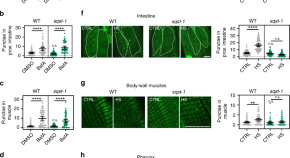
The autophagy receptor p62/SQST-1 promotes proteostasis and longevity in C. elegans by inducing autophagy
While the cellular recycling process autophagy has been linked to aging, the impact of selective autophagy on lifespan remains unclear. Here Kumsta et al. show that the autophagy receptor p62/SQSTM1 is required for hormetic benefits and p62/SQSTM1 overexpression is sufficient to extend C. elegans lifespan and improve proteostasis.
- Caroline Kumsta
- Jessica T. Chang
- Malene Hansen
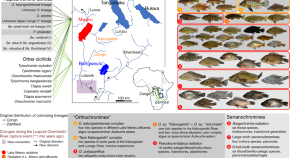
The coincidence of ecological opportunity with hybridization explains rapid adaptive radiation in Lake Mweru cichlid fishes
Recent studies have suggested that hybridization can facilitate adaptive radiations. Here, the authors show that opportunity for hybridization differentiates Lake Mweru, where cichlids radiated, and Lake Bangweulu, where cichlids did not radiate despite ecological opportunity in both lakes.
- Joana I. Meier
- Rike B. Stelkens
- Ole Seehausen
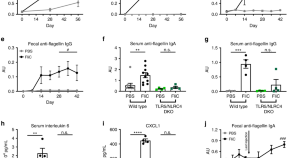
Flagellin-elicited adaptive immunity suppresses flagellated microbiota and vaccinates against chronic inflammatory diseases
Gut microbiota alterations, including enrichment of flagellated bacteria, are associated with metabolic syndrome and chronic inflammatory diseases. Here, Tran et al. show, in mice, that elicitation of mucosal anti-flagellin antibodies protects against experimental colitis and ameliorates diet-induced obesity.
- Hao Q. Tran
- Ruth E. Ley
- Benoit Chassaing
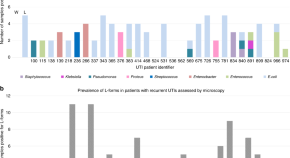
Possible role of L-form switching in recurrent urinary tract infection
The reservoir for recurrent urinary tract infection in humans is unclear. Here, Mickiewicz et al. detect cell-wall deficient (L-form) E. coli in fresh urine from patients, and show that the isolated bacteria readily switch between walled and L-form states.
- Katarzyna M. Mickiewicz
- Yoshikazu Kawai
- Jeff Errington
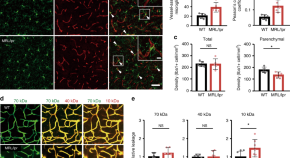
Dual microglia effects on blood brain barrier permeability induced by systemic inflammation
Although it is known that microglia respond to injury and systemic disease in the brain, it is unclear if they modulate blood–brain barrier (BBB) integrity, which is critical for regulating neuroinflammatory responses. Here authors demonstrate that microglia respond to inflammation by migrating towards and accumulating around cerebral vessels, where they initially maintain BBB integrity via expression of the tight-junction protein Claudin-5 before switching, during sustained inflammation, to phagocytically remove astrocytic end-feet resulting in impaired BBB function
- Koichiro Haruwaka
- Ako Ikegami
- Hiroaki Wake
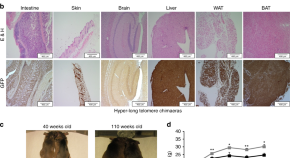
Mice with hyper-long telomeres show less metabolic aging and longer lifespans
Telomere shortening is associated with aging. Here the authors analyze mice with hyperlong telomeres and demonstrate that longer telomeres than normal have beneficial effects such as delayed metabolic aging, increased longevity and less incidence of cancer.
- Miguel A. Muñoz-Lorente
- Alba C. Cano-Martin
- Maria A. Blasco
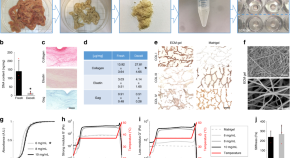
Extracellular matrix hydrogel derived from decellularized tissues enables endodermal organoid culture
Organoid cultures have been developed from multiple tissues, opening new possibilities for regenerative medicine. Here the authors demonstrate the derivation of GMP-compliant hydrogels from decellularized porcine small intestine which support formation and growth of human gastric, liver, pancreatic and small intestinal organoids.
- Giovanni Giuseppe Giobbe
- Claire Crowley
- Paolo De Coppi
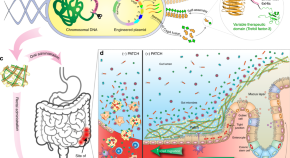
Engineered E. coli Nissle 1917 for the delivery of matrix-tethered therapeutic domains to the gut
Anti-inflammatory treatments for gastrointestinal diseases can often have detrimental side effects. Here the authors engineer E. coli Nissle 1917 to create a fibrous matrix that has a protective effect in DSS-induced colitis mice.
- Pichet Praveschotinunt
- Anna M. Duraj-Thatte
- Neel S. Joshi
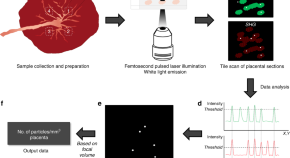
Ambient black carbon particles reach the fetal side of human placenta
Exposure to air pollution during pregnancy has been associated with impaired birth outcomes. Here, Bové et al. report evidence of black carbon particle deposition on the fetal side of human placentae, including at early stages of pregnancy, suggesting air pollution could affect birth outcome through direct effects on the fetus.
- Hannelore Bové
- Eva Bongaerts
- Tim S. Nawrot
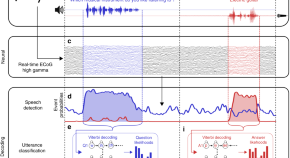
Real-time decoding of question-and-answer speech dialogue using human cortical activity
Speech neuroprosthetic devices should be capable of restoring a patient’s ability to participate in interactive dialogue. Here, the authors demonstrate that the context of a verbal exchange can be used to enhance neural decoder performance in real time.
- David A. Moses
- Matthew K. Leonard
- Edward F. Chang
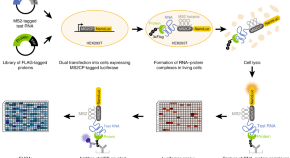
In-cell identification and measurement of RNA-protein interactions
RNA-interacting proteome can be identified by RNA affinity purification followed by mass spectrometry. Here the authors developed a different RNA-centric technology that combines high-throughput immunoprecipitation of RNA binding proteins and luciferase-based detection of their interaction with the RNA.
- Antoine Graindorge
- Inês Pinheiro
- Alena Shkumatava
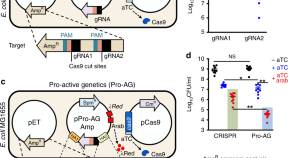
A bacterial gene-drive system efficiently edits and inactivates a high copy number antibiotic resistance locus
Genedrives bias the inheritance of alleles in diploid organisms. Here, the authors develop a gene-drive analogous system for bacteria, selectively editing and clearing plasmids.
- J. Andrés Valderrama
- Surashree S. Kulkarni
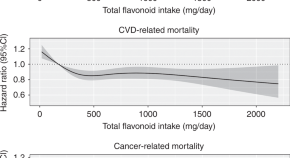
Flavonoid intake is associated with lower mortality in the Danish Diet Cancer and Health Cohort
The studies showing health benefits of flavonoids and their impact on cancer mortality are incomplete. Here, the authors perform a prospective cohort study in Danish participants and demonstrate an inverse association between regular flavonoid intake and both cardiovascular and cancer related mortality.
- Nicola P. Bondonno
- Frederik Dalgaard
- Jonathan M. Hodgson
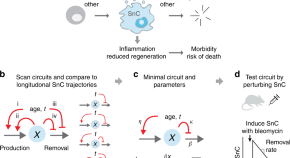
Senescent cell turnover slows with age providing an explanation for the Gompertz law
One of the underlying causes of aging is the accumulation of senescent cells, but their turnover rates and dynamics during ageing are unknown. Here the authors measure and model senescent cell production and removal and explore implications for mortality.
- Amit Agrawal
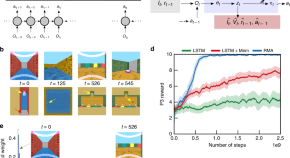
Optimizing agent behavior over long time scales by transporting value
People are able to mentally time travel to distant memories and reflect on the consequences of those past events. Here, the authors show how a mechanism that connects learning from delayed rewards with memory retrieval can enable AI agents to discover links between past events to help decide better courses of action in the future.
- Chia-Chun Hung
- Timothy Lillicrap
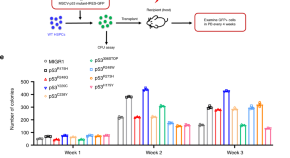
Mutant p53 drives clonal hematopoiesis through modulating epigenetic pathway
Ageing is associated with clonal hematopoiesis of indeterminate potential (CHIP), which is linked to increased risks of hematological malignancies. Here the authors uncover an epigenetic mechanism through which mutant p53 drives clonal hematopoiesis through interaction with EZH2.
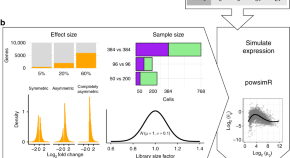
A systematic evaluation of single cell RNA-seq analysis pipelines
There has been a rapid rise in single cell RNA-seq methods and associated pipelines. Here the authors use simulated data to systematically evaluate the performance of 3000 possible pipelines to derive recommendations for data processing and analysis of different types of scRNA-seq experiments.
- Beate Vieth
- Swati Parekh
- Ines Hellmann

Cryo-EM structure and polymorphism of Aβ amyloid fibrils purified from Alzheimer’s brain tissue
Alzheimer’s disease is characterised by the deposition of Aβ amyloid fibrils and tau protein neurofibrillary tangles. Here the authors use cryo-EM to structurally characterise brain derived Aβ amyloid fibrils and find that they are polymorphic and right-hand twisted, which differs from in vitro generated Aβ fibrils.
- Marius Kollmer
- William Close
- Marcus Fändrich
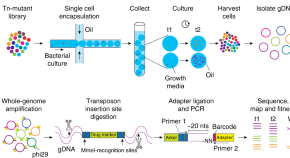
Droplet Tn-Seq combines microfluidics with Tn-Seq for identifying complex single-cell phenotypes
Culturing transposon-mutant libraries in pools can mask complex phenotypes. Here the authors present microfluidics mediated droplet Tn-Seq, which encapsulates individual mutants, promotes isolated growth and enables cell-cell interaction analyses.
- Derek Thibault
- Paul A. Jensen
- Tim van Opijnen
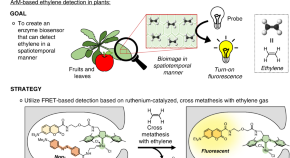

An artificial metalloenzyme biosensor can detect ethylene gas in fruits and Arabidopsis leaves
Existing methods to detect ethylene in plant tissue typically require gas chromatography or use ethylene-dependent gene expression as a proxy. Here Vong et al . show that an artificial metalloenzyme-based ethylene probe can be used to detect ethylene in plants with improved spatiotemporal resolution.
- Kenward Vong
- Katsunori Tanaka
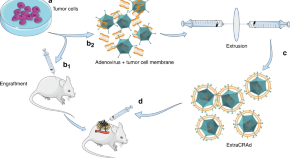
Artificially cloaked viral nanovaccine for cancer immunotherapy
Cancer therapy using oncolytic virus has shown pre-clinical and clinical efficacy. Here, the authors report ExtraCRAd, an oncolytic virus cloaked with tumour cell membrane and report its therapeutic effects in vitro and in vivo in multiple mouse tumour models.
- Manlio Fusciello
- Flavia Fontana
- Vincenzo Cerullo
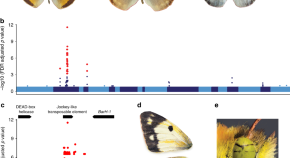
A transposable element insertion is associated with an alternative life history strategy
Tradeoffs are central to life history theory and evolutionary biology, yet almost nothing is known about their mechanistic basis. Here the authors characterize one such mechanism and find a transposable element insertion is associated with the switch between alternative life history strategies.
- Alyssa Woronik
- Kalle Tunström
- Christopher W. Wheat
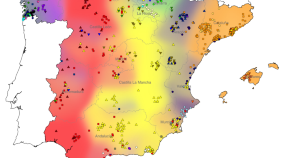
Patterns of genetic differentiation and the footprints of historical migrations in the Iberian Peninsula
The Iberian Peninsula has a complex history. Here, the authors analyse the genetic structure of the modern Iberian population at fine scale, revealing historical population movements associated with the time of Muslim rule.
- Clare Bycroft
- Ceres Fernandez-Rozadilla
- Simon Myers
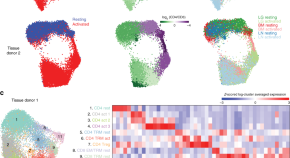
Single-cell transcriptomics of human T cells reveals tissue and activation signatures in health and disease
Immune cells are shaped by the tissue environment, yet the states of healthy human T cells are mainly studied in the blood. Here, the authors perform single cell RNA-seq of T cells from tissues and blood of healthy donors and show its utility as a reference map for comparison of human T cell states in disease.
- Peter A. Szabo
- Hanna Mendes Levitin
- Peter A. Sims

Genomic risk score offers predictive performance comparable to clinical risk factors for ischaemic stroke
Stroke risk is influenced by genetic and lifestyle factors and previously a genomic risk score (GRS) for stroke was proposed, albeit with limited predictive power. Here, Abraham et al. develop a metaGRS that is composed of several stroke-related GRSs and demonstrate improved predictive power compared with individual GRS or classic risk factors.
- Gad Abraham
- Rainer Malik
- Martin Dichgans
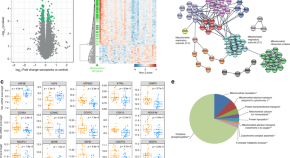
Mitochondrial oxidative capacity and NAD + biosynthesis are reduced in human sarcopenia across ethnicities
Sarcopenia is the loss of muscle mass and strength associated with physical disability during ageing. Here, the authors analyse muscle biopsies from 119 patients with sarcopenia and age-matched controls of different ethnic groups and find transcriptional signatures indicating mitochondrial dysfunction, associated with reduced mitochondria numbers and lower NAD + levels in older individuals with sarcopenia.
- Eugenia Migliavacca
- Stacey K. H. Tay
- Jerome N. Feige
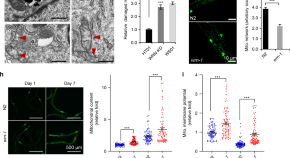
NAD + augmentation restores mitophagy and limits accelerated aging in Werner syndrome
The molecular mechanisms of mitochondrial dysfunction in the premature ageing Werner syndrome were elusive. Here the authors show that NAD + depletion-induced impaired mitophagy contributes to this phenomenon, shedding light on potential therapeutics.
- Evandro F. Fang
- Vilhelm A. Bohr

Novel approach reveals genomic landscapes of single-strand DNA breaks with nucleotide resolution in human cells
Single strand breaks represent the most common form of DNA damage yet no methods to map them in a genome-wide fashion at single nucleotide resolution exist. Here the authors develop such a method and apply to uncover patterns of single-strand DNA “breakome” in different biological conditions.
- Lorena Salazar-García
- Philipp Kapranov

Evaluation of 16S rRNA gene sequencing for species and strain-level microbiome analysis
Here, the authors explore the potential of the 16S gene for discriminating bacterial taxa and show that full-length sequencing combined with appropriate clustering of intragenomic sequence variation can provide accurate representation of bacterial species in microbiome datasets.
- Jethro S. Johnson
- Daniel J. Spakowicz
- George M. Weinstock
Quick links
- Explore articles by subject
- Guide to authors
- Editorial policies
Introduction to the Biology Senior Thesis
Why must i do a senior exercise.
All Pomona concentrations require the completion of a senior exercise, a project that is intended to demonstrate that students can think independently and creatively about their chosen disciplines and can use the research tools of those disciplines. The Biology Department senior thesis represents the culmination of your biology education at Pomona.
What is the Senior Exercise in Biology?
The biology senior exercise consists of the identification of an interesting, unsolved question in biology and the formulation of an original, testable hypothesis. It also includes designing a research protocol intended to test that hypothesis and evaluating the results. Thorough analysis and clear communication are two immutable requirements for any senior thesis in biology. There are two options:
A. The research grant proposal
The grant proposal option is a one-half credit, one-semester exercise that requires you to write a research grant proposal like those that practicing biologists submit to granting agencies. Such a proposal explains the exact nature of the problem and sets it within the context of work already accomplished in the field in order to explain why the problem is an interesting and important one to study. The proposal then outlines, in considerable detail, the approach that you would use if you were actually to carry out the research. Your aim here is to convince a granting agency that is familiar with the literature of your field, that the problem or question is an important one, and that your experimental approach is practical and likely to succeed. We expect you to put in an effort throughout the semester equivalent to that of a regular, one-half credit course.
B. The laboratory/field experimental research thesis
The experimental thesis option is a two-semester exercise that requires you to design an original study, carry it out yourself, and write up your results in the form of a scientific paper. As with the research grant proposal, the importance and significance of the research must be set in the context of what has been already been done in the field.
You will earn a total of 2.0 course credits for an experimental thesis. During the fall semester you will register for one credit of Biology 194A, and during the spring semester you will register for one credit of Biology 194B. We expect that you will devote equal time and effort each semester , equivalent to that of a 2.0 credit course extending over two semesters.
Students electing to undertake field research should discuss with a faculty member an appropriate project, one either closely related to the faculty member's own research or, with the approval of the faculty member, of the student's design. Students electing to undertake laboratory research must realize that the project may necessarily be limited by the availability of necessary supplies and equipment in the laboratory of the faculty member in which they work and, accordingly, may need to be closely related to the research conducted in that laboratory. If you would like to do laboratory research, your first step should be to contact the faculty member whose research is in the area most similar to your own interests so that the two of you can discuss an appropriate thesis project.
What Options Should I Choose?
Each option has its own rewards and frustrations, and each requires the demonstration of somewhat different abilities. Both begin at the same point: the identification of an interesting problem to study that can be narrowed to a testable hypothesis. The grant proposal allows you to tackle a rather sophisticated problem because typically a proposal describes 2-3 years of full time work. A laboratory/field thesis demands that you identify a limited problem that you can reasonably address within two semesters. This problem is narrower in scope than those in a grant proposal thesis simply because you will actually do the research that you propose. It requires more long-term planning, but it also provides you with valuable practical experience and the satisfaction that comes from completing a piece of research yourself. A laboratory/field thesis will sharpen your ability to cope with the unexpected, and the experience will teach you much about yourself and about the psychological demands of research. This option is recommended for students who are interested in going to graduate school or for those who think they might be; the only way to discover whether you want to spend a career doing research is to try it. An application to graduate school will be strengthened by having the experience of designing and carrying out your own research project.
How do I Choose a Problem?
For many students, this is the hardest part. These suggestions might help:
- In your classes, keep a list of "unanswered questions" -those issues that your professor, text, or readings identify as unresolved. Any upper-division biology course will introduce you to many such questions.
- Have you been involved in any undergraduate research projects (summer or academic year) that you found particularly interesting? Think about expanding on your experience in this area.
- Think about laboratory or field exercises in your courses that you particularly enjoyed. Think about ways to follow them up, and/or talk to the professor of that course about ways a course project could be expanded into a thesis.
- Look at current issues of Science , Nature , or Trends in ...( Genetics , Neuroscience , Ecology and Evolution, Plant Science , etc.) All these journals have "News and Views" sections that report on new and interesting research directions in specific fields.
- Above all, begin planning well in advance! A few days is not enough time to come up with a problem that will keep you interested for a whole semester or two.
Once you have found a topic, determine whether or not it meets all of the following criteria:
- Do you have sufficient background from your course work and/or research experience to address this topic?
- Is there a faculty member(s) in the Biology department who can serve as advisor(s) on this topic?
- If you are proposing to repeat a study but on a previously untested organism, is there a strongly compelling reason to do so?
How Soon do I Need to Decide on What I Will do?
You must submit a "contract" to the biology department with an outline of your problem before you can pre-register. For a fall grant proposal or a year-long research thesis, this contract must be submitted before pre-registration in the spring of your junior year . For a spring grant proposal, the deadline is pre-registration in the fall of your senior year .
What do I Need to Arrange Before I Pre-Register?
You must complete and turn in a " senior exercise performance contract [pdf] ", which is at the end of this handout and includes:
Signature of one reader/advisor
The signature of one professor from the Biology Department who agrees to serve as the reader/advisor for your proposal or thesis. The choice of potential advisors and a research problem go hand-in-hand, and an advisor won't agree to sign unless he/she is persuaded that your problem is well chosen and well thought out, and that he/she is an appropriate reader for your topic. Give a professor some warning that you are going to ask him/her to serve as a reader (and be prepared to be turned down, especially if you approach her/him at the last minute), and discuss your ideas with him/her well ahead of time.
OPTIONAL - Names of three additional faculty
We ask for these suggestions because sometimes topics require an additional reader to be fairly evaluated. Not all theses will be assigned a second reader, however. List up to three additional biology faculty whom you suggest as potential readers for your thesis. If you receive two readers, the biology faculty will make every effort to select the additional reader from this list of three in a way that will fairly distribute the overall senior thesis workload among the faculty, but we can not guarantee that we will select one from your list.
One-page description (abstract) of your thesis topic
You must outline the problem you have chosen to study and demonstrate by your description that you have the background knowledge to pursue this topic.
List of at least ten recent articles (reference list)
(typically papers published within the last 5 years, although there may be some exceptions)
Select these articles from the primary literature (original research articles). They should both provide a thorough background and demonstrate the current understanding of the topic you wish to address. Your reference list serves to convince the department that there is enough known about your topic to allow you to pursue it fruitfully and that you are sufficiently familiar with it.
List of research requirements
(experimental theses only)
For a laboratory/field thesis, you must discuss with your reader your particular research needs such as field sites, lab facilities, permits (if necessary), equipment, and supplies. A contract for an experimental thesis must include a list of your research needs and a proposed budget. Be advised that a thesis requiring more than $500 will be approved only if funds are available.
After submitting these materials, the department will meet and review all thesis contracts. At that time, the faculty will decide whether each student has selected a topic that is reasonable and well researched. If this is the case, you will be notified that your thesis contract has been approved (and who is your second reader if any).
Important Reminders For Both Options
Meet regularly with your thesis readers .
We hope that these guidelines will be helpful to you. If you have any questions or are confused about any aspect of your thesis, it is always wise to consult with both readers (if you have two). Although periodic meetings are not required, we recommend them very strongly, and it is optimal for your meetings to include both readers. It is your responsibility to maintain close contact with your faculty readers throughout the course of your thesis, inform them of your progress and seek their advice as needed. It is to your advantage to have your readers make suggestions in informal meetings during the semester rather than only on the final copy.
Your Thesis Must Be An Original Piece of Work
We expect the ideas in your thesis to be an original product, of your own reflections and analyses. Of course, they will arise from a combination of your study of the ideas of others and you own original contributions. It is therefore necessary to make a careful distinction between ideas that you adopt from other sources and those you develop yourself. You do this by citing in your text the sources of ideas from others that you adopt or discuss. We consider the inclusion of any ideas of others that are not cited as a case of your being dishonest about the intellectual origins of your thesis. When in doubt, whether you learned something from reading, from a class lecture, or from discussions with others, you must acknowledge the source when you use that information in your thesis. This applies not only to factual information but also to ideas. You know that in other types of writing, you must provide a reference for a direct quote in addition to putting that statement in quotation marks to indicate that the wording is not your own. However, if you paraphrase another source, you must also acknowledge that source because the basic idea is someone else's, even if the particular words are yours. Failure to acknowledge your sources will be treated as a violation of the rules for Academic Honesty, as described in the College catalog. If you have a question about what constitutes plagiarism, consult your ID 1 handout, the description in your Bio 40, Bio 41C, and/or Bio 41E lab manuals, lecture notes on plagiarism from other courses, and/or your readers.
You should obtain your information from the primary literature; do not use textbooks or review articles as your principle sources of information.
These ethical rules are fundamental to the practice of science. Science is a collection of ideas about the way that nature "works", and these ideas are refined by experiment and observation. People who contribute these ideas are entitled to the credit for them; ideas are intellectual property. You will want to be recognized and acknowledged for your own original contributions, and it is only fair that you treat others accordingly.
The very fact that this section of the guidelines in large part repeats what we have stated earlier is an indication of how seriously we take the issue of academic honesty. We expect that you will, too.
The entire Biology Department faculty hopes that when you have finished, you will consider your senior thesis as the best work you have done at Pomona College. It is our fervent desire that you will look back on your thesis with pride as a rich learning experience.
Mailing Address
Pomona College 333 N. College Way Claremont , CA 91711
Get in touch
Give back to pomona.
Part of The Claremont Colleges

BIOL 4930 Senior Seminar, Current Topics in Biology
- Home and Assigned Journals
- Find Popular Science Books/eBooks
- Find Research Articles
- Citing Sources
Science Librarian

CU Libraries Quick Links
- Libraries Homepage
- Libraries Hours
- Library Catalog
- Clemson Libraries News
- Databases A-Z List
Tutorial on Conducting a Literature Review
Looking for guidance on how to conduct a literature review? Check out this tutorial that includes modules on how to formulate a question, gather and evaluate your sources, interpret your findings, and write an effective literature review.
NOTE: After clicking the link to open the tutorial, be sure to click on "+ Join the Course" in Canvas so you can participate fully in the tutorial.
Assigned Journals/Blogs for BIOL 4930 Assignments
NOTE: Access to 1990-2015 Proceedings of the Royal Society B, Biological Sciences is also available through JSTOR Life Sciences.

2015-present
NOTE: Access to 1975-2013 Paleobiology is also available through JSTOR Life Sciences and 2002-present in SciTech Premium Collection
Key Article Databases
- Web of Science - All Databases This link opens in a new window includes Web of Science Core Collection , Biosis (Citation Index & Previews) , Current Contents , Data Citation Index , Derwent Innovations Index , KCI-Korean Journals , MEDLINE , Russian Science Citation Index , SciELO Citation Index , and Zoological Record
- Biological Science Database This link opens in a new window animal behavior, aquatic sciences, ecology, genetics, industrial and applied microbiology, and toxicology, 2000-present; Conference Papers Index , 1982-present; TOXLINE , 1996-present; formerly Biological Sciences
- General Science Full Text This link opens in a new window full text from approx. 100 periodicals since 1994; indexing and abstracts for hundreds of periodicals since 1984
- BioOne Complete This link opens in a new window full-text database of high-impact bioscience research journals; 2000-present
- Ecology Abstracts This link opens in a new window includes habitats, food chains, erosion, evolutionary biology, systems analysis, and more; 1982-present
- Genetics Abstracts This link opens in a new window covers current and previous year
- Agricola This link opens in a new window agriculture and related fields, 1970-present
- All The World’s Primates This link opens in a new window information about all the species and subspecies of living lorises, galagos, lemurs, tarsiers, monkeys, and apes; may have to allow Silverlight to activate
- JoVE Biology This link opens in a new window the Journal of Visualized Experiments (JoVE), a PubMed-indexed video journal
- Next: Find Popular Science Books/eBooks >>
- Last Updated: Aug 10, 2022 2:54 PM
- URL: https://clemson.libguides.com/BIOL4930
Custom Essay, Term Paper & Research paper writing services
- testimonials
Toll Free: +1 (888) 354-4744
Email: [email protected]
Writing custom essays & research papers since 2008
Top 100 biology research topics for high school and college.
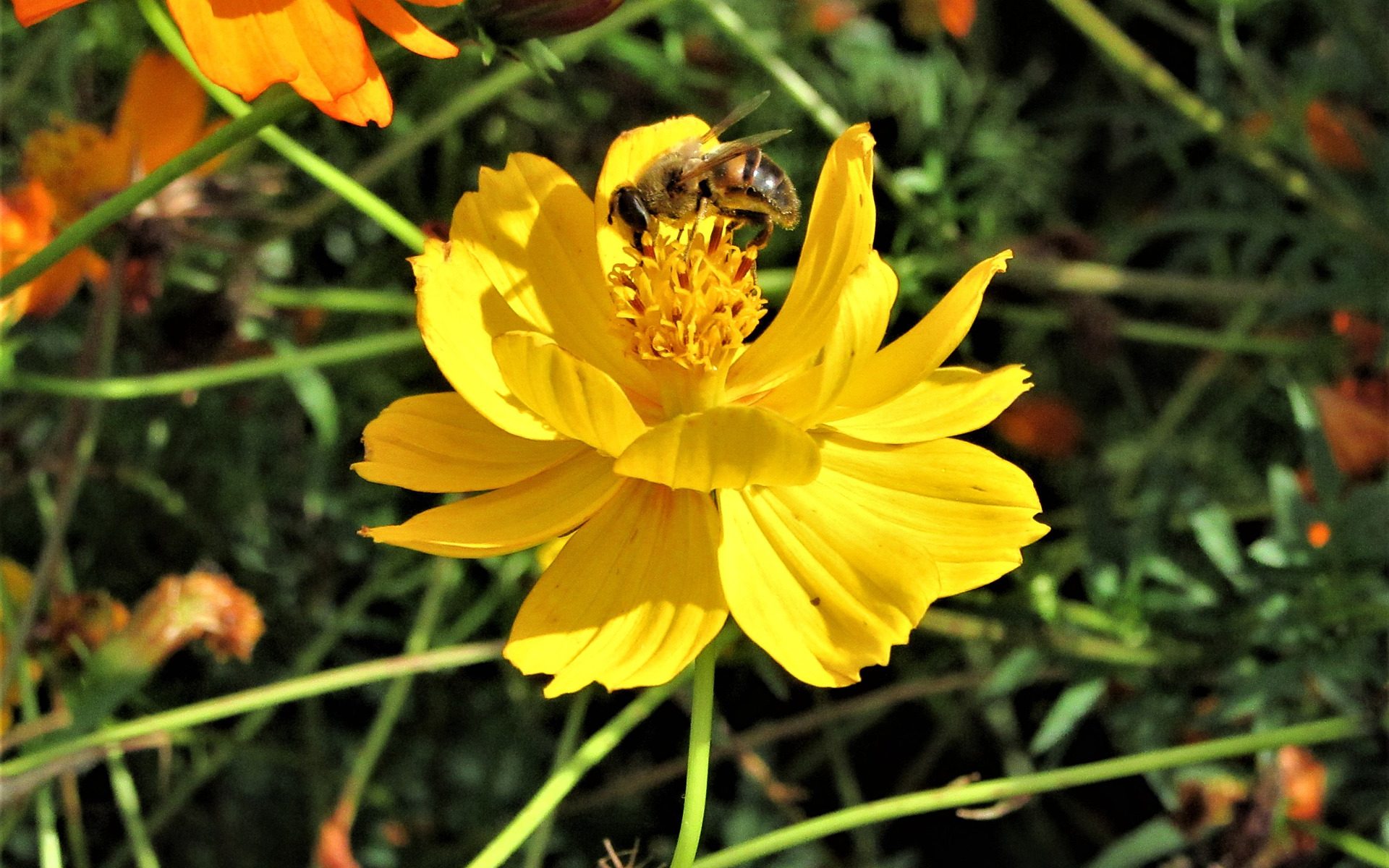
Writing a biology essay may not sound like a very difficult thing to do. In fact, most students really like this subject. The problem is not that you can’t write a good paper on a topic in biology. The problem is with finding excellent biology research topics. Now, you may be wondering why you would want to invest so much time into finding great biology research paper topics. After all, what you write in the essay matters more than the topic, right? Wrong! We are here to tell you that professors really appreciate interesting and unique topics.
And it makes a lot of sense, if you think about it. If you simply pick one of the most popular biology research topics, you will never be able to pique the interest of your teacher. He has read dozens, if not hundreds, or papers on that exact same topic. What you want to do is come up with interesting biology research topics. You want to find topics that none of your classmates are thinking of writing an academic paper about. You will shortly see why this is important. And we will also give you 100 biology topics for research projects that you can use for free – right now!
Biology Research Paper Topics Really Are Important!
It doesn’t matter what area of biology you need to write about. This information applies to everything from zoology and botany to anatomy. The reality is that your professor will really appreciate good topics. And you can rest assured that he or she knows how to spot them. The moment the professor starts to read your paper, he or she will immediately realize that you really did your best to find an excellent topic. And if you write a good introduction paragraph (which contains a captivating thesis statement as well), you are in the best position to earn bonus points.
You may not be aware of it, but teachers are willing to treat great papers with more leniency. This means that you will not get penalized for minor mistakes if you come up with a great topic. In other words, you will get a better grade on your papers if you manage to come up with good research topics for biology. This is a fact and it is based on thousands of pieces of feedback from our readers.
How Do You Choose Good Biology Research Topics?
Choosing research topics for biology can be a daunting task. Frankly, the research paper topics biology students are looking for are not easy to come by. The first thing you want to avoid is going to the first website that pops up in Google and getting your ideas from there. Most of your peers will do the same. Also, avoid topics that are extremely simple. You will simply not have enough ideas to write about. Of course, you should avoid overly complex topics because finding information about them may be extremely difficult.
The best way to find a good topic, in our opinion, is to get in touch with an academic writing company. You will get access to a professional writer who knows exactly what professors are looking for. A writer will quickly give you an amazing research topic in biology.
Eloquent Examples of Popular Biology Research Topics
To make things as simple as possible for you, we’ve put together a list of biology research project ideas. You will find 100 topics on various subjects below. Of course, you can use any of our topics for free. However, keep in mind that even though we are doing our best to maintain this list fresh, other students will find it as well. If you need new topics for your next biology essay, we recommend you to get in touch with us. We monitor our email address, so we can help you right away. Also, you can buy a research paper from our service.
Biology Research Topics for High School
Are you looking for biology research topics for high school? These are relatively simple when compared to college-level topics. Here are a couple of topic ideas that high school students will surely appreciate:
- Identifying Three Dead Branches of Evolution.
- What Is Sleep?
- How Does Physical Exercise Affect the Metabolism?
- A Behavioral Study of Birds.
- How Does Music Affect Your Brain?
- Climate Change and Biodiversity.
- Are Bees Really Becoming Extinct?
- Rainforest Extinction Is Dangerous.
- The Benefits of Organic Farming.
- Can the Brain Repair Itself?
- The Effect of Bacteria on Depression.
- How Do Sea Animals Camouflage?
Research Topics in Biology for Undergraduates
Research topics in biology for undergraduates are more complex than high school or college topics. Our researchers did their best to find topics that are relatively complex. However, each one of the following topics has plenty of information about it online:
- What Is the Mechanism of Metastasis in Cancer Patients?
- How Do Tumor Suppressor Genes Appear?
- How Can We Destroy Cancer Cells Without Damaging Other Cells?
- The Benefits of Gene Therapy.
- Analyzing the Huntington’s Disease (the HTT Gene).
- How Does the down Syndrome (Trisomy of 21st Chromosome) Appear?
- Analyzing the Brain Activity During an Epileptic Seizure.
- How Are Our Memories Formed and Preserved?
- The Effect of Probiotics on Infections.
- Analyzing Primate Language.
- Analyzing Primate Cognitive Functions.
- The Link Between Darwin’s Theory and Biology.
Biology Research Topics for College Students
Biology research topics for college students are of moderate difficulty. They are easier than undergrad topics and more complex than high school topics. While compiling this list, we made sure you have more than enough information online to write the paper quickly:
- Using DNA Technology in the Field of Medical Genetics.
- The Effect of Drinking on Embryonic Development.
- How Are Genes Mapped and Cloned?
- Explain What Genetic Polymorphism Is.
- What Is a Hereditary Disease?
- The Effect of Drugs on Embryonic Development.
- Describing Oligogenic Diseases (like Hirschsprung Disease)
- What Is the Mendelian Inheritance?
- How Transcriptomics and Proteomics Changed Modern Medicine.
- The Risk Factors of Infertility Explained.
- How Does Aging Effect Infertility?
- What Do Ash Elements Do in a Plant?
- Explaining the Pigments in a Plant Cell.
- How Is Photosynthesis Done?
- The Role of Fats in Plant Cells.
- The Effect of Smoking on Embryonic Development.
Cell Biology Research Topics
Some of the best biology topics are cell biology research topics. The scientific community is constantly making progress in this area, so there is always something new to write about. Here are some of the best examples:
- What Is Regenerative Medicine?
- A Closer Look at Tissue Engineering.
- Discuss the Future of Regenerative Medicine.
- Analyzing Therapeutic Cloning.
- The Pros and Cons of Creating Artificial Organs.
- How Do Cell Age?
- Can We Reverse Cell Aging?
- Advances in Cell Therapy.
- What Is Cell Adhesion?
- Explaining Cell Division.
- What Is Cellular Metabolism?
- Describe Active and Passive Transport in Cells.
- What Are Cell Plastids?
Evolutionary Biology Research Paper Topics
If you want something more complex, you can try your hand at writing on evolutionary biology research paper topics. As with all our topics, you will be able to find a lot of ideas and information online. Here are our picks:
- Where Did Plants Come From? (The Evolutionary Theory)
- Explaining the Host-parasite Coevolution.
- How Did Parasites Evolve over Time?
- What Is Natural Selection and How Does It Work?
- Explain Sexual Selection.
- Explain Sexual Conflict.
- How Did Our Immune Systems Evolve?
- How Do New Species Appear in the Wild?
- The Evolution of Cell Respiration.
- What Is the Hippo Pathway? (Developmental Biology)
Various Topics
Antibiotics resistance, agriculture and cloning are hot subjects nowadays. Your professor will surely be interested to learn more about biology research topics. Here is a mix of topic ideas from our established community of academic writers:
- The Problem of Using Antibiotics on Large Scale.
- Examining the Effects of Salt on Plants.
- What Is DNA Technology?
- The Effects of GMOs on the Human Body.
- How Is the Quality of Antibiotics Controlled?
- How Are GMO Food Crops Created?
- The Effect of Veterinary Antibiotics on Humans.
- The Allergic Reactions to Specific Antibiotics.
- A Look at How Penicillin Works in the Human Body.
- How Are Antibiotics Obtained?
- What Are Natural Biochemicals with Pest-repellent Properties?
- The 3 Most Toxic Effects of Antibiotics
- How the Human Body Develops Resistance to Antibiotics.
- The Impact of Biology on the Us Agriculture.
- What Is the Green Revolution?
- Analyzing the Minerals in the Plant Cell.
- Analyzing Muscle Development and Regeneration
- The Uses of Cancer Stem Cells.
Marine Biology Research Topics
There is a lot of talk about global warming, about microplastics in our oceans, and about endangered marine species. This means that marine biology research topics are a very hot topic today. Here are some of our best ideas:
- Can GMO Organisms Break down Oil after Maritime Accidents?
- Pollution-absorbing Bio-films.
- Microbes That Can Absorb Toxic Compounds in the Water.
- Can We Really Use Bioluminescence?
- How Is Bio-diesel Created?
- Analyzing the Coral Reef Biology.
- Why Is the Lobster Population Dwindling?
- The Effect of Mass Fishing on the World’s Oceans.
- Global Warming and Its Effect on Marine Microorganisms.
Molecular Biology Research Topics
Writing about molecular biology research topics is not easy. However, it’s a foolproof way to get a top grade. Your professor will really appreciate your willingness to write an essay about a complex topic. Just make sure you know what you are talking about. Below you can find some of the best topics:
- How Is Insulin Produced?
- How Is the Growth Hormone Produced?
- Analyzing the Repropagation of Translation.
- What Is DNA-telomerase?
- The Process of Sequencing Nucleotides in DNA.
- What Is Telomerase?
- The Link Between Telomerase and Cancer.
- The Link Between Telomerase and Aging.
- How Does DNA Forensics Work?
- Describe the Process of Protein Metabolism.
There is no such thing as easy biology research topics. When the topic is too simple, you end up getting penalized. You can’t write 500 words about it without straying away from the subject. Also, no matter how interesting the topic may be, you should make sure that the essay is written perfectly. This means that not even interesting biology research topics can save you from a bad grade if you fail to follow all applicable academic writing standards.
Find it hard to cope with your college paper? Great news! Use promo “ mypaper20 ” and enjoy 20% discount on a biology writing assignment from our profs!
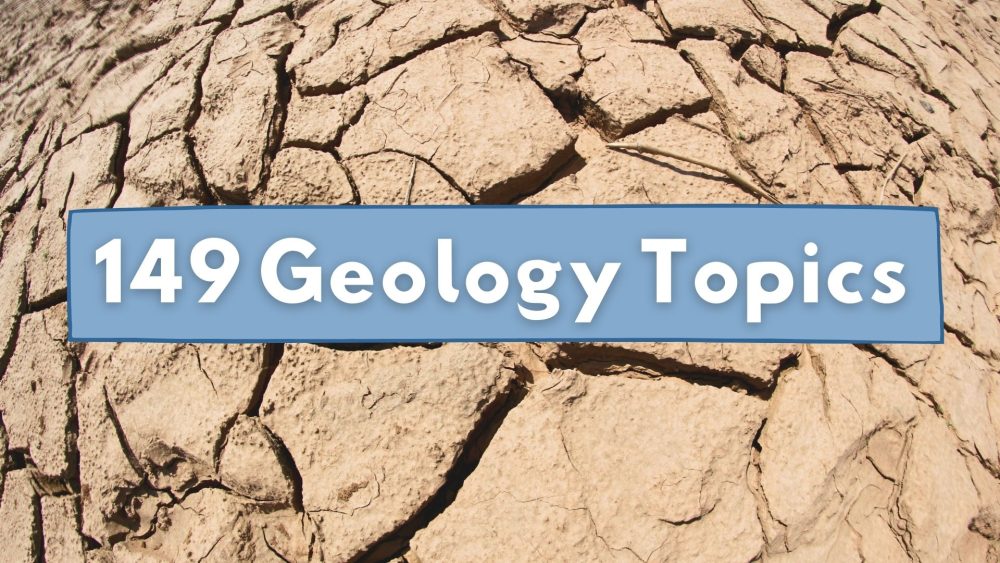
Loading metrics
Open Access
Peer-reviewed
Meta-Research Article
Meta-Research Articles feature data-driven examinations of the methods, reporting, verification, and evaluation of scientific research.
See Journal Information »
Assessing the evolution of research topics in a biological field using plant science as an example
Roles Conceptualization, Data curation, Formal analysis, Funding acquisition, Investigation, Methodology, Project administration, Resources, Software, Supervision, Validation, Visualization, Writing – original draft, Writing – review & editing
* E-mail: [email protected]
Affiliations Department of Plant Biology, Michigan State University, East Lansing, Michigan, United States of America, Department of Computational Mathematics, Science, and Engineering, Michigan State University, East Lansing, Michigan, United States of America, DOE-Great Lake Bioenergy Research Center, Michigan State University, East Lansing, Michigan, United States of America
Roles Conceptualization, Investigation, Project administration, Supervision, Writing – review & editing
Affiliation Department of Plant Biology, Michigan State University, East Lansing, Michigan, United States of America
- Shin-Han Shiu,
- Melissa D. Lehti-Shiu

- Published: May 23, 2024
- https://doi.org/10.1371/journal.pbio.3002612
- Peer Review
- Reader Comments
Scientific advances due to conceptual or technological innovations can be revealed by examining how research topics have evolved. But such topical evolution is difficult to uncover and quantify because of the large body of literature and the need for expert knowledge in a wide range of areas in a field. Using plant biology as an example, we used machine learning and language models to classify plant science citations into topics representing interconnected, evolving subfields. The changes in prevalence of topical records over the last 50 years reflect shifts in major research trends and recent radiation of new topics, as well as turnover of model species and vastly different plant science research trajectories among countries. Our approaches readily summarize the topical diversity and evolution of a scientific field with hundreds of thousands of relevant papers, and they can be applied broadly to other fields.
Citation: Shiu S-H, Lehti-Shiu MD (2024) Assessing the evolution of research topics in a biological field using plant science as an example. PLoS Biol 22(5): e3002612. https://doi.org/10.1371/journal.pbio.3002612
Academic Editor: Ulrich Dirnagl, Charite Universitatsmedizin Berlin, GERMANY
Received: October 16, 2023; Accepted: April 4, 2024; Published: May 23, 2024
Copyright: © 2024 Shiu, Lehti-Shiu. This is an open access article distributed under the terms of the Creative Commons Attribution License , which permits unrestricted use, distribution, and reproduction in any medium, provided the original author and source are credited.
Data Availability: The plant science corpus data are available through Zenodo ( https://zenodo.org/records/10022686 ). The codes for the entire project are available through GitHub ( https://github.com/ShiuLab/plant_sci_hist ) and Zenodo ( https://doi.org/10.5281/zenodo.10894387 ).
Funding: This work was supported by the National Science Foundation (IOS-2107215 and MCB-2210431 to MDL and SHS; DGE-1828149 and IOS-2218206 to SHS), Department of Energy grant Great Lakes Bioenergy Research Center (DE-SC0018409 to SHS). The funders had no role in study design, data collection and analysis, decision to publish, or preparation of the manuscript.
Competing interests: The authors have declared that no competing interests exist.
Abbreviations: BERT, Bidirectional Encoder Representations from Transformers; br, brassinosteroid; ccTLD, country code Top Level Domain; c-Tf-Idf, class-based Tf-Idf; ChatGPT, Chat Generative Pretrained Transformer; ga, gibberellic acid; LOWESS, locally weighted scatterplot smoothing; MeSH, Medical Subject Heading; SHAP, SHapley Additive exPlanations; SJR, SCImago Journal Rank; Tf-Idf, Term frequency-Inverse document frequency; UMAP, Uniform Manifold Approximation and Projection
Introduction
The explosive growth of scientific data in recent years has been accompanied by a rapidly increasing volume of literature. These records represent a major component of our scientific knowledge and embody the history of conceptual and technological advances in various fields over time. Our ability to wade through these records is important for identifying relevant literature for specific topics, a crucial practice of any scientific pursuit [ 1 ]. Classifying the large body of literature into topics can provide a useful means to identify relevant literature. In addition, these topics offer an opportunity to assess how scientific fields have evolved and when major shifts in took place. However, such classification is challenging because the relevant articles in any topic or domain can number in the tens or hundreds of thousands, and the literature is in the form of natural language, which takes substantial effort and expertise to process [ 2 , 3 ]. In addition, even if one could digest all literature in a field, it would still be difficult to quantify such knowledge.
In the last several years, there has been a quantum leap in natural language processing approaches due to the feasibility of building complex deep learning models with highly flexible architectures [ 4 , 5 ]. The development of large language models such as Bidirectional Encoder Representations from Transformers (BERT; [ 6 ]) and Chat Generative Pretrained Transformer (ChatGPT; [ 7 ]) has enabled the analysis, generation, and modeling of natural language texts in a wide range of applications. The success of these applications is, in large part, due to the feasibility of considering how the same words are used in different contexts when modeling natural language [ 6 ]. One such application is topic modeling, the practice of establishing statistical models of semantic structures underlying a document collection. Topic modeling has been proposed for identifying scientific hot topics over time [ 1 ], for example, in synthetic biology [ 8 ], and it has also been applied to, for example, automatically identify topical scenes in images [ 9 ] and social network topics [ 10 ], discover gene programs highly correlated with cancer prognosis [ 11 ], capture “chromatin topics” that define cell-type differences [ 12 ], and investigate relationships between genetic variants and disease risk [ 13 ]. Here, we use topic modeling to ask how research topics in a scientific field have evolved and what major changes in the research trends have taken place, using plant science as an example.
Plant science corpora allow classification of major research topics
Plant science, broadly defined, is the study of photosynthetic species, their interactions with biotic/abiotic environments, and their applications. For modeling plant science topical evolution, we first identified a collection of plant science documents (i.e., corpus) using a text classification approach. To this end, we first collected over 30 million PubMed records and narrowed down candidate plant science records by searching for those with plant-related terms and taxon names (see Materials and methods ). Because there remained a substantial number of false positives (i.e., biomedical records mentioning plants in passing), a set of positive plant science examples from the 17 plant science journals with the highest numbers of plant science publications covering a wide range of subfields and a set of negative examples from journals with few candidate plant science records were used to train 4 types of text classification models (see Materials and methods ). The best text classification model performed well (F1 = 0.96, F1 of a naïve model = 0.5, perfect model = 1) where the positive and negative examples were clearly separated from each other based on prediction probability of the hold-out testing dataset (false negative rate = 2.6%, false positive rate = 5.2%, S1A and S1B Fig ). The false prediction rate for documents from the 17 plant science journals annotated with the Medical Subject Heading (MeSH) term “Plants” in NCBI was 11.7% (see Materials and methods ). The prediction probability distribution of positive instances with the MeSH term has an expected left-skew to lower values ( S1C Fig ) compared with the distributions of all positive instances ( S1A Fig ). Thus, this subset with the MeSH term is a skewed representation of articles from these 17 major plant science journals. To further benchmark the validity of the plant science records, we also conducted manual annotation of 100 records where the false positive and false negative rates were 14.6% and 10.6%, respectively (see Materials and methods ). Using 12 other plant science journals not included as positive examples as benchmarks, the false negative rate was 9.9% (see Materials and methods ). Considering the range of false prediction rate estimates with different benchmarks, we should emphasize that the model built with the top 17 plant science journals represents a substantial fraction of plant science publications but with biases. Applying the model to the candidate plant science record led to 421,658 positive predictions, hereafter referred to as “plant science records” ( S1D Fig and S1 Data ).
To better understand how the models classified plant science articles, we identified important terms from a more easily interpretable model (Term frequency-Inverse document frequency (Tf-Idf) model; F1 = 0.934) using Shapley Additive Explanations [ 14 ]; 136 terms contributed to predicting plant science records (e.g., Arabidopsis, xylem, seedling) and 138 terms contributed to non-plant science record predictions (e.g., patients, clinical, mice; Tf-Idf feature sheet, S1 Data ). Plant science records as well as PubMed articles grew exponentially from 1950 to 2020 ( Fig 1A ), highlighting the challenges of digesting the rapidly expanding literature. We used the plant science records to perform topic modeling, which consisted of 4 steps: representing each record as a BERT embedding, reducing dimensionality, clustering, and identifying the top terms by calculating class (i.e., topic)-based Tf-Idf (c-Tf-Idf; [ 15 ]). The c-Tf-Idf represents the frequency of a term in the context of how rare the term is to reduce the influence of common words. SciBERT [ 16 ] was the best model among those tested ( S2 Data ) and was used for building the final topic model, which classified 372,430 (88.3%) records into 90 topics defined by distinct combinations of terms ( S3 Data ). The topics contained 620 to 16,183 records and were named after the top 4 to 5 terms defining the topical areas ( Fig 1B and S3 Data ). For example, the top 5 terms representing the largest topic, topic 61 (16,183 records), are “qtl,” “resistance,” “wheat,” “markers,” and “traits,” which represent crop improvement studies using quantitative genetics.
- PPT PowerPoint slide
- PNG larger image
- TIFF original image
(A) Numbers of PubMed (magenta) and plant science (green) records between 1950 and 2020. (a, b, c) Coefficients of the exponential function, y = ae b . Data for the plot are in S1 Data . (B) Numbers of documents for the top 30 plant science topics. Each topic is designated by an index number (left) and the top 4–6 terms with the highest cTf-Idf values (right). Data for the plot are in S3 Data . (C) Two-dimensional representation of the relationships between plant science records generated by Uniform Manifold Approximation and Projection (UMAP, [ 17 ]) using SciBERT embeddings of plant science records. All topics panel: Different topics are assigned different colors. Outlier panel: UMAP representation of all records (gray) with outlier records in red. Blue dotted circles: areas with relatively high densities indicating topics that are below the threshold for inclusion in a topic. In the 8 UMAP representations on the right, records for example topics are in red and the remaining records in gray. Blue dotted circles indicate the relative position of topic 48.
https://doi.org/10.1371/journal.pbio.3002612.g001
Records with assigned topics clustered into distinct areas in a two-dimensional (2D) space ( Fig 1C , for all topics, see S4 Data ). The remaining 49,228 outlier records not assigned to any topic (11.7%, middle panel, Fig 1C ) have 3 potential sources. First, some outliers likely belong to unique topics but have fewer records than the threshold (>500, blue dotted circles, Fig 1C ). Second, some of the many outliers dispersed within the 2D space ( Fig 1C ) were not assigned to any single topic because they had relatively high prediction scores for multiple topics ( S2 Fig ). These likely represent studies across subdisciplines in plant science. Third, some outliers are likely interdisciplinary studies between plant science and other domains, such as chemistry, mathematics, and physics. Such connections can only be revealed if records from other domains are included in the analyses.
Topical clusters reveal closely related topics but with distinct key term usage
Related topics tend to be located close together in the 2D representation (e.g., topics 48 and 49, Fig 1C ). We further assessed intertopical relationships by determining the cosine similarities between topics using cTf-Idfs ( Figs 2A and S3 ). In this topic network, some topics are closely related and form topic clusters. For example, topics 25, 26, and 27 collectively represent a more general topic related to the field of plant development (cluster a , lower left in Fig 2A ). Other topic clusters represent studies of stress, ion transport, and heavy metals ( b ); photosynthesis, water, and UV-B ( c ); population and community biology (d); genomics, genetic mapping, and phylogenetics ( e , upper right); and enzyme biochemistry ( f , upper left in Fig 2A ).
(A) Graph depicting the degrees of similarity (edges) between topics (nodes). Between each topic pair, a cosine similarity value was calculated using the cTf-Idf values of all terms. A threshold similarity of 0.6 was applied to illustrate the most related topics. For the full matrix presented as a heatmap, see S4 Fig . The nodes are labeled with topic index numbers and the top 4–6 terms. The colors and width of the edges are defined based on cosine similarity. Example topic clusters are highlighted in yellow and labeled a through f (blue boxes). (B, C) Relationships between the cTf-Idf values (see S3 Data ) of the top terms for topics 26 and 27 (B) and for topics 25 and 27 (C) . Only terms with cTf-Idf ≥ 0.6 are labeled. Terms with cTf-Idf values beyond the x and y axis limit are indicated by pink arrows and cTf-Idf values. (D) The 2D representation in Fig 1C is partitioned into graphs for different years, and example plots for every 5-year period since 1975 are shown. Example topics discussed in the text are indicated. Blue arrows connect the areas occupied by records of example topics across time periods to indicate changes in document frequencies.
https://doi.org/10.1371/journal.pbio.3002612.g002
Topics differed in how well they were connected to each other, reflecting how general the research interests or needs are (see Materials and methods ). For example, topic 24 (stress mechanisms) is the most well connected with median cosine similarity = 0.36, potentially because researchers in many subfields consider aspects of plant stress even though it is not the focus. The least connected topics include topic 21 (clock biology, 0.12), which is surprising because of the importance of clocks in essentially all aspects of plant biology [ 18 ]. This may be attributed, in part, to the relatively recent attention in this area.
Examining topical relationships and the cTf-Idf values of terms also revealed how related topics differ. For example, topic 26 is closely related to topics 27 and 25 (cluster a on the lower left of Fig 2A ). Topics 26 and 27 both contain records of developmental process studies mainly in Arabidopsis ( Fig 2B ); however, topic 26 is focused on the impact of light, photoreceptors, and hormones such as gibberellic acids (ga) and brassinosteroids (br), whereas topic 27 is focused on flowering and floral development. Topic 25 is also focused on plant development but differs from topic 27 because it contains records of studies mainly focusing on signaling and auxin with less emphasis on Arabidopsis ( Fig 2C ). These examples also highlight the importance of using multiple top terms to represent the topics. The similarities in cTf-Idfs between topics were also useful for measuring the editorial scope (i.e., diverse, or narrow) of journals publishing plant science papers using a relative topic diversity measure (see Materials and methods ). For example, Proceedings of the National Academy of Sciences , USA has the highest diversity, while Theoretical and Applied Genetics has the lowest ( S4 Fig ). One surprise is the relatively low diversity of American Journal of Botany , which focuses on plant ecology, systematics, development, and genetics. The low diversity is likely due to the relatively larger number of cellular and molecular science records in PubMed, consistent with the identification of relatively few topical areas relevant to studies at the organismal, population, community, and ecosystem levels.
Investigation of the relative prevalence of topics over time reveals topical succession
We next asked whether relationships between topics reflect chronological progression of certain subfields. To address this, we assessed how prevalent topics were over time using dynamic topic modeling [ 19 ]. As shown in Fig 2D , there is substantial fluctuation in where the records are in the 2D space over time. For example, topic 44 (light, leaves, co, synthesis, photosynthesis) is among the topics that existed in 1975 but has diminished gradually since. In 1985, topic 39 (Agrobacterium-based transformation) became dense enough to be visualized. Additional examples include topics 79 (soil heavy metals), 42 (differential expression), and 82 (bacterial community metagenomics), which became prominent in approximately 2005, 2010, and 2020, respectively ( Fig 2D ). In addition, animating the document occupancy in the 2D space over time revealed a broad change in patterns over time: Some initially dense areas became sparse over time and a large number of topics in areas previously only loosely occupied at the turn of the century increased over time ( S5 Data ).
While the 2D representations reveal substantial details on the evolution of topics, comparison over time is challenging because the number of plant science records has grown exponentially ( Fig 1A ). To address this, the records were divided into 50 chronological bins each with approximately 8,400 records to make cross-bin comparisons feasible ( S6 Data ). We should emphasize that, because of the way the chronological bins were split, the number of records for each topic in each bin should be treated as a normalized value relative to all other topics during the same period. Examining this relative prevalence of topics across bins revealed a clear pattern of topic succession over time (one topic evolved into another) and the presence of 5 topical categories ( Fig 3 ). The topics were categorized based on their locally weighted scatterplot smoothing (LOWESS) fits and ordered according to timing of peak frequency ( S7 and S8 Data , see Materials and methods ). In Fig 3 , the relative decrease in document frequency does not mean that research output in a topic is dwindling. Because each row in the heatmap is normalized based on the minimum and maximum values within each topic, there still can be substantial research output in terms of numbers of publications even when the relative frequency is near zero. Thus, a reduced relative frequency of a topic reflects only a below-average growth rate compared with other topical areas.
(A-E) A heat map of relative topic frequency over time reveals 5 topical categories: (A) stable, (B) early, (C) transitional, (D) sigmoidal, and (E) rising. The x axis denotes different time bins with each bin containing a similar number of documents to account for the exponential growth of plant science records over time. The sizes of all bins except the first are drawn to scale based on the beginning and end dates. The y axis lists different topics denoted by the label and top 4 to 5 terms. In each cell, the prevalence of a topic in a time bin is colored according to the min-max normalized cTf-Idf values for that topic. Light blue dotted lines delineate different decades. The arrows left of a subset of topic labels indicate example relationships between topics in topic clusters. Blue boxes with labels a–f indicate topic clusters, which are the same as those in Fig 2 . Connecting lines indicate successional trends. Yellow circles/lines 1 – 3: 3 major transition patterns. The original data are in S5 Data .
https://doi.org/10.1371/journal.pbio.3002612.g003
The first topical category is a stable category with 7 topics mostly established before the 1980s that have since remained stable in terms of prevalence in the plant science records (top of Fig 3A ). These topics represent long-standing plant science research foci, including studies of plant physiology (topics 4, 58, and 81), genetics (topic 61), and medicinal plants (topic 53). The second category contains 8 topics established before the 1980s that have mostly decreased in prevalence since (the early category, Fig 3B ). Two examples are physiological and morphological studies of hormone action (topic 45, the second in the early category) and the characterization of protein, DNA, and RNA (topic 18, the second to last). Unlike other early topics, topic 78 (paleobotany and plant evolution studies, the last topic in Fig 3B ) experienced a resurgence in the early 2000s due to the development of new approaches and databases and changes in research foci [ 20 ].
The 33 topics in the third, transitional category became prominent in the 1980s, 1990s, or even 2000s but have clearly decreased in prevalence ( Fig 3C ). In some cases, the early and the transitional topics became less prevalent because of topical succession—refocusing of earlier topics led to newer ones that either show no clear sign of decrease (the sigmoidal category, Fig 3D ) or continue to increase in prevalence (the rising category, Fig 3E ). Consistent with the notion of topical succession, topics within each topic cluster ( Fig 2 ) were found across topic categories and/or were prominent at different time periods (indicated by colored lines linking topics, Fig 3 ). One example is topics in topic cluster b (connected with light green lines and arrows, compare Figs 2 and 3 ); the study of cation transport (topic 47, the third in the transitional category), prominent in the 1980s and early 1990s, is connected to 5 other topics, namely, another transitional topic 29 (cation channels and their expression) peaking in the 2000s and early 2010s, sigmoidal topics 24 and 28 (stress response, tolerance mechanisms) and 30 (heavy metal transport), which rose to prominence in mid-2000s, and the rising topic 42 (stress transcriptomic studies), which increased in prevalence in the mid-2010s.
The rise and fall of topics can be due to a combination of technological or conceptual breakthroughs, maturity of the field, funding constraints, or publicity. The study of transposable elements (topic 62) illustrates the effect of publicity; the rise in this field coincided with Barbara McClintock’s 1983 Nobel Prize but not with the publication of her studies in the 1950s [ 21 ]. The reduced prevalence in early 2000 likely occurred in part because analysis of transposons became a central component of genome sequencing and annotation studies, rather than dedicated studies. In addition, this example indicates that our approaches, while capable of capturing topical trends, cannot be used to directly infer major papers leading to the growth of a topic.
Three major topical transition patterns signify shifts in research trends
Beyond the succession of specific topics, 3 major transitions in the dynamic topic graph should be emphasized: (1) the relative decreasing trend of early topics in the late 1970s and early 1980s; (2) the rise of transitional topics in late 1980s; and (3) the relative decreasing trend of transitional topics in the late 1990s and early 2000s, which coincided with a radiation of sigmoidal and rising topics (yellow circles, Fig 3 ). The large numbers of topics involved in these transitions suggest major shifts in plant science research. In transition 1, early topics decreased in relative prevalence in the late 1970s to early 1980s, which coincided with the rise of transitional topics over the following decades (circle 1, Fig 3 ). For example, there was a shift from the study of purified proteins such as enzymes (early topic 48, S5A Fig ) to molecular genetic dissection of genes, proteins, and RNA (transitional topic 35, S5B Fig ) enabled by the wider adoption of recombinant DNA and molecular cloning technologies in late 1970s [ 22 ]. Transition 2 (circle 2, Fig 3 ) can be explained by the following breakthroughs in the late 1980s: better approaches to create transgenic plants and insertional mutants [ 23 ], more efficient creation of mutant plant libraries through chemical mutagenesis (e.g., [ 24 ]), and availability of gene reporter systems such as β-glucuronidase [ 25 ]. Because of these breakthroughs, molecular genetics studies shifted away from understanding the basic machinery to understanding the molecular underpinnings of specific processes, such as molecular mechanisms of flower and meristem development and the action of hormones such as auxin (topic 27, S5C Fig ); this type of research was discussed as a future trend in 1988 [ 26 ] and remains prevalent to this date. Another example is gene silencing (topic 12), which became a focal area of study along with the widespread use of transgenic plants [ 27 ].
Transition 3 is the most drastic: A large number of transitional, sigmoidal, and rising topics became prevalent nearly simultaneously at the turn of the century (circle 3, Fig 3 ). This period also coincides with a rapid increase in plant science citations ( Fig 1A ). The most notable breakthroughs included the availability of the first plant genome in 2000 [ 28 ], increasing ease and reduced cost of high-throughput sequencing [ 29 ], development of new mass spectrometry–based platforms for analyzing proteins [ 30 ], and advancements in microscopic and optical imaging approaches [ 31 ]. Advances in genomics and omics technology also led to an increase in stress transcriptomics studies (42, S5D Fig ) as well as studies in many other topics such as epigenetics (topic 11), noncoding RNA analysis (13), genomics and phylogenetics (80), breeding (41), genome sequencing and assembly (60), gene family analysis (23), and metagenomics (82 and 55).
In addition to the 3 major transitions across all topics, there were also transitions within topics revealed by examining the top terms for different time bins (heatmaps, S5 Fig ). Taken together, these observations demonstrate that knowledge about topical evolution can be readily revealed through topic modeling. Such knowledge is typically only available to experts in specific areas and is difficult to summarize manually, as no researcher has a command of the entire plant science literature.
Analysis of taxa studied reveals changes in research trends
Changes in research trends can also be illustrated by examining changes in the taxa being studied over time ( S9 Data ). There is a strong bias in the taxa studied, with the record dominated by research models and economically important taxa ( S6 Fig ). Flowering plants (Magnoliopsida) are found in 93% of records ( S6A Fig ), and the mustard family Brassicaceae dominates at the family level ( S6B Fig ) because the genus Arabidopsis contributes to 13% of plant science records ( Fig 4A ). When examining the prevalence of taxa being studied over time, clear patterns of turnover emerged similar to topical succession ( Figs 4B , S6C, and S6D ; Materials and methods ). Given that Arabidopsis is mentioned in more publications than other species we analyzed, we further examined the trends for Arabidopsis publications. The increase in the normalized number (i.e., relative to the entire plant science corpus) of Arabidopsis records coincided with advocacy of its use as a model system in the late 1980s [ 32 ]. While it remains a major plant model, there has been a decrease in overall Arabidopsis publications relative to all other plant science publications since 2011 (blue line, normalized total, Fig 4C ). Because the same chronological bins, each with same numbers of records, from the topic-over-time analysis ( Fig 3 ) were used, the decrease here does not mean that there were fewer Arabidopsis publications—in fact, the number of Arabidopsis papers has remained steady since 2011. This decrease means that Arabidopsis-related publications represent a relatively smaller proportion of plant science records. Interestingly, this decrease took place much earlier (approximately 2005) and was steeper in the United States (red line, Fig 4C ) than in all countries combined (blue line, Fig 4C ).
(A) Percentage of records mentioning specific genera. (B) Change in the prevalence of genera in plant science records over time. (C) Changes in the normalized numbers of all records (blue) and records from the US (red) mentioning Arabidopsis over time. The lines are LOWESS fits with fraction parameter = 0.2. (D) Topical over (red) and under (blue) representation among 5 genera with the most plant science records. LLR: log 2 likelihood ratios of each topic in each genus. Gray: topic-species combination not significantly enriched at the 5% level based on enrichment p -values adjusted for multiple testing with the Benjamini–Hochberg method [ 33 ]. The data used for plotting are in S9 Data . The statistics for all topics are in S10 Data .
https://doi.org/10.1371/journal.pbio.3002612.g004
Assuming that the normalized number of publications reflects the relative intensity of research activities, one hypothesis for the relative decrease in focus on Arabidopsis is that advances in, for example, plant transformation, genetic manipulation, and genome research have allowed the adoption of more previously nonmodel taxa. Consistent with this, there was a precipitous increase in the number of genera being published in the mid-90s to early 2000s during which approaches for plant transgenics became established [ 34 ], but the number has remained steady since then ( S7A Fig ). The decrease in the proportion of Arabidopsis papers is also negatively correlated with the timing of an increase in the number of draft genomes ( S7B Fig and S9 Data ). It is plausible that genome availability for other species may have contributed to a shift away from Arabidopsis. Strikingly, when we analyzed US National Science Foundation records, we found that the numbers of funded grants mentioning Arabidopsis ( S7C Fig ) have risen and fallen in near perfect synchrony with the normalized number of Arabidopsis publication records (red line, Fig 4C ). This finding likely illustrates the impact of funding on Arabidopsis research.
By considering both taxa information and research topics, we can identify clear differences in the topical areas preferred by researchers using different plant taxa ( Fig 4D and S10 Data ). For example, studies of auxin/light signaling, the circadian clock, and flowering tend to be carried out in Arabidopsis, while quantitative genetic studies of disease resistance tend to be done in wheat and rice, glyphosate research in soybean, and RNA virus research in tobacco. Taken together, joint analyses of topics and species revealed additional details about changes in preferred models over time, and the preferred topical areas for different taxa.
Countries differ in their contributions to plant science and topical preference
We next investigated whether there were geographical differences in topical preference among countries by inferring country information from 330,187 records (see Materials and methods ). The 10 countries with the most records account for 73% of the total, with China and the US contributing to approximately 18% each ( Fig 5A ). The exponential growth in plant science records (green line, Fig 1A ) was in large part due to the rapid rise in annual record numbers in China and India ( Fig 5B ). When we examined the publication growth rates using the top 17 plant science journals, the general patterns remained the same ( S7D Fig ). On the other hand, the US, Japan, Germany, France, and Great Britain had slower rates of growth compared with all non-top 10 countries. The rapid increase in records from China and India was accompanied by a rapid increase in metrics measuring journal impact ( Figs 5C and S8 and S9 Data ). For example, using citation score ( Fig 5C , see Materials and methods ), we found that during a 22-year period China (dark green) and India (light green) rapidly approached the global average (y = 0, yellow), whereas some of the other top 10 countries, particularly the US (red) and Japan (yellow green), showed signs of decrease ( Fig 5C ). It remains to be determined whether these geographical trends reflect changes in priority, investment, and/or interest in plant science research.
(A) Numbers of plant science records for countries with the 10 highest numbers. (B) Percentage of all records from each of the top 10 countries from 1980 to 2020. (C) Difference in citation scores from 1999 to 2020 for the top 10 countries. (D) Shown for each country is the relationship between the citation scores averaged from 1999 to 2020 and the slope of linear fit with year as the predictive variable and citation score as the response variable. The countries with >400 records and with <10% missing impact values are included. Data used for plots (A–D) are in S11 Data . (E) Correlation in topic enrichment scores between the top 10 countries. PCC, Pearson’s correlation coefficient, positive in red, negative in blue. Yellow rectangle: countries with more similar topical preferences. (F) Enrichment scores (LLR, log likelihood ratio) of selected topics among the top 10 countries. Red: overrepresentation, blue: underrepresentation. Gray: topic-country combination that is not significantly enriched at the 5% level based on enrichment p -values adjusted for multiple testing with the Benjamini–Hochberg method (for all topics and plotting data, see S12 Data ).
https://doi.org/10.1371/journal.pbio.3002612.g005
Interestingly, the relative growth/decline in citation scores over time (measured as the slope of linear fit of year versus citation score) was significantly and negatively correlated with average citation score ( Fig 5D ); i.e., countries with lower overall metrics tended to experience the strongest increase in citation scores over time. Thus, countries that did not originally have a strong influence on plant sciences now have increased impact. These patterns were also observed when using H-index or journal rank as metrics ( S8 Fig and S11 Data ) and were not due to increased publication volume, as the metrics were normalized against numbers of records from each country (see Materials and methods ). In addition, the fact that different metrics with different caveats and assumptions yielded consistent conclusions indicates the robustness of our observations. We hypothesize that this may be a consequence of the ease in scientific communication among geographically isolated research groups. It could also be because of the prevalence of online journals that are open access, which makes scientific information more readily accessible. Or it can be due to the increasing international collaboration. In any case, the causes for such regression toward the mean are not immediately clear and should be addressed in future studies.
We also assessed how the plant research foci of countries differ by comparing topical preference (i.e., the degree of enrichment of plant science records in different topics) between countries. For example, Italy and Spain cluster together (yellow rectangle, Fig 5E ) partly because of similar research focusing on allergens (topic 0) and mycotoxins (topic 54) and less emphasis on gene family (topic 23) and stress tolerance (topic 28) studies ( Fig 5F , for the fold enrichment and corrected p -values of all topics, see S12 Data ). There are substantial differences in topical focus between countries ( S9 Fig ). For example, research on new plant compounds associated with herbal medicine (topic 69) is a focus in China but not in the US, but the opposite is true for population genetics and evolution (topic 86) ( Fig 5F ). In addition to revealing how plant science research has evolved over time, topic modeling provides additional insights into differences in research foci among different countries, which are informative for science policy considerations.
In this study, topic modeling revealed clear transitions among research topics, which represent shifts in research trends in plant sciences. One limitation of our study is the bias in the PubMed-based corpus. The cellular, molecular, and physiological aspects of plant sciences are well represented, but there are many fewer records related to evolution, ecology, and systematics. Our use of titles/abstracts from the top 17 plant science journals as positive examples allowed us to identify papers we typically see in these journals, but this may have led to us missing “outlier” articles, which may be the most exciting. Another limitation is the need to assign only one topic to a record when a study is interdisciplinary and straddles multiple topics. Furthermore, a limited number of large, inherently heterogeneous topics were summarized to provide a more concise interpretation, which undoubtedly underrepresents the diversity of plant science research. Despite these limitations, dynamic topic modeling revealed changes in plant science research trends that coincide with major shifts in biological science. While we were interested in identifying conceptual advances, our approach can identify the trend but the underlying causes for such trends, particularly key records leading to the growth in certain topics, still need to be identified. It also remains to be determined which changes in research trends lead to paradigm shifts as defined by Kuhn [ 35 ].
The key terms defining the topics frequently describe various technologies (e.g., topic 38/39: transformation, 40: genome editing, 59: genetic markers, 65: mass spectrometry, 69: nuclear magnetic resonance) or are indicative of studies enabled through molecular genetics and omics technologies (e.g., topic 8/60: genome, 11: epigenetic modifications, 18: molecular biological studies of macromolecules, 13: small RNAs, 61: quantitative genetics, 82/84: metagenomics). Thus, this analysis highlights how technological innovation, particularly in the realm of omics, has contributed to a substantial number of research topics in the plant sciences, a finding that likely holds for other scientific disciplines. We also found that the pattern of topic evolution is similar to that of succession, where older topics have mostly decreased in relative prevalence but appear to have been superseded by newer ones. One example is the rise of transcriptome-related topics and the correlated, reduced focus on regulation at levels other than transcription. This raises the question of whether research driven by technology negatively impacts other areas of research where high-throughput studies remain challenging.
One observation on the overall trends in plant science research is the approximately 10-year cycle in major shifts. One hypothesis is related to not only scientific advances but also to the fashion-driven aspect of science. Nonetheless, given that there were only 3 major shifts and the sample size is small, it is difficult to speculate as to why they happened. By analyzing the country of origin, we found that China and India have been the 2 major contributors to the growth in the plant science records in the last 20 years. Our findings also show an equalizing trend in global plant science where countries without a strong plant science publication presence have had an increased impact over the last 20 years. In addition, we identified significant differences in research topics between countries reflecting potential differences in investment and priorities. Such information is important for discerning differences in research trends across countries and can be considered when making policy decisions about research directions.
Materials and methods
Collection and preprocessing of a candidate plant science corpus.
For reproducibility purposes, a random state value of 20220609 was used throughout the study. The PubMed baseline files containing citation information ( ftp://ftp.ncbi.nlm.nih.gov/pubmed/baseline/ ) were downloaded on November 11, 2021. To narrow down the records to plant science-related citations, a candidate citation was identified as having, within the titles and/or abstracts, at least one of the following words: “plant,” “plants,” “botany,” “botanical,” “planta,” and “plantarum” (and their corresponding upper case and plural forms), or plant taxon identifiers from NCBI Taxonomy ( https://www.ncbi.nlm.nih.gov/taxonomy ) or USDA PLANTS Database ( https://plants.sc.egov.usda.gov/home ). Note the search terms used here have nothing to do with the values of the keyword field in PubMed records. The taxon identifiers include all taxon names including and at taxonomic levels below “Viridiplantae” till the genus level (species names not used). This led to 51,395 search terms. After looking for the search terms, qualified entries were removed if they were duplicated, lacked titles and/or abstracts, or were corrections, errata, or withdrawn articles. This left 1,385,417 citations, which were considered the candidate plant science corpus (i.e., a collection of texts). For further analysis, the title and abstract for each citation were combined into a single entry. Text was preprocessed by lowercasing, removing stop-words (i.e., common words), removing non-alphanumeric and non-white space characters (except Greek letters, dashes, and commas), and applying lemmatization (i.e., grouping inflected forms of a word as a single word) for comparison. Because lemmatization led to truncated scientific terms, it was not included in the final preprocessing pipeline.
Definition of positive/negative examples
Upon closer examination, a large number of false positives were identified in the candidate plant science records. To further narrow down citations with a plant science focus, text classification was used to distinguish plant science and non-plant science articles (see next section). For the classification task, a negative set (i.e., non-plant science citations) was defined as entries from 7,360 journals that appeared <20 times in the filtered data (total = 43,329, journal candidate count, S1 Data ). For the positive examples (i.e., true plant science citations), 43,329 plant science citations (positive examples) were sampled from 17 established plant science journals each with >2,000 entries in the filtered dataset: “Plant physiology,” “Frontiers in plant science,” “Planta,” “The Plant journal: for cell and molecular biology,” “Journal of experimental botany,” “Plant molecular biology,” “The New phytologist,” “The Plant cell,” “Phytochemistry,” “Plant & cell physiology,” “American journal of botany,” “Annals of botany,” “BMC plant biology,” “Tree physiology,” “Molecular plant-microbe interactions: MPMI,” “Plant biology,” and “Plant biotechnology journal” (journal candidate count, S1 Data ). Plant biotechnology journal was included, but only 1,894 records remained after removal of duplicates, articles with missing info, and/or withdrawn articles. The positive and negative sets were randomly split into training and testing subsets (4:1) while maintaining a 1:1 positive-to-negative ratio.
Text classification based on Tf and Tf-Idf
Instead of using the preprocessed text as features for building classification models directly, text embeddings (i.e., representations of texts in vectors) were used as features. These embeddings were generated using 4 approaches (model summary, S1 Data ): Term-frequency (Tf), Tf-Idf [ 36 ], Word2Vec [ 37 ], and BERT [ 6 ]. The Tf- and Tf-Idf-based features were generated with CountVectorizer and TfidfVectorizer, respectively, from Scikit-Learn [ 38 ]. Different maximum features (1e4 to 1e5) and n-gram ranges (uni-, bi-, and tri-grams) were tested. The features were selected based on the p- value of chi-squared tests testing whether a feature had a higher-than-expected value among the positive or negative classes. Four different p- value thresholds were tested for feature selection. The selected features were then used to retrain vectorizers with the preprocessed training texts to generate feature values for classification. The classification model used was XGBoost [ 39 ] with 5 combinations of the following hyperparameters tested during 5-fold stratified cross-validation: min_child_weight = (1, 5, 10), gamma = (0.5, 1, 1.5, 2.5), subsample = (0.6, 0.8, 1.0), colsample_bytree = (0.6, 0.8, 1.0), and max_depth = (3, 4, 5). The rest of the hyperparameters were held constant: learning_rate = 0.2, n_estimators = 600, objective = binary:logistic. RandomizedSearchCV from Scikit-Learn was used for hyperparameter tuning and cross-validation with scoring = F1-score.
Because the Tf-Idf model had a relatively high model performance and was relatively easy to interpret (terms are frequency-based, instead of embedding-based like those generated by Word2Vec and BERT), the Tf-Idf model was selected as input to SHapley Additive exPlanations (SHAP; [ 14 ]) to assess the importance of terms. Because the Tf-Idf model was based on XGBoost, a tree-based algorithm, the TreeExplainer module in SHAP was used to determine a SHAP value for each entry in the training dataset for each Tf-Idf feature. The SHAP value indicates the degree to which a feature positively or negatively affects the underlying prediction. The importance of a Tf-Idf feature was calculated as the average SHAP value of that feature among all instances. Because a Tf-Idf feature is generated based on a specific term, the importance of the Tf-Idf feature indicates the importance of the associated term.
Text classification based on Word2Vec
The preprocessed texts were first split into train, validation, and test subsets (8:1:1). The texts in each subset were converted to 3 n-gram lists: a unigram list obtained by splitting tokens based on the space character, or bi- and tri-gram lists built with Gensim [ 40 ]. Each n-gram list of the training subset was next used to fit a Skip-gram Word2Vec model with vector_size = 300, window = 8, min_count = (5, 10, or 20), sg = 1, and epochs = 30. The Word2Vec model was used to generate word embeddings for train, validate, and test subsets. In the meantime, a tokenizer was trained with train subset unigrams using Tensorflow [ 41 ] and used to tokenize texts in each subset and turn each token into indices to use as features for training text classification models. To ensure all citations had the same number of features (500), longer texts were truncated, and shorter ones were zero-padded. A deep learning model was used to train a text classifier with an input layer the same size as the feature number, an attention layer incorporating embedding information for each feature, 2 bidirectional Long-Short-Term-Memory layers (15 units each), a dense layer (64 units), and a final, output layer with 2 units. During training, adam, accuracy, and sparse_categorical_crossentropy were used as the optimizer, evaluation metric, and loss function, respectively. The training process lasted 30 epochs with early stopping if validation loss did not improve in 5 epochs. An F1 score was calculated for each n-gram list and min_count parameter combination to select the best model (model summary, S1 Data ).
Text classification based on BERT models
Two pretrained models were used for BERT-based classification: DistilBERT (Hugging face repository [ 42 ] model name and version: distilbert-base-uncased [ 43 ]) and SciBERT (allenai/scibert-scivocab-uncased [ 16 ]). In both cases, tokenizers were retrained with the training data. BERT-based models had the following architecture: the token indices (512 values for each token) and associated masked values as input layers, pretrained BERT layer (512 × 768) excluding outputs, a 1D pooling layer (768 units), a dense layer (64 units), and an output layer (2 units). The rest of the training parameters were the same as those for Word2Vec-based models, except training lasted for 20 epochs. Cross-validation F1-scores for all models were compared and used to select the best model for each feature extraction method, hyperparameter combination, and modeling algorithm or architecture (model summary, S1 Data ). The best model was the Word2Vec-based model (min_count = 20, window = 8, ngram = 3), which was applied to the candidate plant science corpus to identify a set of plant science citations for further analysis. The candidate plant science records predicted as being in the positive class (421,658) by the model were collectively referred to as the “plant science corpus.”
Plant science record classification
In PubMed, 1,384,718 citations containing “plant” or any plant taxon names (from the phylum to genus level) were considered candidate plant science citations. To further distinguish plant science citations from those in other fields, text classification models were trained using titles and abstracts of positive examples consisting of citations from 17 plant science journals, each with >2,000 entries in PubMed, and negative examples consisting of records from journals with fewer than 20 entries in the candidate set. Among 4 models tested the best model (built with Word2Vec embeddings) had a cross validation F1 of 0.964 (random guess F1 = 0.5, perfect model F1 = 1, S1 Data ). When testing the model using 17,330 testing set citations independent from the training set, the F1 remained high at 0.961.
We also conducted another analysis attempting to use the MeSH term “Plants” as a benchmark. Records with the MeSH term “Plants” also include pharmaceutical studies of plants and plant metabolites or immunological studies of plants as allergens in journals that are not generally considered plant science journals (e.g., Acta astronautica , International journal for parasitology , Journal of chromatography ) or journals from local scientific societies (e.g., Acta pharmaceutica Hungarica , Huan jing ke xue , Izvestiia Akademii nauk . Seriia biologicheskaia ). Because we explicitly labeled papers from such journals as negative examples, we focused on 4,004 records with the “Plants” MeSH term published in the 17 plant science journals that were used as positive instances and found that 88.3% were predicted as the positive class. Thus, based on the MeSH term, there is an 11.7% false prediction rate.
We also enlisted 5 plant science colleagues (3 advanced graduate students in plant biology and genetic/genome science graduate programs, 1 postdoctoral breeder/quantitative biologist, and 1 postdoctoral biochemist/geneticist) to annotate 100 randomly selected abstracts as a reviewer suggested. Each record was annotated by 2 colleagues. Among 85 entries where the annotations are consistent between annotators, 48 were annotated as negative but with 7 predicted as positive (false positive rate = 14.6%) and 37 were annotated as positive but with 4 predicted as negative (false negative rate = 10.8%). To further benchmark the performance of the text classification model, we identified another 12 journals that focus on plant science studies to use as benchmarks: Current opinion in plant biology (number of articles: 1,806), Trends in plant science (1,723), Functional plant biology (1,717), Molecular plant pathology (1,573), Molecular plant (1,141), Journal of integrative plant biology (1,092), Journal of plant research (1,032), Physiology and molecular biology of plants (830), Nature plants (538), The plant pathology journal (443). Annual review of plant biology (417), and The plant genome (321). Among the 12,611 candidate plant science records, 11,386 were predicted as positive. Thus, there is a 9.9% false negative rate.
Global topic modeling
BERTopic [ 15 ] was used for preliminary topic modeling with n-grams = (1,2) and with an embedding initially generated by DistilBERT, SciBERT, or BioBERT (dmis-lab/biobert-base-cased-v1.2; [ 44 ]). The embedding models converted preprocessed texts to embeddings. The topics generated based on the 3 embeddings were similar ( S2 Data ). However, SciBERT-, BioBERT-, and distilBERT-based embedding models had different numbers of outlier records (268,848, 293,790, and 323,876, respectively) with topic index = −1. In addition to generating the fewest outliers, the SciBERT-based model led to the highest number of topics. Therefore, SciBERT was chosen as the embedding model for the final round of topic modeling. Modeling consisted of 3 steps. First, document embeddings were generated with SentenceTransformer [ 45 ]. Second, a clustering model to aggregate documents into clusters using hdbscan [ 46 ] was initialized with min_cluster_size = 500, metric = euclidean, cluster_selection_method = eom, min_samples = 5. Third, the embedding and the initialized hdbscan model were used in BERTopic to model topics with neighbors = 10, nr_topics = 500, ngram_range = (1,2). Using these parameters, 90 topics were identified. The initial topic assignments were conservative, and 241,567 records were considered outliers (i.e., documents not assigned to any of the 90 topics). After assessing the prediction scores of all records generated from the fitted topic models, the 95-percentile score was 0.0155. This score was used as the threshold for assigning outliers to topics: If the maximum prediction score was above the threshold and this maximum score was for topic t , then the outlier was assigned to t . After the reassignment, 49,228 records remained outliers. To assess if some of the outliers were not assigned because they could be assigned to multiple topics, the prediction scores of the records were used to put records into 100 clusters using k- means. Each cluster was then assessed to determine if the outlier records in a cluster tended to have higher prediction scores across multiple topics ( S2 Fig ).
Topics that are most and least well connected to other topics
The most well-connected topics in the network include topic 24 (stress mechanisms, median cosine similarity = 0.36), topic 42 (genes, stress, and transcriptomes, 0.34), and topic 35 (molecular genetics, 0.32, all t test p -values < 1 × 10 −22 ). The least connected topics include topic 0 (allergen research, median cosine similarity = 0.12), topic 21 (clock biology, 0.12), topic 1 (tissue culture, 0.15), and topic 69 (identification of compounds with spectroscopic methods, 0.15; all t test p- values < 1 × 10 −24 ). Topics 0, 1, and 69 are specialized topics; it is surprising that topic 21 is not as well connected as explained in the main text.
Analysis of documents based on the topic model
Topical diversity among top journals with the most plant science records
Using a relative topic diversity measure (ranging from 0 to 10), we found that there was a wide range of topical diversity among 20 journals with the largest numbers of plant science records ( S3 Fig ). The 4 journals with the highest relative topical diversities are Proceedings of the National Academy of Sciences , USA (9.6), Scientific Reports (7.1), Plant Physiology (6.7), and PLOS ONE (6.4). The high diversities are consistent with the broad, editorial scopes of these journals. The 4 journals with the lowest diversities are American Journal of Botany (1.6), Oecologia (0.7), Plant Disease (0.7), and Theoretical and Applied Genetics (0.3), which reflects their discipline-specific focus and audience of classical botanists, ecologists, plant pathologists, and specific groups of geneticists.
Dynamic topic modeling
The codes for dynamic modeling were based on _topic_over_time.py in BERTopics and modified to allow additional outputs for debugging and graphing purposes. The plant science citations were binned into 50 subsets chronologically (for timestamps of bins, see S5 Data ). Because the numbers of documents increased exponentially over time, instead of dividing them based on equal-sized time intervals, which would result in fewer records at earlier time points and introduce bias, we divided them into time bins of similar size (approximately 8,400 documents). Thus, the earlier time subsets had larger time spans compared with later time subsets. If equal-size time intervals were used, the numbers of documents between the intervals would differ greatly; the earlier time points would have many fewer records, which may introduce bias. Prior to binning the subsets, the publication dates were converted to UNIX time (timestamp) in seconds; the plant science records start in 1917-11-1 (timestamp = −1646247600.0) and end in 2021-1-1 (timestamp = 1609477201). The starting dates and corresponding timestamps for the 50 subsets including the end date are in S6 Data . The input data included the preprocessed texts, topic assignments of records from global topic modeling, and the binned timestamps of records. Three additional parameters were set for topics_over_time, namely, nr_bin = 50 (number of bins), evolution_tuning = True, and global_tuning = False. The evolution_tuning parameter specified that averaged c-Tf-Idf values for a topic be calculated in neighboring time bins to reduce fluctuation in c-Tf-Idf values. The global_tuning parameter was set to False because of the possibility that some nonexisting terms could have a high c-Tf-Idf for a time bin simply because there was a high global c-Tf-Idf value for that term.
The binning strategy based on similar document numbers per bin allowed us to increase signal particularly for publications prior to the 90s. This strategy, however, may introduce more noise for bins with smaller time durations (i.e., more recent bins) because of publication frequencies (there can be seasonal differences in the number of papers published, biased toward, e.g., the beginning of the year or the beginning of a quarter). To address this, we examined the relative frequencies of each topic over time ( S7 Data ), but we found that recent time bins had similar variances in relative frequencies as other time bins. We also moderated the impact of variation using LOWESS (10% to 30% of the data points were used for fitting the trend lines) to determine topical trends for Fig 3 . Thus, the influence of the noise introduced via our binning strategy is expected to be minimal.
Topic categories and ordering
The topics were classified into 5 categories with contrasting trends: stable, early, transitional, sigmoidal, and rising. To define which category a topic belongs to, the frequency of documents over time bins for each topic was analyzed using 3 regression methods. We first tried 2 forecasting methods: recursive autoregressor (the ForecasterAutoreg class in the skforecast package) and autoregressive integrated moving average (ARIMA implemented in the pmdarima package). In both cases, the forecasting results did not clearly follow the expected trend lines, likely due to the low numbers of data points (relative frequency values), which resulted in the need to extensively impute missing data. Thus, as a third approach, we sought to fit the trendlines with the data points using LOWESS (implemented in the statsmodels package) and applied additional criteria for assigning topics to categories. When fitting with LOWESS, 3 fraction parameters (frac, the fraction of the data used when estimating each y-value) were evaluated (0.1, 0.2, 0.3). While frac = 0.3 had the smallest errors for most topics, in situations where there were outliers, frac = 0.2 or 0.1 was chosen to minimize mean squared errors ( S7 Data ).
The topics were classified into 5 categories based on the slopes of the fitted line over time: (1) stable: topics with near 0 slopes over time; (2) early: topics with negative (<−0.5) slopes throughout (with the exception of topic 78, which declined early on but bounced back by the late 1990s); (3) transitional: early positive (>0.5) slopes followed by negative slopes at later time points; (4) sigmoidal: early positive slopes followed by zero slopes at later time points; and (5) rising: continuously positive slopes. For each topic, the LOWESS fits were also used to determine when the relative document frequency reached its peak, first reaching a threshold of 0.6 (chosen after trial and error for a range of 0.3 to 0.9), and the overall trend. The topics were then ordered based on (1) whether they belonged to the stable category or not; (2) whether the trends were decreasing, stable, or increasing; (3) the time the relative document frequency first reached 0.6; and (4) the time that the overall peak was reached ( S8 Data ).
Taxa information
To identify a taxon or taxa in all plant science records, NCBI Taxonomy taxdump datasets were downloaded from the NCBI FTP site ( https://ftp.ncbi.nlm.nih.gov/pub/taxonomy/new_taxdump/ ) on September 20, 2022. The highest-level taxon was Viridiplantae, and all its child taxa were parsed and used as queries in searches against the plant science corpus. In addition, a species-over-time analysis was conducted using the same time bins as used for dynamic topic models. The number of records in different time bins for top taxa are in the genus, family, order, and additional species level sheet in S9 Data . The degree of over-/underrepresentation of a taxon X in a research topic T was assessed using the p -value of a Fisher’s exact test for a 2 × 2 table consisting of the numbers of records in both X and T, in X but not T, in T but not X, and in neither ( S10 Data ).
For analysis of plant taxa with genome information, genome data of taxa in Viridiplantae were obtained from the NCBI Genome data-hub ( https://www.ncbi.nlm.nih.gov/data-hub/genome ) on October 28, 2022. There were 2,384 plant genome assemblies belonging to 1,231 species in 559 genera (genome assembly sheet, S9 Data ). The date of the assembly was used as a proxy for the time when a genome was sequenced. However, some species have updated assemblies and have more recent data than when the genome first became available.
Taxa being studied in the plant science records
Flowering plants (Magnoliopsida) are found in 93% of records, while most other lineages are discussed in <1% of records, with conifers and related species being exceptions (Acrogynomsopermae, 3.5%, S6A Fig ). At the family level, the mustard (Brassicaceae), grass (Poaceae), pea (Fabaceae), and nightshade (Solanaceae) families are in 51% of records ( S6B Fig ). The prominence of the mustard family in plant science research is due to the Brassica and Arabidopsis genera ( Fig 4A ). When examining the prevalence of taxa being studied over time, clear patterns of turnovers emerged ( Figs 4B , S6C, and S6D ). While the study of monocot species (Liliopsida) has remained steady, there was a significant uptick in the prevalence of eudicot (eudicotyledon) records in the late 90s ( S6C Fig ), which can be attributed to the increased number of studies in the mustard, myrtle (Myrtaceae), and mint (Lamiaceae) families among others ( S6D Fig ). At the genus level, records mentioning Gossypium (cotton), Phaseolus (bean), Hordeum (wheat), and Zea (corn), similar to the topics in the early category, were prevalent till the 1980s or 1990s but have mostly decreased in number since ( Fig 4B ). In contrast, Capsicum , Arabidopsis , Oryza , Vitus , and Solanum research has become more prevalent over the last 20 years.
Geographical information for the plant science corpus
The geographical information (country) of authors in the plant science corpus was obtained from the address (AD) fields of first authors in Medline XML records accessible through the NCBI EUtility API ( https://www.ncbi.nlm.nih.gov/books/NBK25501/ ). Because only first author affiliations are available for records published before December 2014, only the first author’s location was considered to ensure consistency between records before and after that date. Among the 421,658 records in the plant science corpus, 421,585 had Medline records and 421,276 had unique PMIDs. Among the records with unique PMIDs, 401,807 contained address fields. For each of the remaining records, the AD field content was split into tokens with a “,” delimiter, and the token likely containing geographical info (referred to as location tokens) was selected as either the last token or the second to last token if the last token contained “@” indicating the presence of an email address. Because of the inconsistency in how geographical information was described in the location tokens (e.g., country, state, city, zip code, name of institution, and different combinations of the above), the following 4 approaches were used to convert location tokens into countries.
The first approach was a brute force search where full names and alpha-3 codes of current countries (ISO 3166–1), current country subregions (ISO 3166–2), and historical country (i.e., country that no longer exists, ISO 3166–3) were used to search the address fields. To reduce false positives using alpha-3 codes, a space prior to each code was required for the match. The first approach allowed the identification of 361,242, 16,573, and 279,839 records with current country, historical country, and subregion information, respectively. The second method was the use of a heuristic based on common address field structures to identify “location strings” toward the end of address fields that likely represent countries, then the use of the Python pycountry module to confirm the presence of country information. This approach led to 329,025 records with country information. The third approach was to parse first author email addresses (90,799 records), recover top-level domain information, and use country code Top Level Domain (ccTLD) data from the ISO 3166 Wikipedia page to define countries (72,640 records). Only a subset of email addresses contains country information because some are from companies (.com), nonprofit organizations (.org), and others. Because a large number of records with address fields still did not have country information after taking the above 3 approaches, another approach was implemented to query address fields against a locally installed Nominatim server (v.4.2.3, https://github.com/mediagis/nominatim-docker ) using OpenStreetMap data from GEOFABRIK ( https://www.geofabrik.de/ ) to find locations. Initial testing indicated that the use of full address strings led to false positives, and the computing resource requirement for running the server was high. Thus, only location strings from the second approach that did not lead to country information were used as queries. Because multiple potential matches were returned for each query, the results were sorted based on their location importance values. The above steps led to an additional 72,401 records with country information.
Examining the overlap in country information between approaches revealed that brute force current country and pycountry searches were consistent 97.1% of the time. In addition, both approaches had high consistency with the email-based approach (92.4% and 93.9%). However, brute force subregion and Nominatim-based predictions had the lowest consistencies with the above 3 approaches (39.8% to 47.9%) and each other. Thus, a record’s country information was finalized if the information was consistent between any 2 approaches, except between the brute force subregion and Nominatim searches. This led to 330,328 records with country information.
Topical and country impact metrics
To determine annual country impact, impact scores were determined in the same way as that for annual topical impact, except that values for different countries were calculated instead of topics ( S8 Data ).
Topical preferences by country
To determine topical preference for a country C , a 2 × 2 table was established with the number of records in topic T from C , the number of records in T but not from C , the number of non- T records from C , and the number of non- T records not from C . A Fisher’s exact test was performed for each T and C combination, and the resulting p -values were corrected for multiple testing with the Bejamini–Hochberg method (see S12 Data ). The preference of T in C was defined as the degree of enrichment calculated as log likelihood ratio of values in the 2 × 2 table. Topic 5 was excluded because >50% of the countries did not have records for this topic.
The top 10 countries could be classified into a China–India cluster, an Italy–Spain cluster, and remaining countries (yellow rectangles, Fig 5E ). The clustering of Italy and Spain is partly due to similar research focusing on allergens (topic 0) and mycotoxins (topic 54) and less emphasis on gene family (topic 23) and stress tolerance (topic 28) studies ( Figs 5F and S9 ). There are also substantial differences in topical focus between countries. For example, plant science records from China tend to be enriched in hyperspectral imaging and modeling (topic 9), gene family studies (topic 23), stress biology (topic 28), and research on new plant compounds associated with herbal medicine (topic 69), but less emphasis on population genetics and evolution (topic 86, Fig 5F ). In the US, there is a strong focus on insect pest resistance (topic 75), climate, community, and diversity (topic 83), and population genetics and evolution but less focus on new plant compounds. In summary, in addition to revealing how plant science research has evolved over time, topic modeling provides additional insights into differences in research foci among different countries.
Supporting information
S1 fig. plant science record classification model performance..
(A–C) Distributions of prediction probabilities (y_prob) of (A) positive instances (plant science records), (B) negative instances (non-plant science records), and (C) positive instances with the Medical Subject Heading “Plants” (ID = D010944). The data are color coded in blue and orange if they are correctly and incorrectly predicted, respectively. The lower subfigures contain log10-transformed x axes for the same distributions as the top subfigure for better visualization of incorrect predictions. (D) Prediction probability distribution for candidate plant science records. Prediction probabilities plotted here are available in S13 Data .
https://doi.org/10.1371/journal.pbio.3002612.s001
S2 Fig. Relationships between outlier clusters and the 90 topics.
(A) Heatmap demonstrating that some outlier clusters tend to have high prediction scores for multiple topics. Each cell shows the average prediction score of a topic for records in an outlier cluster. (B) Size of outlier clusters.
https://doi.org/10.1371/journal.pbio.3002612.s002
S3 Fig. Cosine similarities between topics.
(A) Heatmap showing cosine similarities between topic pairs. Top-left: hierarchical clustering of the cosine similarity matrix using the Ward algorithm. The branches are colored to indicate groups of related topics. (B) Topic labels and names. The topic ordering was based on hierarchical clustering of topics. Colored rectangles: neighboring topics with >0.5 cosine similarities.
https://doi.org/10.1371/journal.pbio.3002612.s003
S4 Fig. Relative topical diversity for 20 journals.
The 20 journals with the most plant science records are shown. The journal names were taken from the journal list in PubMed ( https://www.nlm.nih.gov/bsd/serfile_addedinfo.html ).
https://doi.org/10.1371/journal.pbio.3002612.s004
S5 Fig. Topical frequency and top terms during different time periods.
(A-D) Different patterns of topical frequency distributions for example topics (A) 48, (B) 35, (C) 27, and (D) 42. For each topic, the top graph shows the frequency of topical records in each time bin, which are the same as those in Fig 3 (green line), and the end date for each bin is indicated. The heatmap below each line plot depicts whether a term is among the top terms in a time bin (yellow) or not (blue). Blue dotted lines delineate different decades (see S5 Data for the original frequencies, S6 Data for the LOWESS fitted frequencies and the top terms for different topics/time bins).
https://doi.org/10.1371/journal.pbio.3002612.s005
S6 Fig. Prevalence of records mentioning different taxonomic groups in Viridiplantae.
(A, B) Percentage of records mentioning specific taxa at the ( A) major lineage and (B) family levels. (C, D) The prevalence of taxon mentions over time at the (C) major lineage and (E) family levels. The data used for plotting are available in S9 Data .
https://doi.org/10.1371/journal.pbio.3002612.s006
S7 Fig. Changes over time.
(A) Number of genera being mentioned in plant science records during different time bins (the date indicates the end date of that bin, exclusive). (B) Numbers of genera (blue) and organisms (salmon) with draft genomes available from National Center of Biotechnology Information in different years. (C) Percentage of US National Science Foundation (NSF) grants mentioning the genus Arabidopsis over time with peak percentage and year indicated. The data for (A–C) are in S9 Data . (D) Number of plant science records in the top 17 plant science journals from the USA (red), Great Britain (GBR) (orange), India (IND) (light green), and China (CHN) (dark green) normalized against the total numbers of publications of each country over time in these 17 journals. The data used for plotting can be found in S11 Data .
https://doi.org/10.1371/journal.pbio.3002612.s007
S8 Fig. Change in country impact on plant science over time.
(A, B) Difference in 2 impact metrics from 1999 to 2020 for the 10 countries with the highest number of plant science records. (A) H-index. (B) SCImago Journal Rank (SJR). (C, D) Plots show the relationships between the impact metrics (H-index in (C) , SJR in (D) ) averaged from 1999 to 2020 and the slopes of linear fits with years as the predictive variable and impact metric as the response variable for different countries (A3 country codes shown). The countries with >400 records and with <10% missing impact values are included. The data used for plotting can be found in S11 Data .
https://doi.org/10.1371/journal.pbio.3002612.s008
S9 Fig. Country topical preference.
Enrichment scores (LLR, log likelihood ratio) of topics for each of the top 10 countries. Red: overrepresentation, blue: underrepresentation. The data for plotting can be found in S12 Data .
https://doi.org/10.1371/journal.pbio.3002612.s009
S1 Data. Summary of source journals for plant science records, prediction models, and top Tf-Idf features.
Sheet–Candidate plant sci record j counts: Number of records from each journal in the candidate plant science corpus (before classification). Sheet—Plant sci record j count: Number of records from each journal in the plant science corpus (after classification). Sheet–Model summary: Model type, text used (txt_flag), and model parameters used. Sheet—Model performance: Performance of different model and parameter combinations on the validation data set. Sheet–Tf-Idf features: The average SHAP values of Tf-Idf (Term frequency-Inverse document frequency) features associated with different terms. Sheet–PubMed number per year: The data for PubMed records in Fig 1A . Sheet–Plant sci record num per yr: The data for the plant science records in Fig 1A .
https://doi.org/10.1371/journal.pbio.3002612.s010
S2 Data. Numbers of records in topics identified from preliminary topic models.
Sheet–Topics generated with a model based on BioBERT embeddings. Sheet–Topics generated with a model based on distilBERT embeddings. Sheet–Topics generated with a model based on SciBERT embeddings.
https://doi.org/10.1371/journal.pbio.3002612.s011
S3 Data. Final topic model labels and top terms for topics.
Sheet–Topic label: The topic index and top 10 terms with the highest cTf-Idf values. Sheets– 0 to 89: The top 50 terms and their c-Tf-Idf values for topics 0 to 89.
https://doi.org/10.1371/journal.pbio.3002612.s012
S4 Data. UMAP representations of different topics.
For a topic T , records in the UMAP graph are colored red and records not in T are colored gray.
https://doi.org/10.1371/journal.pbio.3002612.s013
S5 Data. Temporal relationships between published documents projected onto 2D space.
The 2D embedding generated with UMAP was used to plot document relationships for each year. The plots from 1975 to 2020 were compiled into an animation.
https://doi.org/10.1371/journal.pbio.3002612.s014
S6 Data. Timestamps and dates for dynamic topic modeling.
Sheet–bin_timestamp: Columns are: (1) order index; (2) bin_idx–relative positions of bin labels; (3) bin_timestamp–UNIX time in seconds; and (4) bin_date–month/day/year. Sheet–Topic frequency per timestamp: The number of documents in each time bin for each topic. Sheets–LOWESS fit 0.1/0.2/0.3: Topic frequency per timestamp fitted with the fraction parameter of 0.1, 0.2, or 0.3. Sheet—Topic top terms: The top 5 terms for each topic in each time bin.
https://doi.org/10.1371/journal.pbio.3002612.s015
S7 Data. Locally weighted scatterplot smoothing (LOWESS) of topical document frequencies over time.
There are 90 scatter plots, one for each topic, where the x axis is time, and the y axis is the document frequency (blue dots). The LOWESS fit is shown as orange points connected with a green line. The category a topic belongs to and its order in Fig 3 are labeled on the top left corner. The data used for plotting are in S6 Data .
https://doi.org/10.1371/journal.pbio.3002612.s016
S8 Data. The 4 criteria used for sorting topics.
Peak: the time when the LOWESS fit of the frequencies of a topic reaches maximum. 1st_reach_thr: the time when the LOWESS fit first reaches a threshold of 60% maximal frequency (peak value). Trend: upward (1), no change (0), or downward (−1). Stable: whether a topic belongs to the stable category (1) or not (0).
https://doi.org/10.1371/journal.pbio.3002612.s017
S9 Data. Change in taxon record numbers and genome assemblies available over time.
Sheet–Genus: Number of records mentioning a genus during different time periods (in Unix timestamp) for the top 100 genera. Sheet–Genus: Number of records mentioning a family during different time periods (in Unix timestamp) for the top 100 families. Sheet–Genus: Number of records mentioning an order during different time periods (in Unix timestamp) for the top 20 orders. Sheet–Species levels: Number of records mentioning 12 selected taxonomic levels higher than the order level during different time periods (in Unix timestamp). Sheet–Genome assembly: Plant genome assemblies available from NCBI as of October 28, 2022. Sheet–Arabidopsis NSF: Absolute and normalized numbers of US National Science Foundation funded proposals mentioning Arabidopsis in proposal titles and/or abstracts.
https://doi.org/10.1371/journal.pbio.3002612.s018
S10 Data. Taxon topical preference.
Sheet– 5 genera LLR: The log likelihood ratio of each topic in each of the top 5 genera with the highest numbers of plant science records. Sheets– 5 genera: For each genus, the columns are: (1) topic; (2) the Fisher’s exact test p -value (Pvalue); (3–6) numbers of records in topic T and in genus X (n_inT_inX), in T but not in X (n_inT_niX), not in T but in X (n_niT_inX), and not in T and X (n_niT_niX) that were used to construct 2 × 2 tables for the tests; and (7) the log likelihood ratio generated with the 2 × 2 tables. Sheet–corrected p -value: The 4 values for generating LLRs were used to conduct Fisher’s exact test. The p -values obtained for each country were corrected for multiple testing.
https://doi.org/10.1371/journal.pbio.3002612.s019
S11 Data. Impact metrics of countries in different years.
Sheet–country_top25_year_count: number of total publications and publications per year from the top 25 countries with the most plant science records. Sheet—country_top25_year_top17j: number of total publications and publications per year from the top 25 countries with the highest numbers of plant science records in the 17 plant science journals used as positive examples. Sheet–prank: Journal percentile rank scores for countries (3-letter country codes following https://www.iban.com/country-codes ) in different years from 1999 to 2020. Sheet–sjr: Scimago Journal rank scores. Sheet–hidx: H-Index scores. Sheet–cite: Citation scores.
https://doi.org/10.1371/journal.pbio.3002612.s020
S12 Data. Topical enrichment for the top 10 countries with the highest numbers of plant science publications.
Sheet—Log likelihood ratio: For each country C and topic T, it is defined as log((a/b)/(c/d)) where a is the number of papers from C in T, b is the number from C but not in T, c is the number not from C but in T, d is the number not from C and not in T. Sheet: corrected p -value: The 4 values, a, b, c, and d, were used to conduct Fisher’s exact test. The p -values obtained for each country were corrected for multiple testing.
https://doi.org/10.1371/journal.pbio.3002612.s021
S13 Data. Text classification prediction probabilities.
This compressed file contains the PubMed ID (PMID) and the prediction probabilities (y_pred) of testing data with both positive and negative examples (pred_prob_testing), plant science candidate records with the MeSH term “Plants” (pred_prob_candidates_with_mesh), and all plant science candidate records (pred_prob_candidates_all). The prediction probability was generated using the Word2Vec text classification models for distinguishing positive (plant science) and negative (non-plant science) records.
https://doi.org/10.1371/journal.pbio.3002612.s022
Acknowledgments
We thank Maarten Grootendorst for discussions on topic modeling. We also thank Stacey Harmer, Eva Farre, Ning Jiang, and Robert Last for discussion on their respective research fields and input on how to improve this study and Rudiger Simon for the suggestion to examine differences between countries. We also thank Mae Milton, Christina King, Edmond Anderson, Jingyao Tang, Brianna Brown, Kenia Segura Abá, Eleanor Siler, Thilanka Ranaweera, Huan Chen, Rajneesh Singhal, Paulo Izquierdo, Jyothi Kumar, Daniel Shiu, Elliott Shiu, and Wiggler Catt for their good ideas, personal and professional support, collegiality, fun at parties, as well as the trouble they have caused, which helped us improve as researchers, teachers, mentors, and parents.
- View Article
- PubMed/NCBI
- Google Scholar
- 2. Blei DM, Lafferty JD. Topic Models. In: Srivastava A, Sahami M, editors. Text Mining. Cambridge: Chapman and Hall/CRC; 2009. pp. 71–93.
- 7. ChatGPT. [cited 2023 Aug 25]. Available from: https://chat.openai.com
- 9. Fei-Fei L, Perona P. A Bayesian hierarchical model for learning natural scene categories. 2005 IEEE Computer Society Conference on Computer Vision and Pattern Recognition (CVPR’05); 2005. pp. 524–531 vol. 2. https://doi.org/10.1109/CVPR.2005.16
- 19. Blei DM, Lafferty JD. Dynamic topic models. Proceedings of the 23rd International Conference on Machine learning. New York, NY, USA: Association for Computing Machinery; 2006. pp. 113–120. https://doi.org/10.1145/1143844.1143859
- 35. Kuhn T. The Structure of Scientific Revolution. Chicago: University of Chicago Press; 1962.
- 36. CiteSeer | Proceedings of the second international conference on Autonomous agents. [cited 2023 Aug 23]. Available from: https://dl.acm.org/doi/10.1145/280765.280786
- 39. Chen T, Guestrin C. XGBoost: A Scalable Tree Boosting System. Proceedings of the 22nd ACM SIGKDD International Conference on Knowledge Discovery and Data Mining. New York, NY, USA: ACM; 2016. pp. 785–794. https://doi.org/10.1145/2939672.2939785
- 40. Řehůřek R, Sojka P. Software Framework for Topic Modelling with Large Corpora. Proceedings of the LREC 2010 Workshop on New Challenges for NLP Frameworks. Valletta, Malta: ELRA; 2010. pp. 45–50.
- 42. Hugging Face–The AI community building the future. 2023 Aug 19 [cited 2023 Aug 25]. Available from: https://huggingface.co/
Biology Research Projects for High School Students: 20 Ideas To Try This Summer

By János Perczel
Co-founder of Polygence, PhD from MIT
16 minute read
Biology and biomedical research are two of the most popular academic disciplines among high schoolers. If you’re someone who’s interested in those fields and you’re looking for research opportunities this summer, you’ve come to the right place! With the study of biology, not only can you gain a better understanding of the natural world, but your research can have practical applications in fields like medicine, agriculture, and environmental science. Whether you’re just starting out in your exploration of biology, have taken a biology class in school, or you’re looking to do some advanced research to submit to your state’s science fair , we have level-appropriate ideas for you!
With a variety of topics like cancer treatment, genetics, neurodegenerative diseases, and marine life, we’ve got you covered. Here is a curated list of 20 different research project ideas to get those creative juices flowing. If you’re hungry for more, head over to our comprehensive Project Ideas database here and browse over 2800 more ideas!
Research YOUR fave areas of Biology and Medicine
Polygence pairs you with an expert mentor in to create a passion project around biology and medicine. Together, you work to create a high quality research project that is uniquely your own. We also offer options to explore multiple topics, or to showcase your final product!
Human Body Project Ideas
Rate of cognitive decline in different elevations.
Oxygen partial pressure decreases with altitude, challenging blood oxygenation which may affect brain function. If you’ve ever felt some altitude sickness, then this is exactly what’s happening. This is because the atmospheric pressure decreases at higher elevations, leading to a decrease in the partial pressures of the gasses in the air, including oxygen. And of course, oxygen is needed for us to function. What is the effect on brain health/ cognition in sudden increased elevation: say, climbing Mount Everest? Does chronic exposure to high elevations increase the likelihood of dementia? In this project, a meta-analysis of published works examining the effects of altitude on cognition would be conducted.
Idea by mentor Alyssa
Building a Blood Vessel
Use online graphics to illustrate how a blood vessel forms. Blood vessels are structures that carry blood and are responsible for transporting nutrients and oxygen throughout the body. There are three main types of blood vessels: arteries, veins, and capillaries. For this project, complete a literature search to understand what is known about blood vessel growth. Then, utilize this information to generate a graphic with no words to demonstrate how the vasculature (network of blood vessels) forms. The goal of this project is to explain science without using text and therefore make it more available to a larger community.
Idea by mentor Natalie
Examining the bacterial profile of various households
As of late, bacterial microbiomes have been a huge and interesting topic in the field of bacteriology as they play an important role in human health. Bacterial microbiomes are communities of bacteria that live on or outside organisms. They’re found in various parts of the human body, and help us to digest food and regulate our immune system. In this project, you will seek to understand how skin microbiomes can differ between different individuals of different households. This project will require making different bacterial media that can be made at home selecting for various microorganisms. If you’re new to preparing bacterial media, check out this resource here!
Idea by mentor Hamilton
Regulation of Circadian Clocks
Sleep is known to be governed by two distinct processes: a circadian clock that aligns sleep and wakefulness to the solar day and the sleep homeostat that encodes for sleep debt as a compensatory mechanism against sleep loss. You’ve most likely heard about circadian rhythm and our body’s internal clock, and circadian regulation of sleep is a fundamental process that allows animals to anticipate sleepiness or wakefulness consistently every day. These mechanisms can be regulated in multiple ways: at the gene, protein, gene, and clock neuronal level. In this project, we will focus on 1) how to efficiently digest primary and review articles to compile and condense information, 2) investigate how circadian clocks are regulated at these different genetic levels, and 3) try to effectively summarize the information we've gathered. We can present this information in a variety of ways, and what the final product looks like is up to you.
Idea by mentor Oscar
The Biology of Aging
Aging is the number one risk factor for a variety of diseases including cancer, neurodegenerative disease, and loss of hearing/sight. We are only now beginning to truly understand the process of aging and have even started to uncover ways that we could stop, or potentially reverse, the effects of aging. What are the hallmarks/signs of aging? How do researchers study 'aging'? How does human lifespan and aging compare to the rest of the animal kingdom? Is it possible to stop or reverse the effects of aging? What advancements are being made related to this? We could explore these questions or brainstorm others you might have about the biology of aging.
Idea by mentor Emily
Animals, Plants, and Nature Project Ideas
How genetically engineered mosquitoes are reducing rates of vector-borne diseases such as zika.
Many countries are already releasing millions of genetically engineered mosquitoes into the wild every week. These mosquitoes have been modified to reduce their ability to transmit disease-causing pathogens like dengue fever, Zika, and malaria, and are sent into the wild to mate with disease-carrying mosquitoes. However, this is still controversial as some people are concerned about the unintended consequences on the environment. What could be the potential pros and cons for this? The project will mainly focus on doing meta analysis of articles and watching informative videos to understand how/why genetically engineered mosquitoes can be used to reduce rates of different diseases. Students will have the chance to use critical thinking and do in-depth research on genetic engineering techniques, how scientists determine breeding rates and number of insects released, and epidemiology of different bloodborne diseases.
Idea by mentor Vanessa
Efficacy of Marine Protected Areas
Marine protected areas (MPAs) are areas of ocean or coastal waters that are set aside for the conservation and sustainable use of marine resources. These areas are established by governments, NGOs, or other organizations, and they can take different forms, from fully protected "no-take" zones to areas with regulated fishing or other activities. Marine protected areas have the potential to guide sustainable resource management and protect biodiversity, but have a host of reasons for why they are not currently effective. Explore reasons for why MPAs may not be effective. Then develop a framework for mapping, modeling, and implementing an effective Marine Protected Area.
Bioinspiration: Do animals hold the answers?
Can the toxins produced by frogs help us fight antibiotic resistant bacteria strains? How can understanding how lizards and newts regrow their limbs help us improve wound treatment? Why do tilapia skins help with burns? Discover the role of animals in the development of modern medicine as well as its potential. Are there any ethical concerns with these developments and findings? If so, what are they and do they matter? Share your findings in a research proposal, article, or presentation.
Idea by mentor Cheyenne
How Climate Change Can Affect Future Distributions of Rare Species
Climate change, such as global warming and longer drought, can threaten the existence of some of the rarest plants on earth. It is important to understand how future suitable habitats will change for these rare species so that we can target our conservation efforts in specific areas. In this project, you will identify a rare species that you like (it can be animals, plants, or fungi!), and gather the data online on its current occurrences. Then you will learn how to perform species distribution modeling to map its current and future suitable habitat areas. To get you started on learning species distribution modeling, check out this Youtube resource here. The changes in the amount or location of future suitable habitats can significantly affect the destiny of a rare species. By doing this project, you will not only learn skills in data analyses but also become the best ambassador for this rare species that you love.
Idea by mentor Yingtong
A Reef’s Best Frenemies
Coral reefs are in global decline. A primary cause of this is "coral bleaching" which results in the white reefs we often see in the news. Coral bleaching is actually the breakdown in the partnership between the coral animal and tiny, symbiotic algae that live within its cells. Corals and algae have a variety of thermal tolerances which are likely decided by genetic and environmental factors. However, despite how important this relationship is, it's currently very poorly understood. This project would review existing literature on the symbiotic partnernship and try to identify factors that predict bleaching and thermal resilience.
Idea by mentor Carly
Dive in to BioMed NOW!
Register to get paired with one of our expert mentors and to get started on exploring your passions today! You have agency in setting up your schedule for this research. Dive in now!
Diseases and Treatments Project Ideas
The understanding of a new and upcoming treatment: immunotherapy.
Immunotherapies have been growing in the past few years as alternative treatments for many types of cancer. These treatments work by boosting the patient's immune system to fight the disease, however it is not always effective. There are many types of immunotherapies with various nuances, but they all work to attack specific cells that are causing the disease. For this project, pick one of a few types of immunotherapy and deeply understand the mechanism of action and what is the current effectiveness against the cancer it treats.
Idea by mentor Hannah
Exploring The Cancer Genome Atlas data
There has been an explosion of publicly available data for cancer. The Cancer Genome Atlas was a research program with the purpose of creating a comprehensive catalog of genomic and molecular information about different types of cancer, with the aim of improving our understanding of the disease and developing new treatments. The dataset has been used to identify new cancer subtypes, develop diagnostic tests, and discover potential targets for new cancer therapies. Explore the implications and impact of The Cancer Genome Atlas data, and why it’s become so important.
Idea by mentor Hersh
Systematic Review and Meta-Analysis of Physiological Benefits of Fasting-induced Autophagy
Autophagy, meaning "self-eating", is a cellular process where damaged or unwanted components are disposed. Autophagy has been linked to various diseased pathologies, including cancer and heart disease. Fasting or specific dietary lifestyles may induce levels of autophagy in the human body. In this project, we will perform and systematic review and meta-analysis of fasting or diet-induced autophagy and its benefits on the body. You will gain skills in 1) searching and reviewing primary literature, 2) computational skills for performing data analysis (R language), and 3) writing your scientific findings.
Idea by mentor Jose
The Amyloid Hypothesis: Sifting through the controversy
For many years, scientists have thought that amyloid beta was the protein responsible for a patient developing Alzheimer's Disease symptoms. This "Amyloid Hypothesis" is now being questioned in light of current clinical data. Recently, drugs have been developed that reduce amyloid beta in patients. Surprisingly, the drugs worked in reducing amyloid beta, but it did not result in the slowing of disease pathology. Does this mean that the amyloid hypothesis is incorrect? Is amyloid beta less important in the progression of disease then what we once thought? This research project aims to explore the issues with the amyloid hypothesis and to assess where we stand in our understanding of amyloid beta's contribution to Alzheimer’s.
Idea by mentor Patrick
How do vaccines work?
During the COVID pandemic, vaccines have been all over the news! But how do they actually work? What’s the science behind them? Through this project, you will explore how vaccines work and the history of science behind vaccine development. While the final product of the projectwill be up to you, the ultimate goal of this project is for you to be a true public health advocate for vaccines and to be able to communicate why vaccines are so important in a way that the general public can understand.
Idea by mentor Helen
Sleep Disruption Profiles in Various Mouse Models of Alzheimer’s
Alzheimer's disease (AD) has been studied for decades but we are no closer to understanding the mechanisms of the disease. Because of the vast number of researchers studying AD, there are numerous models used to study the disease. All these models have different sleep profiles, phenotypes, disease onsets, sex differences etc. Therefore, in this project we will compile a document based on extensive literature review about the various models there are. We will focus on sleep profiles in these animals with an emphasis on male and female differences. This information is valuable because it is important to know which model is best to use to answer your scientific questions and there is a lot of criticism (by other scientists) that can be brought on by the model chosen so you need to be able to justify your choice. This project will also introduce you to the world of AD research and some of the gaps in knowledge in the field.
Idea by mentor Shenee
Rethinking The Treatment Of Neurodegenerative Diseases
Neurodegenerative diseases affect millions of people worldwide. They are conditions that affect the nervous system, particularly the brain and spinal cord, and examples include Alzheimer’s and Parkinson’s. While billions of dollars have been spent trying to find treatments for the disease, very few drugs and therapies have had a meaningful impact on slowing down disease progression. This is often because by the time someone is diagnosed with a disease, it has progressed too far for a treatment to have a substantial effect. Some recent approaches to treatment have turned to looking for early indications of the disease (termed "biomarkers") that can occur before the onset of symptoms. By diagnosing disease and beginning treatment before symptoms arise, these treatments could have a more profound effect in slowing down the progression of disease. Students could review the recent progress being made on identifying biomarkers for neurodegenerative diseases, and either write a paper or even record a podcast on their findings!
Idea by mentor David
Genetics Project Ideas
Height and genetics: nature or nurture.
How much do your genes determine your height? How much do nutrition and environmental factors play a role? What gene variants are implicated in height differences and what is the role of epigenetics? Epigenetics is the study of heritable changes in gene expression or cellular phenotype that occur without changes to the underlying DNA sequence. These changes can be influenced by diet and lifestyle. We will access and analyze an open dataset on twins to estimate the correlation between monozygotic twins (who have the exact same DNA) and height. You will learn to use R to open a dataset, analyze data with statistical methods such the student’s t-test, and display your data as graphs and charts. Finally, you will learn how to make a research presentation on height and genetics, describe the research methods, and present the data in a compelling and thorough way.
Idea by mentor Adeoluwa
The World of Personalized Medicine
Similar to our fingerprints, our genetic code is also unique to each individual person. Our genetic code is what determines our hair color, height, eye color, skin tone...just about everything! For those that develop diseases such as cancer, their genetic code found inside the malignant cells that comprise a tumor may also be unique to them or to certain groups of people with similar mutations (the drivers of disease). So why is it that we treat each person the same way even though the genetic drivers of that disease may be disparate? The world of Personalized Medicine is new and exciting and looks to circumvent this problem. Personalized Medicine (also known as precision medicine) uses the genetic code of a patients disease to guide treatment options that prove to be highly efficacious. Together, lets write a review on a disease of your choice that could benefit from Personalized Medicine based on current literature and research.
Idea by mentor Somer
General Biology Project Ideas
Teach a biology concept two ways: to your fellow students and to the general public.
One of the best ways to learn is to teach. Choose a biological concept that interests you and prepare a lesson and or demo on it. The format should be a video recording of yourself teaching (a la Khan Academy or a Zoom class), but the other details are up to you. Consider incorporating a demonstration (e.g. how can you use items from your kitchen to illustrate properties of mixtures?) or animation (e.g. to illustrate molecular motion). Also consider how you will check that your students understand the concept(s) and/or skill(s) you have taught them. Prepare and record two versions of your lesson: one intended for your peers and one for the general public. How will the versions differ to reflect these different audiences? You will learn what it's like to teach, gain a much greater understanding of your chosen concept(s)/skill(s), and learn how to communicate science to different audiences.
Idea by mentor Alexa
Once you’ve picked a project idea, check out some of our resources to help you progress with your project! Whether you’re stuck on how to cite sources , how to come up with a great thesis statement , or how to showcase your work once it’s finished , we’ve created blog posts to help you out. If you’re interested in doing one of the biology research projects with the help of an amazing mentor at Polygence, apply now ! If you would like some help with coming up with your own idea, book a complimentary consultation call with our admissions team here ! For more biology and science research information, check out our comprehensive list of research opportunities for high school students .
Feeling Inspired?
Interested in doing an exciting research project? Click below to get matched with one of our expert mentors!
Thesis Helpers
Find the best tips and advice to improve your writing. Or, have a top expert write your paper.
100 Best Biology Topics For Academic Writing
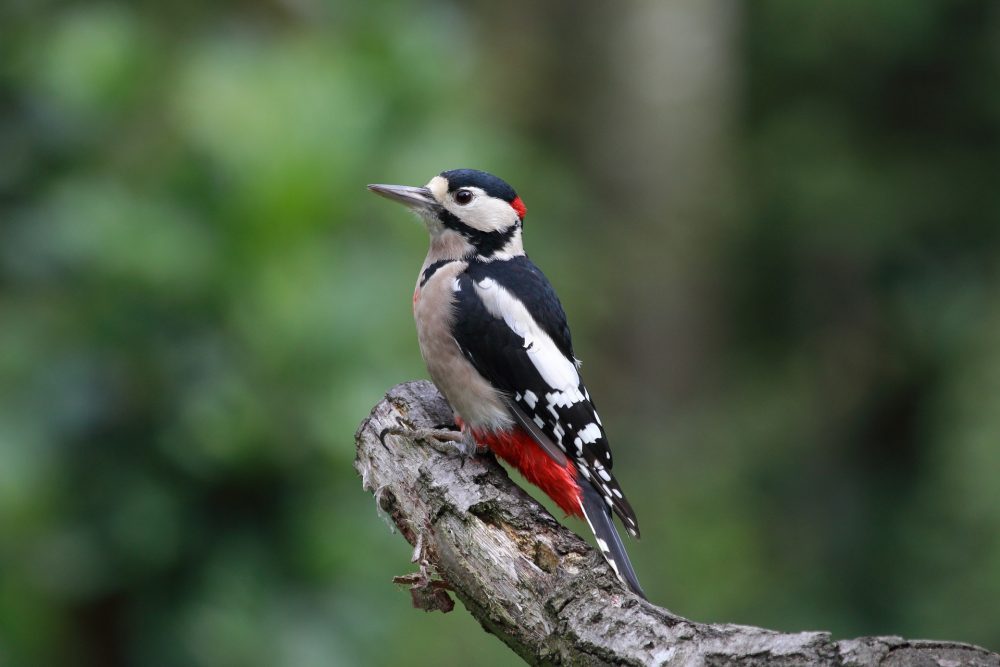
The importance of choosing interesting biology research topics comes down to the impact your assignments will make on your audience. In most cases, you will be writing with only one reader in mind – the instructor. And as this person likely sees hundreds of biology topics each school year you need to make sure you stand out as much as possible. Here are 100 biology topics for research that are sure to get your work noticed and improve your chances of earning a top grade. You can also check out our bioethics topics .
Biology Topics for High School
If you need some biology dissertation help and are looking for easy biology research topics for high school assignments, these ideas will meet most requirements without causing too much stress:
- Can Ebola be used as a biological weapon?
- How do biological genes affect depression?
- Are genetically modified foods safe for humans?
- Is human cloning a moral issue?
- How does cloning affect health medicine?
Hot Topics in Biology
This is a list of the current “hot” topics in the field and will certainly capture your audience’s attention:
- Why are abortion issues so controversial in the U.S.?
- How has gene molecular biology shifted in the last decade?
- Can enhanced antibodies help curb COVID-19 cases?
- Is immortality a realistic goal for humans?
- Why is abortion a bigger issue in the U.S. than in Europe?
Very Interesting Biology Topics
These current topics in developmental biology cover the most interesting ideas in this growing area of science:
- Can people rely on their dreams when making recollections?
- Does the Covid-19 pandemic affect medical funding?
- What is the difference between cellular function and structure?
- What is the difference between natural and planned selection?
- In what ways did evolution theory chance biology science?
Biology Research Paper Topics
Biology research is an area of study that is constantly changing. New studies come up every year and it’s important to stay up-to-date with the following issues:
- What are animals that don’t die of natural causes?
- What is the origin of human cloning?
- What are the basic principles of cloning in humans?
- Is it possible for domestic wild animals?
- Does human genetics cause obesity?
Current AP Biology Topics
AP tests have focused a lot on evolutionary biology research paper topics and this set of questions will help you prepare for the advanced placement test:
- Medicinal marijuana as a means to aid pain?
- How does rapid plan DNA change affect humans?
- What is cell tissue engineering?
- What are the most promising regenerative medicine treatments?
- What is meant by therapeutic cloning?
Molecular Biology Topics
Need topics on molecular biology issues? These five topics represent the latest research on this subject:
- Are humans naturally frugivores or omnivores?
- What are the ethical issues surrounding cloning?
- What are the biological reasons behind food intolerances?
- How can hypertrophy be enhanced in the body?
- What impact on the cellular level do sunburns have?
Biology IA Topics for 2010
The following good research topics for biology are excellent for students that do not have the time to conduct in-depth research:
- Does following a paleo diet help athletes perform?
- Does drinking more water prevent serious sunburns?
- What are the three evolutionary branches?
- How does sleep and wake cycles affect learning?
- In what ways is the brain affected by music?
Biology Topics for Presentation
- How is metabolism affected by physical exercise?
- Describe the study of behavior in birds.
- Are bees in veritable danger of becoming extinct?
- What impact does deforestation have on the biosphere?
- Is it possible for the brain to heal itself?
More IB Biology IA Topics
Advanced placement tests in this field require high-level responses on a variety of popular biology research topics. Check these out:
- How does climate change affect biodiversity?
- What are the benefits of organic farming?
- What is bioluminescence and can it be used?
- How is insulin created in the body?
- What is the relationship between cancer and telomerase?
Biology Debate Topics
These topics in biology are perfect for anyone who wants to leave a lasting impression on the reader:
- Do sports help improve humans’ biological makeup?
- How is the translation of reprobation affected by cell biology?
- Does the human body function when he or she is in a coma?
- Define the levels of molecular biology.
- How does cell manipulation affect the growth hormone?
Research Topics in Biology for Undergraduates
This group of interesting biology topics for presentation deals with what we use to understand how humans act and react:
- Is the DNA from amber a way to clone prehistoric animals?
- What is the resistance capacity of the immune system?
- How does a malfunction to the immune system increase risk?
- How do allergic reactions cause asthma in some people?
- What are the benefits of vaccination?
Biology Project Topics
These topic ideas can also make a great impression on your teacher, even though they are not controversial.
- How does stress affect the human immune system?
- How does cell structure affect resistance to antibodies?
- How do human hormones affect depression levels?
- What are the limitations of transplantation?
- What are the biological insights on abortion?
Marine Biology Topics
These marine biology research topics are ideal for college-level students and up:
- What are the biggest sea challenges to marine life?
- How does economic stability affect sea life?
- What sustainable acts can be attributed to marine science?
- Ancient sea life presents a look toward modern life.
- What impact does the study of marine development have in the field?
Biology Topics to Write About
These ideas cover a wide range of study areas perfect for a graduate course where students can introduce biology issues:
- How is feminist ideology related to abortion and biology?
- What are the different types of cloning in existence today?
- Describe the history of cloning in the United States?
- What do we know about organisms with modified DNA?
- How effective is DNA-based cloning in the medical field?
Cell Biology Research Topics
These excellent human biology topics are ideal of long research projects in college or graduate school:
- Are microbial factories the answers to a shortage of raw metals?
- How does the U.S. affect international abortion opinions?
- Describe the advancements of extra-cellular matrix biology study?
- How does the study of cell biology aid in fighting Alzheimer’s?
- What are the negative effects of using antibiotics?
Biology Paper Topics
These ideas focus on the changing ways that media has changed the way we handle global affairs in biology:
- How does the study of antibodies help with the Covid-19 crisis?
- In what ways does physical trauma affect cells in the body?
- Can we use cell regeneration to build antibodies?
- What is bio-diesel and how is it created?
- What are the implications of coral reef biology?
Biology Research Topics for College Students
Looking for exciting cell biology topics? This collection is great for college students getting into this field of study:
- What changes to medicine are possible with cloning?
- Can restructuring DNA help fight the effects of aging?
- How does a proper diet for pets affect their health?
- How does miscarriage affect women’s health?
- What are the best cancer treatments today?
Biology Topics List
This list of topics in biology caters to the college undergraduate community of students:
- What are the ethical questions related to human cloning?
- What are the implications of the second wave of Covid-19?
- What is the best way to fight global pandemics?
- What are the most effective ways of slowing the aging process?
- How does regular exercise postpone aging in adults?
Controversial Biology Topics
Controversy can turn heads and these cool biology topics will attract your readers’ attention:
- What are the biggest threats related to salmonella?
- What is the study of laparotomy?
- What impact does BMI have on injuries?
- What is the link between environmental pollution and cancer rates?
- How does cellular health affect mental health?
Biology Essay Topics
These five biology research topics are for graduate-level students, catering specifically to those in top programs around the country:
- What evidence is there of a pandemic that can wipe out half of the world’s population?
- What is the most effective way of fighting an endemic?
- Is it possible to increase brainpower?
- How can humans fight disease with altered DNA?
- What impact does clean water have in preventing disease?
Choosing original and interesting topics is the key to writing a great biology thesis or research paper. We understand that this doesn’t always come easy to students – no matter what their educational level – so we’ve created this list to inspire ideas or to be used as-is. If you need fresh biology research topics you may want to contact our support staff for ideas catered towards your specific assignment needs.

Make PhD experience your own
Leave a Reply Cancel reply
Your email address will not be published. Required fields are marked *

200 Biology Research Topics For High School
Research papers are an integral part of high school. A detailed research paper is required in most of the subjects, and one just cannot back out, as this is a part of their curriculum. However, what is even more laborious than writing the whole research paper? Finding a good topic!
The same goes for biology. Although there are plenty of topics out there that a student can write about, choosing a relevant topic is often a taxing job since they may need to brainstorm various factors. However, it can be disentangled with clarity and appropriate counsel.
While this subject deals with various areas like cells, animals, plants, and human anatomy; in this post, we would appraise you with 200 biology research topics handpicked for aspiring high schoolers, to make their task easier.
Biology Research Topics- Finding the Right one
Choosing the right topic can be a long expedition. However, it can be effortless when students are clear about their requirements personally and academically. To discern the same, it can be a fair idea to look into some crucial attributes that can lead a high schooler towards a desired biology research topic.
- Know your niche
Learners often have one or more notions that they feel enticing to learn and travel with. For instance, a student may like to learn and work in cell biology, while another may love studying more about genetics. Knowing the niche in which they can excel can make their topic selection facile.
- Stick to one Narrow topic
After comprehending the choice of the niche, the scholar may need to narrow down to one topic which is intriguing and manageable at the same time. Evidently, “Study of Mitochondria and its benefits ” is a better choice than “Cell biology”. Choosing a righteous narrow topic may mitigate the constraints like taxing research and report length later.
- Consult mentors and Peers
Instructors are always available to answer the queries of pupils. Students can take their inputs to add strength to their research topics. Mentors not only assist to choose the right topic but also can advise a few changes in the choice to make it finer. Say, a student has chosen “Study of DNA”, the mentor can suggest modifying it to ”Role of DNA in Curing Diseases”. Brainstorming sessions with peers may also ameliorate the topic decision
- Ensure the School Regulations
High school research is often guided by some crucial regulations to stipulate students work efficiently. Students may need to choose a topic somehow related to the academic syllabus. Further, they may be stimulated to address burning issues to create awareness. Adhering to the guidelines can mitigate the need for rectifications later.
200 Biology Research Topics- To Start With Right Away
High School biology has several sections to choose from, which may make it taxing for students to resolute on one choice. Here is a sizable list of 201 biology research topics for high schoolers which they can start instantly:
Cell Biology
- Animal cell and its structure
- Functions of Cells
- Mitochondria- the PowerHouse of cell
- Functions of an RBC- How does it transfer Oxygen?
- Functions of a WBC- How does it retain immunity?
- Components of Plant Cell
- Plant Cell Vs. Animal Cell
- Cell Division
- Mitosis Vs. Meiosis
- Bacteria- How is it different from cells?
- Cell structure and antibiotic Resistance
- What are cancer cells? Are they Dangerous?
- Mushrooms and Molds- A brief Study of Fungi
- Curing Cancer Cells
- Stem Cells- A brief Study
- Embryonic vs Induced Pluripotent Stem Cells
- Adults vs Induced Pluripotent stem Cells
- The Build of Human DNA
- Components of DNA
- Chromosomes- A brief Study
- Double Helix Structure of DNA
- Singled celled Organisms and their DNA
- Bacteria and its DNA
- X and Y chromosomes
- Genetic INformation in DNA
- DNA modification- Its application in medicine
- Cancer and DNA modification
- DNA of dinosaurs
- Do plants have DNA?
Molecular Biology
- Gene- A Brief History
- Components of Gene
- Drugs for Humans
- Vaccine vs Drugs
- A brief study of Gregor Mendel
- Dominant vs recessive genes
- Widow’s peak illustration of Genes
- What is mutation?
- Hormones and their functions
- Artificial hormones for animals
- PCR tests for analyzing DNA
- Structure of a Molecule
- Structure of prion
- DNA transcription-Its applications
- Central Dogma
- Heredity and traits
NeuroBiology
- Human Nervous System- A brief description
- Structure and components of neurons.
- Neurons vs Animal cell
- A brief study of electric pulses in the human brain
- Altering reaction speed in the brain
- Alzheimer’s disease- its study in genetics
- Neurobiological Degeneration- does it have a cure?
- Brain injuries and cures
- Spinal Cord Injuries and cures
- Narcolepsy
- A brief study of mental health with neurobiology
- Various emotions and their neural pulses
- A brief study of the human neurological system
Genetics
- A brief study of ancient cloning techniques
- Reasons behind Abortion. Is it ethical
- Procedure of abortion
- What is human cloning?
- Side effects of Human Cloning
- Goals of Human Cloning
- Transplantation vs Human Cloning
- Perfect child theory. Is it ethical?
- Gene cloning- Removal of undesirable traits.
- Genes and ethics
- Gene therapy
- Gene therapy vs Cloning
- Curing Cancer with Gene therapy
- Cons of Cloning
Environment and Ecology
- A Brief Study of Charles Darwin
- The Evolution Theory
- Natural Selection- the complete study
- Mutation- A brief study with examples
- Adaptations in animals- Study with 5 examples
- Divergent evolution
- Convergent evolution
- Parallel Evolution
- Components of a sustainable environment
- Environmental Friendly Practices
- Role of Plastics in pollution
- Alternatives for Plastic
- Deforestation
- Solutions for Deforestations
- Ecological concerns
- History of the Ozone layer
- Change in ecology- A study of extinct animals
- Effects of Fast Food factories
- Reversing ecological changes
- Climate changes and their effects
- Global Warming
- GreenHouse effect
Plants And Animals
- A study of Endangered animals
- Melatonin therapy
- Benefits of growing plants in the home
- A brief study of popular plant diseases
- Effects of pesticides and herbicides
- Immunity in plants
- The Banana Pandemic
- Weedy and Invasive Plants
- Genetic analysis of plants
- Medicinal plants- A brief study
- Evolution in plants
- Plants in Food production
- Components of Photosynthesis
- A brief study of Phytohormones
- Antibiotics and phytocides
- A detailed study of Stomata structure
- Grafting techniques
- Roots and stem modification
- Real-life examples of taxonomy
- Study of sweet potato Virus
- Classifications of animals
- Evolution of marine life
- Prehistoric aquatic life- study of enormous creatures
- Evolution of land-based life
- Zoos and petting- are they ethical?
- Drug testing on animals
- A brief study of cows and their benefits on Humans
- Food chain and classification
- Vegans vs carnivores
- Resistance in animals
- Behavioral changes in animals due to evolution
- A brief study of intelligence in animals
- Migration of birds- a brief study.
- Study of extinct species and bringing back them
- Types of dinosaurs
- Male pregnancy in animals
Marine Biology
- Oil spilling in the ocean- strategies to mitigate
- Ocean Acidification and its effects
- Evolution in aquatic animals
- Camouflage mechanism
- Petting marine species
- Study on Ultrasonic communication in whales
- Role of marine shows and debate on its ethics
- Are mermaids real?
- A study of immortal marine species
- Plankton and its medicinal uses
- Underwater ecologies
- Freshwater And Seawater
- A brief study of coral reefs
- Medicinal values of coral reef plants
- Tectonic plates and underwater earthquakes
Cardiovascular
- Heart Rhythm and Arrhythmias
- Preventive Cardiology
- Hypertension
- InterventionalCardiology
- Heart Failure (Myocardial Biology)
- Heart Disease in various age groups
- Signs, symptoms and first aid for Heart Disease.
- A study of ECG and other apparatus
Hormone Biology
- Pregnancy and hormonal changes
- Bipolar Disorder
- Endocrine and related diseases
- MEntal health in different genders.
- Stress and immunity
Reproductive System
- Cervical Cancer and its cure
- A brief study of puberty
- Contraception
- Infertility
- Test tube babies
- The concept of surrogacy
- Tubectomy and vasectomy
- Male Reproductive complications and their cures
- Female reproductive complications and their cure
Digestive System
- Gastrointestinal tract- a brief study
- Components of Digestive systems
- A brief study of stomach and liver
- Functions of intestines
Skeletal System
- The function of the skeletal system
- Type of bones
- Functions of Sesamoid bones
- Foods for healthy bones
- A brief study of Spinal Cord
Excretory System
- The detailed study on Kidney and its Function
- Gross Anatomy of the Urinary System
- Reasons for Renal Calculi (Kidney Stones) and cures
Miscellaneous
- Coordination between muscular system and skeletal system
- Benefits of ecotourism
- Extinction of bees- A brief study
- The green revolution
- US Grain economy
- Agricultural practices for more yield
- World trade of food
- A brief study of Covid 19
- Renewable energies and their effect on plants
- Bacteria and depression
- Genes and neuron functions
- Robotic surgeries- the study of the future.
- Benefits of organic farming
- Study of various components of flower and a fruit
- Diet and obesity
- Various components of Brain
- Diabetes and its cure
- CRISPR and Genetic Engineering
- A brief on Cell tissue engineering
Having a large number of alternatives often creates incertitude. The topics we put forward are all worth considering. Determining your area of interest can make your choice facile. For instance, if you feel genetics enticing, prefer choosing relevant topics. You may consider consulting researchers, faculty and pertinent professionals to add muscle to your research. Review our picks to see if any of those can fit your choice in making a credible research paper.

Sananda Bhattacharya, Chief Editor of TheHighSchooler, is dedicated to enhancing operations and growth. With degrees in Literature and Asian Studies from Presidency University, Kolkata, she leverages her educational and innovative background to shape TheHighSchooler into a pivotal resource hub. Providing valuable insights, practical activities, and guidance on school life, graduation, scholarships, and more, Sananda’s leadership enriches the journey of high school students.
Explore a plethora of invaluable resources and insights tailored for high schoolers at TheHighSchooler, under the guidance of Sananda Bhattacharya’s expertise. You can follow her on Linkedin
Leave a Comment Cancel reply
Save my name, email, and website in this browser for the next time I comment.
Final Summer I 2024 Application Deadline is June 2, 2024.
Click here to apply.

Featured Posts

10 AI Project Ideas for High School Students

The Warner Bros. Reach Honorship Program — Should You Apply?

10 Free Summer Programs for High School Students in NYC (New York City)

Is Applying to Tech Flex Leaders Worth It?

8 Awesome Biology Articles for High School Students

8 Medical Camps for Middle School Students

10 Graphic Design Internships for High School Students

10 Art History Summer Programs for High School Students

Everything You Need To Know About College Tours as a High School Student

MITE at UT Austin- Is it Worth it?
10 Biology Research Opportunities for High School Students
A window into the natural world, biology is an intriguing and versatile discipline. Whether you’re interested in the lives of people, plants, or animals - the study of biology offers several interesting opportunities to conduct research. Sifting through extensive lists of research opportunities, however, only to be unable to discover those that correspond precisely to their interest in biology is a common challenge students experience. In this discipline-specific list, we present 10 research possibilities in the field of biology for high school students. Some of these programs have a fee, while others are free.
Here are 10 research opportunities in the field of biology for high school students:
1. Research in the Biological Sciences (RIBS) at University of Chicago
University of Chicago’s Research in the Biological Sciences is an intensive four-week pre-college summer program designed to introduce students to a variety of research techniques in the fields of molecular biology, microbiology, and cellular biology. The whole program revolves around lab time and projects, though some lectures are included in the curriculum to provide background and introduce exciting new concepts. Each course ends with the students presenting results of their independent project.
Cost: $11,400
2. Mount Desert Island Biological Laboratory – High School Student Summer Research Fellowship
The MDI Biological Laboratory offers summer research fellowship opportunities to high school students who are sixteen years old or over, with an interest in developing science research skills. The 10 week program welcomes applicants who desire hands-on, research training experience within an advanced laboratory. Students are offered a stipend for their participation.
3. Hutton Junior Fisheries Biology Program
The Hutton Junior Fisheries Biology Program (Hutton Program) is an educational program sponsored by the American Fisheries Society (AFS) for high school students. The program is a paid summer opportunity, open to students in their junior and senior year, who are interested in pursuing science disciplines associated with natural resource and environment management. Students participate in research projects relevant to fisheries science, habitat protection and restoration.

4. NIH – Summer Internship Program in Biomedical Research (HS SIP)
The National Institutes of Health (NIH) provides this opportunity to students in their senior year. Students spend a summer working at the NIH side-by-side with some of the leading scientists in the world. Accordingly, these students work in an environment devoted exclusively to biomedical research, for a minimum of 8 weeks. Students are offered a stipend for their participation.
5. UCSD – Academic Connections Research Scholars
25 students are selected to each work individually with a UCSD Faculty researcher. They conduct research in an actual Biochemistry or Biology lab on campus. The 6 week long program offers both winter and summer sessions. Students are admitted on a rolling basis.
Cost: $4200
6. IndianaU – Simon Cancer Center Summer Research Program
The Summer Research Program (SRP) of the Indiana University Simon Cancer Center strives to expand the number of underrepresented high school and undergraduate students. This program is designed for students interested in biomedical and behavioral science fields. In order to accomplish so, IU helps these students by giving them hands-on experience in these subjects. The program is 8 weeks long and open to high school seniors.
7. Fred Hutch – Summer High School Internship Program
This 8 week, paid summer research internship at Fred Hutch is open to rising high school seniors. The Hutch has an international reputation for its pioneering research in biological sciences, bone marrow and stem cell transplantation, cancer prevention, epidemiology, and biostatistics. The program offers a stipend to students for their participation.
8. Cell-Science Summer Internship Program
The goal of this program is to educate next generation scientists about rational drug design & discovery in biotechnology. The program has guest lectures by experts from leading Pharma/Biotech companies, and also hosts two workshops on career development in biology. Students will have a chance to work on a Bioinformatics research project for 7 weeks, also giving oral presentations and submitting project reports. The program is open to rising high school seniors.
9. UC Irvine Math ExpLR: Summer Research Program
Math ExpLR is a 6-week mathematical biology program. Students will be paired with undergraduates and collaborate on a computational biology research project with a principal investigator. There will also be weekly skill development events, such as how to deliver presentations or how to write math on the computer. All students will give a presentation on their study and write an expository paper about their work before the end of the project. Cost: None

10. Research Apprenticeship in Biological Sciences (RABS) at Cornell University
This program, known as RABS, allows serious, research-oriented students to collaborate on an investigative project with some of Cornell's top academics and PhD associates. Students may spend 40 or more hours a week on a research team, making the curriculum intensive. Students prepare an oral presentation and a written report suitable for publishing at the end of the six-week course.
Cost: $12,825
If you're looking for a real-world internship in biology that can help boost your resume while applying to college, we recommend Ladder Internships!
Ladder Internships is a selective program equipping students with virtual internship experiences at startups and nonprofits around the world!
The startups range across a variety of industries, and each student can select which field they would most love to deep dive into. This is also a great opportunity for students to explore areas they think they might be interested in, and better understand professional career opportunities in those areas. The startups are based all across the world, with the majority being in the United States, Asia and then Europe and the UK.
You can explore all the options here on their application form .
As part of their internship, each student will work on a real-world project that is of genuine need to the startup they are working with, and present their work at the end of their internship. In addition to working closely with their manager from the startup, each intern will also work with a Ladder Coach throughout their internship - the Ladder Coach serves as a second mentor and a sounding board, guiding you through the internship and helping you navigate the startup environment.
Cost : $1490 (Financial Aid Available)
Location: Remote! You can work from anywhere in the world.
Application deadline: April 16 and May 14
Program dates: 8 weeks, June to August
Eligibility: Students who can work for 10-20 hours/week, for 8-12 weeks. Open to high school students, undergraduates and gap year students!
One other option – Lumiere Research Scholar Program
If you are interested in a selective, structured research program, consider applying to the Lumiere Research Scholar Program , a selective online high school program for students founded by Harvard and Oxford researchers. The program pairs you with a full-time researcher to develop your own independent research project, in any discipline of your choice. Last year over 1500 students applied to 500 slots in the research program! You can find the application form here.
https://amozonmarketing.wordpress.com/2022/06/12/mobile-prices

COMMENTS
The first of our potentially easy biology research topics: climate change and ecosystems. Investigate how ecosystems respond and adapt to the changing climate. And learn about shifts in species distributions, phenology, and ecological interactions. 1) How are different ecosystems responding to temperature changes and altered precipitation ...
Research Topics in Biology for Undergraduates. 41. Investigating the effects of pollutants on local plant species. Microbial diversity and ecosystem functioning in a specific habitat. Understanding the genetics of antibiotic resistance in bacteria. Impact of urbanization on bird populations and biodiversity. Investigating the role of pheromones ...
Molecular Biology Research Topics For Undergraduates. 31. Studying the structure and function of DNA and RNA molecules. 32. Analyzing the regulation of gene expression in eukaryotic cells. 33. Investigating the mechanisms of DNA replication and repair. 34. Studying the role of non-coding RNAs in gene regulation.
If you'd like to focus on molecular biology, here are 15 good biology research topics for you: Ethical considerations in molecular genetics. Discuss the structure and component of the gene. Examine the restrictions in DNA. What are the peculiarities in modern nucleic acid analysis.
3.9 15 Plant Pathology Biology Research Topics. 3.10 15 Animals Biology Research Topics. 3.11 15 Marine Biology Research Topics. 3.12 15 Zoology Research Topics. 3.13 15 Genetics Research Topics. 3.14 15 Biotechnology Research Topics. 3.15 15 Evolutionary Biology Research Topics. Biology is one of the most magnetic fields of study these days ...
A List of Researchable Topics for Biology. A list of researchable topics for biology students starts with several interesting biological topics concerning sociological perspective and ethical issues. The most debatable subjects are abortion, human cloning, genetic researches and the new ethics that should be created to resolve these issues.
Some biology topics are easier for non-biologists to get more excited about than others, though. Whether you're looking for a research topic for a college paper or an area to specialize in if you're majoring in biology, here are some of the most interesting things going on in the biology world right now. 1. CRISPR and Genetic Engineering
Senior Thesis Examples. Graduating seniors in Biological Sciences have the option of submitting a senior thesis for consideration for Honors and Research Prizes . Below are some examples of particularly outstanding theses from recent years (pdf): Sledd Thesis. Yu Thesis.
70 Different Biology Research Topics College Students Would Love. Read on to find 70 of the best biology research topics college students can choose from, for their research papers. These topics offer just the right amount of challenge for college students to put in the effort needed to make a successful paper. They are not just challenging ...
Top 50 Life and Biological Sciences Articles. We are pleased to share with you the 50 most read Nature Communications articles* in life and biological sciences published in 2019. Featuring authors ...
The biology senior exercise consists of the identification of an interesting, unsolved question in biology and the formulation of an original, testable hypothesis. It also includes designing a research protocol intended to test that hypothesis and evaluating the results. Thorough analysis and clear communication are two immutable requirements ...
BIOL 4930 Senior Seminar, Current Topics in Biology; Home and Assigned Journals; Search this Guide Search. BIOL 4930 Senior Seminar, Current Topics in Biology. ... full-text database of high-impact bioscience research journals; 2000-present. Ecology Abstracts This link opens in a new window. includes habitats, food chains, erosion, evolutionary ...
To make things as simple as possible for you, we've put together a list of biology research project ideas. You will find 100 topics on various subjects below. Of course, you can use any of our topics for free. However, keep in mind that even though we are doing our best to maintain this list fresh, other students will find it as well.
Here are 30 research ideas for high school students to stimulate inquiry and enhance their understanding of biological principles. 1. Genetics and Heredity: Understanding Life's Blueprint. Genetics and heredity are the foundation of life's diversity.
Our ability to understand the progress of science through the evolution of research topics is limited by the need for specialist knowledge and the exponential growth of the literature. This study uses artificial intelligence and machine learning approaches to demonstrate how a biological field (plant science) has evolved, how the model systems have changed, and how countries differ in terms of ...
Aging and Frailty: From Causes to Prevention. Emiliana Giacomello. Luana Toniolo. 1,652 views. 2 articles. Advances our understanding of human aging and the fundamental link with age-related diseases, ultimately leading to improved healthspans.
Foods, Dietary Supplements, and Herbal Products Treating the Diseases of the 21st Century: Moving from Traditional to Scientific Research: Volume II. The official journal of the International Union of Immunological Societies (IUIS) and the most cited in its field, leading the way for research across basic, translational and clinical immunology.
In this project, we will perform and systematic review and meta-analysis of fasting or diet-induced autophagy and its benefits on the body. You will gain skills in 1) searching and reviewing primary literature, 2) computational skills for performing data analysis (R language), and 3) writing your scientific findings.
3. The senior project should exhibit the student's breadth and depth of knowledge in a field of biology in terms of placing the topic in an appropriate context and making the topic available to an audience educated in biology. 4. The senior project must be in a formal organized format with correct use of spelling,
The importance of choosing interesting biology research topics comes down to the impact your assignments will make on your audience. In most cases, you will be writing with only one reader in mind - the instructor. And as this person likely sees hundreds of biology topics each school year you need to make sure you stand out as much as possible.
A senior thesis requires one Lake Forest College Biology department faculty member to serve as the thesis advisor. The advisor's primary role is to mentor the student in conducting the research, analyzing the results, and producing the written thesis. Although faculty members are not obligated to serve as thesis advisors, many are willing to ...
200 Biology Research Topics- To Start With Right Away. High School biology has several sections to choose from, which may make it taxing for students to resolute on one choice. Here is a sizable list of 201 biology research topics for high schoolers which they can start instantly: Cell Biology. Animal cell and its structure; Functions of Cells
113 Great Research Paper Topics. One of the hardest parts of writing a research paper can be just finding a good topic to write about. Fortunately we've done the hard work for you and have compiled a list of 113 interesting research paper topics. They've been organized into ten categories and cover a wide range of subjects so you can easily ...
Here are 10 research opportunities in the field of biology for high school students: 1. Research in the Biological Sciences (RIBS) at University of Chicago. University of Chicago's Research in the Biological Sciences is an intensive four-week pre-college summer program designed to introduce students to a variety of research techniques in the ...
On International Day for Biological Diversity, we feature three Research Topics on the causes and consequences of biodiversity loss.
To bridge this technology gap, a collaborative research team of The University of Hong Kong (HKU), led by Professor Xiang David LI from the Department of Chemistry and Professor Chaogu ZHENG from ...
A rule of biology, sometimes called a biological law, describes a recognized pattern or truism among living organisms. Allen's rule, for example, states that among warm-blooded animals, those ...
The research, led by Texas A&M University (USA) with investigators from the University of Southampton (UK) and Yale University (USA), combined large datasets, with machine learning techniques, to ...
Last but not least, we invite interested members of the HIV and/or aging research communities and beyond to join us July 21 for Exploring the Intersection of HIV and Aging — A Geroscience Perspective, an exciting pre-conference workshop being held in conjunction with the AIDS 2024 meeting. This event will be an opportunity to learn about new ...
Australian researchers have found evidence of the oldest known platypus and a new species, dubbed 'echidnapus', which has a platypus-like anatomy alongside features that more closely resemble an ...